Paul van Yperen's Blog, page 223
September 6, 2019
The Collecciones Amatller Series
For already more than 200 years, Amatller chocolates are produced in the Spanish city of Barcelona. Since 1797, Chocolate Amatller has used a great variety of advertising messages. In 1972, Chocolate Simón Coll bought Amatller, and it still produces various Amattler boxes and tins with chocolates. Between the end of the 19th Century and the first half of the 20th, Amatller published collectors cards to promote and market their chocolates. The Spanish chocolaterie presented several series of cards that dealt with films and film stars. Earlier we did posts on sets with tinted black and white cards for the Italian silent films Tosca (Alfredo De Antoni, 1918) and Fabiola (Enrico Guazzoni, 1918). Today, EFSP presents a selection of the series 'Collecciones Amatller' with colourful cards from the early 1920s with both American and European film stars and film scenes.
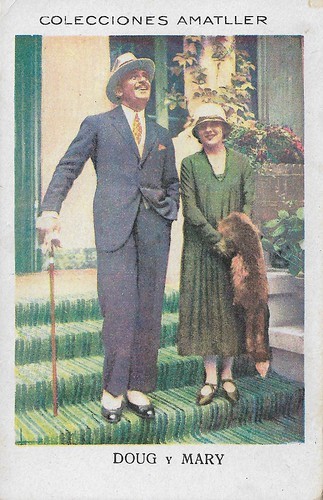
Spanish collectors card in the Collecciones Amatller Series, Serie A, artist no. 1 and 2, no. 8, by Chocolate Amatller.
Mary Pickford (1892-1979) was a legendary silent film actress and was known as 'America’s sweetheart.' She was the co-founder of United Artists and helped establish the AMPAS (Academy of Motion Pictures and Sciences). American actor Douglas Fairbanks (1883-1939) was best known for his swashbuckling roles in silent films such as The Mark of Zorro (1920), Robin Hood (1922), and The Thief of Bagdad (1924), but spent the early part of his career making comedies. Fairbanks was a founding member of United Artists and of The Motion Picture Academy. He hosted the first Oscars Ceremony in 1929. With his marriage to Mary Pickford in 1920, the couple became Hollywood royalty and Fairbanks was referred to as 'The King of Hollywood', but his career rapidly declined with the advent of the 'talkies'. He made his final film in Great Britain, The Private Life of Don Juan (1934).
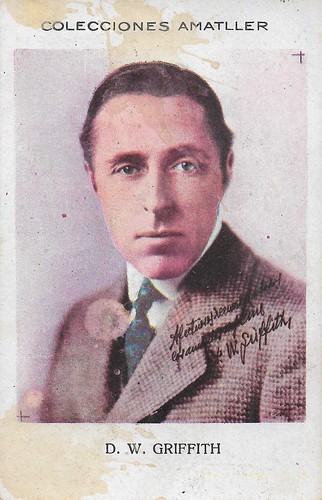
Spanish collectors card in the Collecciones Amatller Series, Serie B, artist no. 3, no. 10, by Chocolate Amatller.
David Wark Griffith (1875–1948) was an American director, writer, and producer who pioneered modern cinematic techniques. After shooting hundreds of shorts at Biograph, he made his mark with his features The Birth of a Nation (1915) and Intolerance (1916), both acclaimed for their radical camera and narrative techniques, while the first has also been condemned for its inherently racist philosophy. Several of Griffith's later films were also successful, including Broken Blossoms (1919), Way Down East (1920), and Orphans of the Storm (1921), but his high costs for production, promotion, and roadshow often made his ventures commercial failures. Griffith was one of the co-founders of United Artists and of AMPAS (Academy of Motion Pictures and Sciences).
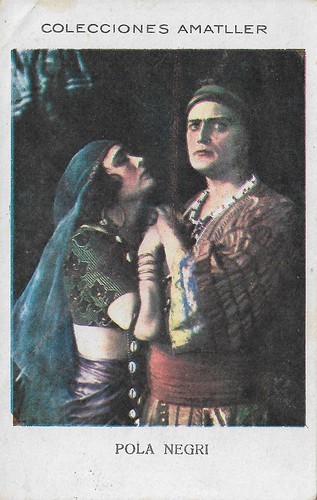
Spanish collectors card in the Collecciones Amatller Series, Series C, artist no. 4, no. 13, by Chocolate Amatller. Photo: Pola Negri and Harry Liedtke in the German silent film Sumurun (Ernst Lubitsch, 1920).
Ernst Lubitsch's silent film Sumurun tell the story of the favorite slave girl ( Jenny Hasselquist ) of a tyrannical sheik ( Paul Wegener ), who falls in love with a cloth merchant (Harry Liedtke). Meanwhile, a hunchback clown (Ernst Lubitsch himself) suffers unrequited love for a traveling dancer ( Pola Negri ) who wants to join the harem. Polish film actress Pola Negri (1897-1987) achieved notoriety as a femme fatale in German and American silent films between the 1910s and 1930s. German actor Harry Liedtke (1882-1945) was the charming ladykiller of many early silent classics. Detective serials like Joe Deebs made him one of the first male stars of the German cinema.
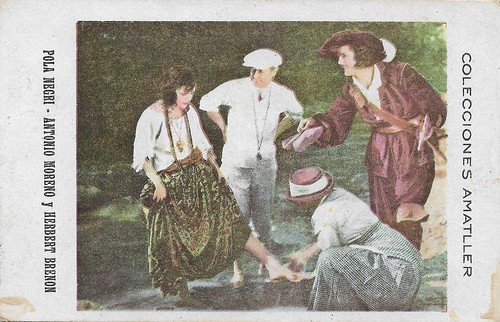
Spanish collectors card in the Collecciones Amatller Series, Series C, artist no. 4, no. 18, by Chocolate Amatller. Photo: Pola Negri , Antonio Moreno and director Herbert Brenon while shooting the silent film The Spanish Dancer (Herbert Brenon, 1923).
Polish film actress Pola Negri (1897-1987) achieved notoriety as a femme fatale in German and American silent films between the 1910s and 1930s. Antonio 'Tony' Moreno (1887-1967) was a Spanish-born American actor and film director of the silent film era and through the 1950s. In his early films, Moreno was often typecast as the 'Latin Lover'. He is best known for films such as The Spanish Dancer (1923), Mare Nostrum (1926) with Alice Terry, The Temptress (1926) with Greta Garbo , and It (1927) with Clara Bow.
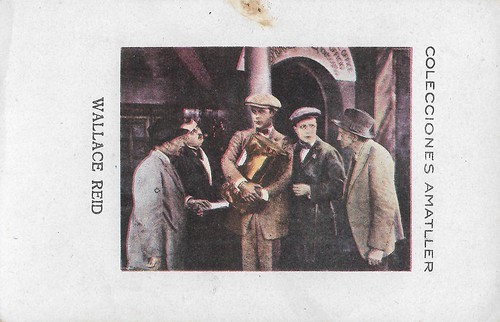
Spanish collectors card in the Collecciones Amatller Series, Series CC, artist 35, no. 77, by Chocolate Amatller. Photo: Wallace Reid and Harrison Ford in Hawthorne of the U.S.A. (James Cruze, 1919). It is one of the few surviving films with Reid.
Wallace Reid (1891–1923) was an American actor in silent film referred to as "the screen's most perfect lover". Born in a vaudeville family, he became an all-around athlete and gifted musician. When his father entered the film business in 1910, he brought along his teenage son, who debuted at Selig but soon rose to popularity at Vitagraph. After some 100 shorts and parts in films like Birth of a nation and Intolerance by Griffith, Paramount hired him for some 60 more films, including some dashing fast car films (Reid was so fond of racing, he even joined an Indianapolis race). By the 1920s, Reid was one of Hollywood's major heartthrobs. En route to Oregon for a film shooting in 1919, he was injured in a train wreck and took morphine to continue filming. This led to an addiction, which in the end killed him, in 1923, at the age of only 31. His wife, the actress Dorothy Davenport, afterward, did a national tour to warn against the dangers of drugs.
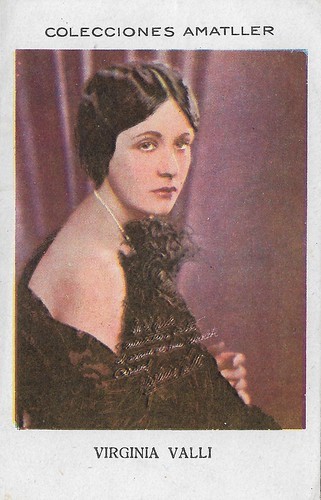
Spanish collectors card in the Collecciones Amatller Series, Series CCC, artist no. 69, no. 123, by Chocolate Amatller.
Virginia Valli (1895–1968) was an American stage and film actress whose motion picture career started in the silent film era and lasted until the beginning of the sound film era of the 1930s.
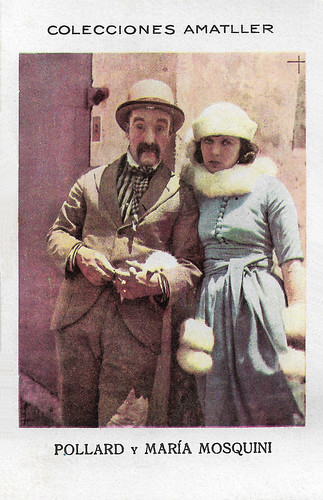
Spanish collectors card in the Collecciones Amatller Series, Serie CH, artist no. 6, no. 21, by Chocolate Amatller.
Australian born comedian Snub Pollard (1889-1962) with his walrus moustache was one of the well known faces of the Hal Roach company during the 1910s. His inseparable leading lady in many Hal Roach comedies was pert, slightly-built comedienne Maria Mosquini (1899-1983).
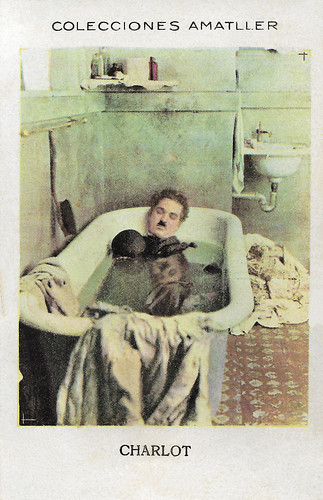
Spanish collectors card in the Collecciones Amatller Series, Serie D, artist no. 7, no. 26, by Chocolate Amatller. Photo: Charlie Chaplin in Pay Day (Charles Chaplin, 1922).
English comedian Charles ‘Charlie’ Chaplin (1889-1977) was one of the most creative and influential personalities of the silent-film era. His most famous role was that of The Tramp with his toothbrush mustache, undersized bowler hat and bamboo cane who struggled to survive while keeping his dignity in a world with great social injustice. Chaplin used mime, slapstick and other visual comedy routines, and he not only starred in his films, but also directed, wrote and produced them, and composed the music as well. His working life in entertainment spanned over 75 years, from the Victorian stage and the Music Hall in the United Kingdom as a child performer, until close to his death at the age of 88. Author George Bernard Shaw called Chaplin "the only genius to come out of the movie industry".
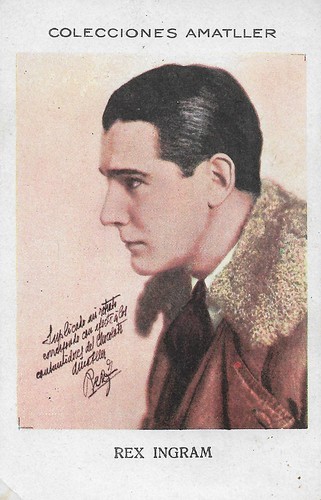
Spanish collectors card in the Collecciones Amatller Series, Series EE, artist no. 40, no. 82, by Chocolate Amatller.
Irish born Rex Ingram (1892-1950) was a film director, producer, writer and actor in Hollywood who was responsible for a succession of silent films for Metro Pictures, later M-G-M, that topped the box office and were hailed as masterpieces by the critics. He made a star of Rudolph Valentino with The Four Horsemen of the Apocalypse (1921). When they fell out, he found a new heartthrob in Ramon Novarro , who debuted with Ingram in The Prisoner of Zenda (1922). Rex’s second marriage, to Alice Terry, saw him cast her in the lead in all but one of his films. Director Erich von Stroheim once called him "the world's greatest director".
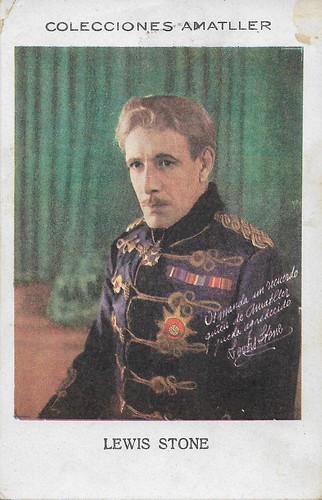
Spanish collectors card in the Collecciones Amatller Series, Series EE, artist no. 41, no. 83, by Chocolate Amatller. Photo: Lewis Stone in The Prisoner of Zenda (Rex Ingram, 1922).
Lewis Stone (1879–1953) was an American movie actor best known for his role as Judge James Hardy in the MGM Andy Hardy film series (1937-1946) and as a studio contract player. Stone had started acting in films in the mid-1910s. He was nominated for the Academy Award for Best Actor in 1929 for The Patriot. He appeared in seven films with Greta Garbo , including Grand Hotel (1932) and Queen Christina (1933), and also had a major part as the Warden in the Pre-Code movie The Big House (1930). After The Prisoner of Zenda, Stone did two more films with Rex Ingram : Trifling Women (1922) with Barbara La Marr and Ramon Novarro , and Scaramouche (1923) with Novarro and Alice Terry. Oddly enough two of his last parts were in remakes of Scaramouche and The Prisoner of Zenda, both 1952.
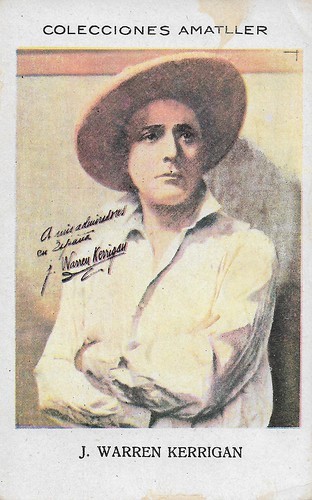
Spanish collectors card in the Collecciones Amatller Series, Series G, artist no. 10, no. 32, by Chocolate Amatller.
J. (Jack) Warren Kerrigan (1879-1947) was an American actor of the silent screen. From 1910, he had a most active career first in shorts at Essanay, American at Victor, then in features at Universal. After a gap in the early 1920s, he came back with a bang in James Cruze's The Covered Wagon (1923) but stopped acting in 1924 after a car accident.
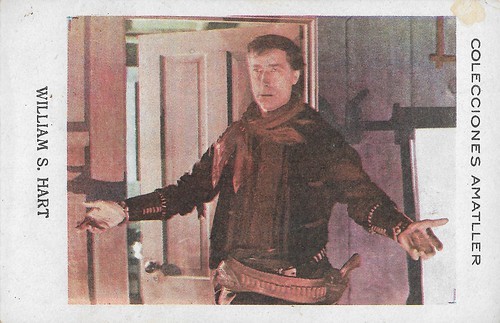
Spanish collectors card in the Collecciones Amatller Series, Series HH, artist no. 44, no. 87, by Chocolate Amatller. Photo: Amattler.
William S. [Surrey] Hart (1864–1946) was an American silent film actor, screenwriter, director, and producer. He entered films in 1914 where, after playing supporting roles in two short films, he achieved stardom as the lead in The Bargain (Reginald Barker, 1914), his first Western. He became a foremost Western star of the silent era who played characters with honor and integrity. Hart was particularly interested in making realistic Westerns, and his films are noted for their authentic costumes and props. Hart also had an extraordinary acting ability, honed on Shakespearean theatre stages in the United States and the UK.
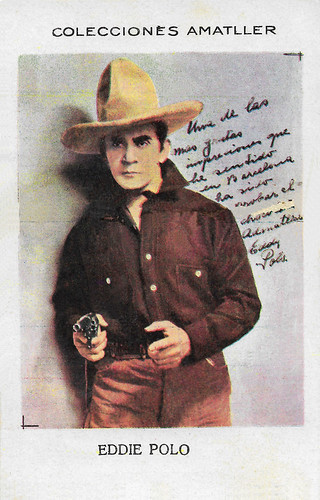
Spanish collectors card in the Collecciones Amatller Series, Serie I, Artista no. 12, no. 34, by Chocolate Amatller. Photo: Amattler.
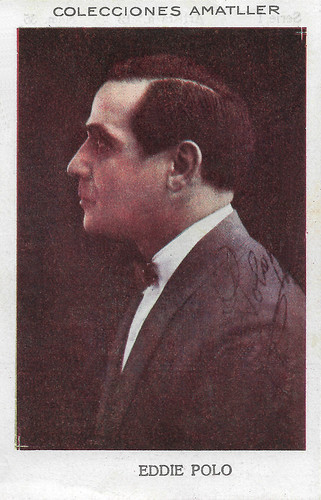
Spanish collectors card in the Collecciones Amatller Series, Serie I, artist no. 12, no. 35, by Chocolate Amatller. Photo: Amatller.
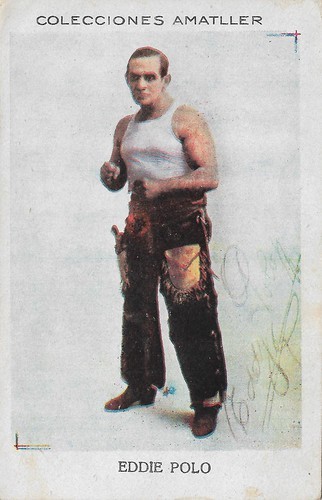
Spanish collectors card in the Collecciones Amatller Series, Series I, artist no. 12, no. 36, by Chocolate Amatller.
Eddie Polo (1875–1961) was an Austro-American actor of the silent era. He was born Edward W. Wyman or Weimer in Vienna, Austria-Hungary. With his brother Sam he was the trapeze act The Flying Cordovas. He was the first man to parachute off the Eiffel Tower. Beginning in 1913, he appeared in serials and films in the USA and as Cyclone Smith, he became a popular Western hero. During the late 1920s, he was an action star in the German silent cinema. After his acting career ended in the mid-1940s he worked as a makeup artist.
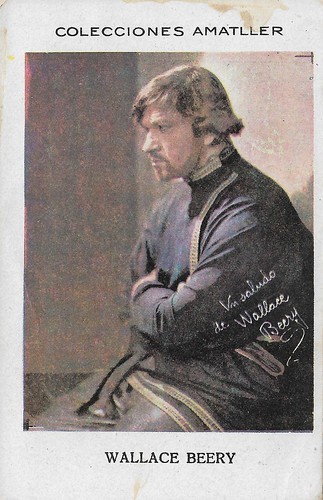
Spanish collectors card in the Collecciones Amatller Series, Series J, artist no. 13, no. 39, by Chocolate Amatller. Photo: Wallace Beery in Bavu (Stuart Paton, 1923).
American actor Wallace Beery (1885-1949) is best known for his portrayal of Bill in Min and Bill opposite Marie Dressler, as Long John Silver in Treasure Island, as Pancho Villa in Viva Villa!, and his titular role in The Champ, for which he won the Academy Award for Best Actor. Beery appeared in some 250 films in a 36-year career. He was the brother of actor Noah Beery, Sr. and uncle of actor Noah Beery, Jr.
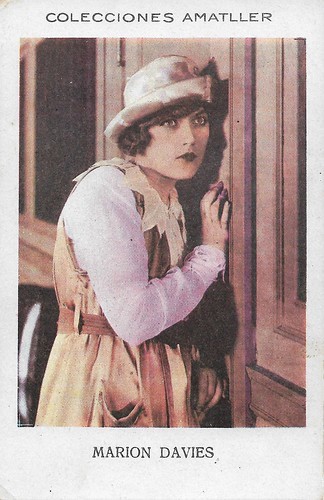
Spanish collectors card in the Collecciones Amatller Series, Series KK, artist no. 48, no. 94, by Chocolate Amatller.
Marion Davies (1897-1961) was one of the great comedic actresses of the silent era. She starred in nearly four dozen films between 1917 and 1937.
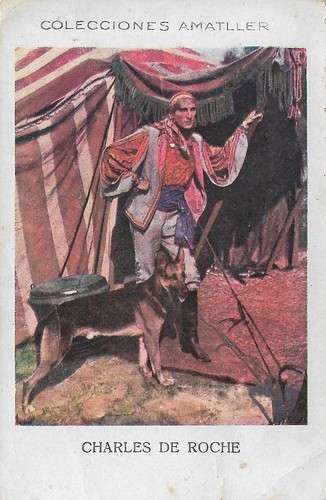
Spanish collectors card in the Collecciones Amatller Series, Series N, artist 19, no. 50, by Chocolate Amatller. Photo: Charles de Roche[fort] in Law of the Lawless (Victor Fleming, 1923).
Charles de Rochefort (1887-1952) was a star of the French silent cinema. He appeared in 34 films between 1911 and 1932. In 1923 he went to the US, where he was known as Charles de Roche and starred in several films in Hollywood, e.g. as pharaon Rameses in The Ten Commandments (DeMille 1923). After his return to France, he became a film director of sound films.
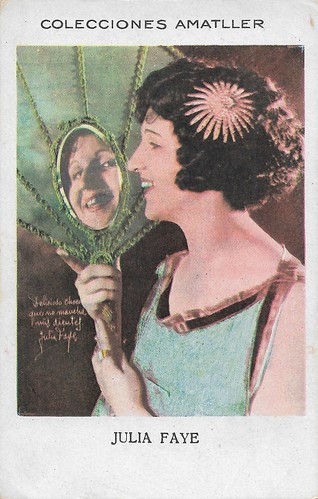
Spanish collectors card in the Collecciones Amatller Series, Series NN, artist no. 54, no. 100, by Chocolate Amatller.
Julia Faye (1892–1966) was an American film actress. Her career is inextricably linked to director Cecil B. DeMille. He was her mentor, while she was for many years his mistress. Their liaison was tolerated by De Mille's long-suffering wife Constance Adams. She was featured in billed supporting roles in a number of De Mille's big-budget extravaganzas, including The Ten Commandments (1923) (as Pharaoh's wife), The Volga Boatsman (1926) (as a gypsy) and The King of Kings (1927) (as Martha).
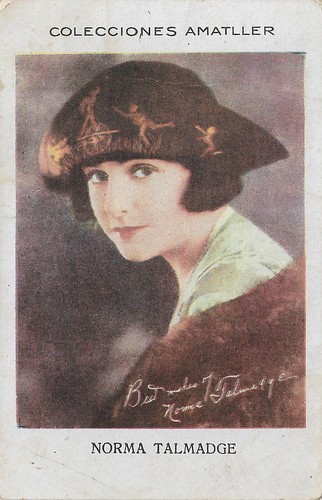
Spanish collectors card in the Collecciones Amatller Series, Series QQ, artist no. 58, no. 106, by Chocolate Amatller.
Norma Talmadge (1894–1957) was an American actress and film producer of the silent era. A major box-office draw for more than a decade, her career reached a peak in the early 1920s, when she ranked among the most popular idols of the American screen.
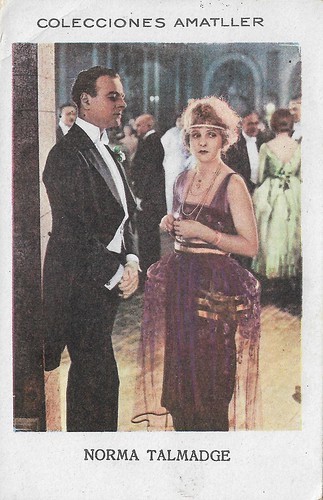
Spanish collectors card in the Collecciones Amatller Series, Series QQ, artist no. 58, no. 107, by Chocolate Amatller. Photo: Norma Talmadge and Lowell Sherman in Yes or No? (Roy William Neill, 1920).
Norma Talmadge (1894–1957) was an American actress and film producer of the silent era. A major box-office draw for more than a decade, her career reached a peak in the early 1920s, when she ranked among the most popular idols of the American screen.
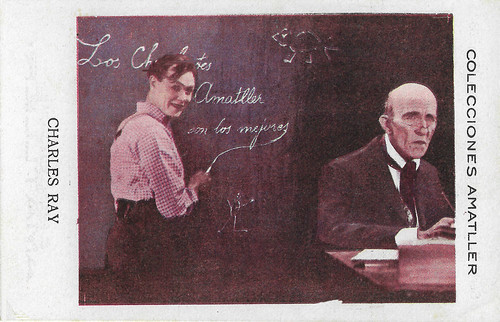
Spanish collectors card in the Collecciones Amatller Series, Serie X, artist no. 28, no. 63, by Chocolate Amatller. Photo: United Artists. Charles Ray and Lon Poff in The Old Swimmin' Hole (Joe de Grasse, 1921).
Charles Ray (1891-1943) was an American actor, scriptwriter, and director of the silent screen, who knew a parabole from rags to riches and back again. He worked for Paramount, his own company, United Artists and MGM. In the late 1910s and early 1920s, he was a very popular actor and one of Hollywood's best-paid stars.

Spanish collectors card in the Collecciones Amatller Series, Serie A, artist no. 1 and 2, no. 8, by Chocolate Amatller.
Mary Pickford (1892-1979) was a legendary silent film actress and was known as 'America’s sweetheart.' She was the co-founder of United Artists and helped establish the AMPAS (Academy of Motion Pictures and Sciences). American actor Douglas Fairbanks (1883-1939) was best known for his swashbuckling roles in silent films such as The Mark of Zorro (1920), Robin Hood (1922), and The Thief of Bagdad (1924), but spent the early part of his career making comedies. Fairbanks was a founding member of United Artists and of The Motion Picture Academy. He hosted the first Oscars Ceremony in 1929. With his marriage to Mary Pickford in 1920, the couple became Hollywood royalty and Fairbanks was referred to as 'The King of Hollywood', but his career rapidly declined with the advent of the 'talkies'. He made his final film in Great Britain, The Private Life of Don Juan (1934).

Spanish collectors card in the Collecciones Amatller Series, Serie B, artist no. 3, no. 10, by Chocolate Amatller.
David Wark Griffith (1875–1948) was an American director, writer, and producer who pioneered modern cinematic techniques. After shooting hundreds of shorts at Biograph, he made his mark with his features The Birth of a Nation (1915) and Intolerance (1916), both acclaimed for their radical camera and narrative techniques, while the first has also been condemned for its inherently racist philosophy. Several of Griffith's later films were also successful, including Broken Blossoms (1919), Way Down East (1920), and Orphans of the Storm (1921), but his high costs for production, promotion, and roadshow often made his ventures commercial failures. Griffith was one of the co-founders of United Artists and of AMPAS (Academy of Motion Pictures and Sciences).

Spanish collectors card in the Collecciones Amatller Series, Series C, artist no. 4, no. 13, by Chocolate Amatller. Photo: Pola Negri and Harry Liedtke in the German silent film Sumurun (Ernst Lubitsch, 1920).
Ernst Lubitsch's silent film Sumurun tell the story of the favorite slave girl ( Jenny Hasselquist ) of a tyrannical sheik ( Paul Wegener ), who falls in love with a cloth merchant (Harry Liedtke). Meanwhile, a hunchback clown (Ernst Lubitsch himself) suffers unrequited love for a traveling dancer ( Pola Negri ) who wants to join the harem. Polish film actress Pola Negri (1897-1987) achieved notoriety as a femme fatale in German and American silent films between the 1910s and 1930s. German actor Harry Liedtke (1882-1945) was the charming ladykiller of many early silent classics. Detective serials like Joe Deebs made him one of the first male stars of the German cinema.

Spanish collectors card in the Collecciones Amatller Series, Series C, artist no. 4, no. 18, by Chocolate Amatller. Photo: Pola Negri , Antonio Moreno and director Herbert Brenon while shooting the silent film The Spanish Dancer (Herbert Brenon, 1923).
Polish film actress Pola Negri (1897-1987) achieved notoriety as a femme fatale in German and American silent films between the 1910s and 1930s. Antonio 'Tony' Moreno (1887-1967) was a Spanish-born American actor and film director of the silent film era and through the 1950s. In his early films, Moreno was often typecast as the 'Latin Lover'. He is best known for films such as The Spanish Dancer (1923), Mare Nostrum (1926) with Alice Terry, The Temptress (1926) with Greta Garbo , and It (1927) with Clara Bow.

Spanish collectors card in the Collecciones Amatller Series, Series CC, artist 35, no. 77, by Chocolate Amatller. Photo: Wallace Reid and Harrison Ford in Hawthorne of the U.S.A. (James Cruze, 1919). It is one of the few surviving films with Reid.
Wallace Reid (1891–1923) was an American actor in silent film referred to as "the screen's most perfect lover". Born in a vaudeville family, he became an all-around athlete and gifted musician. When his father entered the film business in 1910, he brought along his teenage son, who debuted at Selig but soon rose to popularity at Vitagraph. After some 100 shorts and parts in films like Birth of a nation and Intolerance by Griffith, Paramount hired him for some 60 more films, including some dashing fast car films (Reid was so fond of racing, he even joined an Indianapolis race). By the 1920s, Reid was one of Hollywood's major heartthrobs. En route to Oregon for a film shooting in 1919, he was injured in a train wreck and took morphine to continue filming. This led to an addiction, which in the end killed him, in 1923, at the age of only 31. His wife, the actress Dorothy Davenport, afterward, did a national tour to warn against the dangers of drugs.

Spanish collectors card in the Collecciones Amatller Series, Series CCC, artist no. 69, no. 123, by Chocolate Amatller.
Virginia Valli (1895–1968) was an American stage and film actress whose motion picture career started in the silent film era and lasted until the beginning of the sound film era of the 1930s.

Spanish collectors card in the Collecciones Amatller Series, Serie CH, artist no. 6, no. 21, by Chocolate Amatller.
Australian born comedian Snub Pollard (1889-1962) with his walrus moustache was one of the well known faces of the Hal Roach company during the 1910s. His inseparable leading lady in many Hal Roach comedies was pert, slightly-built comedienne Maria Mosquini (1899-1983).

Spanish collectors card in the Collecciones Amatller Series, Serie D, artist no. 7, no. 26, by Chocolate Amatller. Photo: Charlie Chaplin in Pay Day (Charles Chaplin, 1922).
English comedian Charles ‘Charlie’ Chaplin (1889-1977) was one of the most creative and influential personalities of the silent-film era. His most famous role was that of The Tramp with his toothbrush mustache, undersized bowler hat and bamboo cane who struggled to survive while keeping his dignity in a world with great social injustice. Chaplin used mime, slapstick and other visual comedy routines, and he not only starred in his films, but also directed, wrote and produced them, and composed the music as well. His working life in entertainment spanned over 75 years, from the Victorian stage and the Music Hall in the United Kingdom as a child performer, until close to his death at the age of 88. Author George Bernard Shaw called Chaplin "the only genius to come out of the movie industry".

Spanish collectors card in the Collecciones Amatller Series, Series EE, artist no. 40, no. 82, by Chocolate Amatller.
Irish born Rex Ingram (1892-1950) was a film director, producer, writer and actor in Hollywood who was responsible for a succession of silent films for Metro Pictures, later M-G-M, that topped the box office and were hailed as masterpieces by the critics. He made a star of Rudolph Valentino with The Four Horsemen of the Apocalypse (1921). When they fell out, he found a new heartthrob in Ramon Novarro , who debuted with Ingram in The Prisoner of Zenda (1922). Rex’s second marriage, to Alice Terry, saw him cast her in the lead in all but one of his films. Director Erich von Stroheim once called him "the world's greatest director".

Spanish collectors card in the Collecciones Amatller Series, Series EE, artist no. 41, no. 83, by Chocolate Amatller. Photo: Lewis Stone in The Prisoner of Zenda (Rex Ingram, 1922).
Lewis Stone (1879–1953) was an American movie actor best known for his role as Judge James Hardy in the MGM Andy Hardy film series (1937-1946) and as a studio contract player. Stone had started acting in films in the mid-1910s. He was nominated for the Academy Award for Best Actor in 1929 for The Patriot. He appeared in seven films with Greta Garbo , including Grand Hotel (1932) and Queen Christina (1933), and also had a major part as the Warden in the Pre-Code movie The Big House (1930). After The Prisoner of Zenda, Stone did two more films with Rex Ingram : Trifling Women (1922) with Barbara La Marr and Ramon Novarro , and Scaramouche (1923) with Novarro and Alice Terry. Oddly enough two of his last parts were in remakes of Scaramouche and The Prisoner of Zenda, both 1952.

Spanish collectors card in the Collecciones Amatller Series, Series G, artist no. 10, no. 32, by Chocolate Amatller.
J. (Jack) Warren Kerrigan (1879-1947) was an American actor of the silent screen. From 1910, he had a most active career first in shorts at Essanay, American at Victor, then in features at Universal. After a gap in the early 1920s, he came back with a bang in James Cruze's The Covered Wagon (1923) but stopped acting in 1924 after a car accident.

Spanish collectors card in the Collecciones Amatller Series, Series HH, artist no. 44, no. 87, by Chocolate Amatller. Photo: Amattler.
William S. [Surrey] Hart (1864–1946) was an American silent film actor, screenwriter, director, and producer. He entered films in 1914 where, after playing supporting roles in two short films, he achieved stardom as the lead in The Bargain (Reginald Barker, 1914), his first Western. He became a foremost Western star of the silent era who played characters with honor and integrity. Hart was particularly interested in making realistic Westerns, and his films are noted for their authentic costumes and props. Hart also had an extraordinary acting ability, honed on Shakespearean theatre stages in the United States and the UK.

Spanish collectors card in the Collecciones Amatller Series, Serie I, Artista no. 12, no. 34, by Chocolate Amatller. Photo: Amattler.

Spanish collectors card in the Collecciones Amatller Series, Serie I, artist no. 12, no. 35, by Chocolate Amatller. Photo: Amatller.

Spanish collectors card in the Collecciones Amatller Series, Series I, artist no. 12, no. 36, by Chocolate Amatller.
Eddie Polo (1875–1961) was an Austro-American actor of the silent era. He was born Edward W. Wyman or Weimer in Vienna, Austria-Hungary. With his brother Sam he was the trapeze act The Flying Cordovas. He was the first man to parachute off the Eiffel Tower. Beginning in 1913, he appeared in serials and films in the USA and as Cyclone Smith, he became a popular Western hero. During the late 1920s, he was an action star in the German silent cinema. After his acting career ended in the mid-1940s he worked as a makeup artist.

Spanish collectors card in the Collecciones Amatller Series, Series J, artist no. 13, no. 39, by Chocolate Amatller. Photo: Wallace Beery in Bavu (Stuart Paton, 1923).
American actor Wallace Beery (1885-1949) is best known for his portrayal of Bill in Min and Bill opposite Marie Dressler, as Long John Silver in Treasure Island, as Pancho Villa in Viva Villa!, and his titular role in The Champ, for which he won the Academy Award for Best Actor. Beery appeared in some 250 films in a 36-year career. He was the brother of actor Noah Beery, Sr. and uncle of actor Noah Beery, Jr.

Spanish collectors card in the Collecciones Amatller Series, Series KK, artist no. 48, no. 94, by Chocolate Amatller.
Marion Davies (1897-1961) was one of the great comedic actresses of the silent era. She starred in nearly four dozen films between 1917 and 1937.

Spanish collectors card in the Collecciones Amatller Series, Series N, artist 19, no. 50, by Chocolate Amatller. Photo: Charles de Roche[fort] in Law of the Lawless (Victor Fleming, 1923).
Charles de Rochefort (1887-1952) was a star of the French silent cinema. He appeared in 34 films between 1911 and 1932. In 1923 he went to the US, where he was known as Charles de Roche and starred in several films in Hollywood, e.g. as pharaon Rameses in The Ten Commandments (DeMille 1923). After his return to France, he became a film director of sound films.

Spanish collectors card in the Collecciones Amatller Series, Series NN, artist no. 54, no. 100, by Chocolate Amatller.
Julia Faye (1892–1966) was an American film actress. Her career is inextricably linked to director Cecil B. DeMille. He was her mentor, while she was for many years his mistress. Their liaison was tolerated by De Mille's long-suffering wife Constance Adams. She was featured in billed supporting roles in a number of De Mille's big-budget extravaganzas, including The Ten Commandments (1923) (as Pharaoh's wife), The Volga Boatsman (1926) (as a gypsy) and The King of Kings (1927) (as Martha).

Spanish collectors card in the Collecciones Amatller Series, Series QQ, artist no. 58, no. 106, by Chocolate Amatller.
Norma Talmadge (1894–1957) was an American actress and film producer of the silent era. A major box-office draw for more than a decade, her career reached a peak in the early 1920s, when she ranked among the most popular idols of the American screen.

Spanish collectors card in the Collecciones Amatller Series, Series QQ, artist no. 58, no. 107, by Chocolate Amatller. Photo: Norma Talmadge and Lowell Sherman in Yes or No? (Roy William Neill, 1920).
Norma Talmadge (1894–1957) was an American actress and film producer of the silent era. A major box-office draw for more than a decade, her career reached a peak in the early 1920s, when she ranked among the most popular idols of the American screen.

Spanish collectors card in the Collecciones Amatller Series, Serie X, artist no. 28, no. 63, by Chocolate Amatller. Photo: United Artists. Charles Ray and Lon Poff in The Old Swimmin' Hole (Joe de Grasse, 1921).
Charles Ray (1891-1943) was an American actor, scriptwriter, and director of the silent screen, who knew a parabole from rags to riches and back again. He worked for Paramount, his own company, United Artists and MGM. In the late 1910s and early 1920s, he was a very popular actor and one of Hollywood's best-paid stars.
Published on September 06, 2019 22:00
September 5, 2019
Charles Bickford
Charles Bickford (1891-1967) was an American character actor of gruff voice and appearance. He was nominated three times for the Academy Award for Best Supporting Actor, for The Song of Bernadette (1943), The Farmer's Daughter (1947), and Johnny Belinda (1948). Other notable roles include Anna Christie (1930), Whirlpool (1948), A Star is Born (1954), and The Big Country (1958).
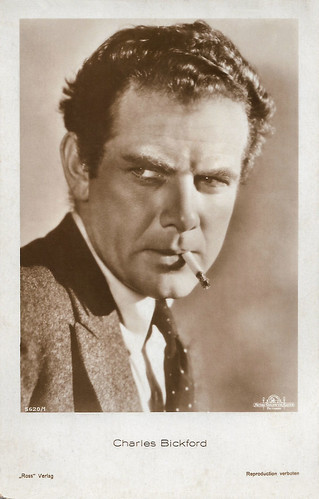
German postcard by Ross Verlag, no. 5620/1, 1930-1931. Photo: Metro-Goldwyn-Mayer.
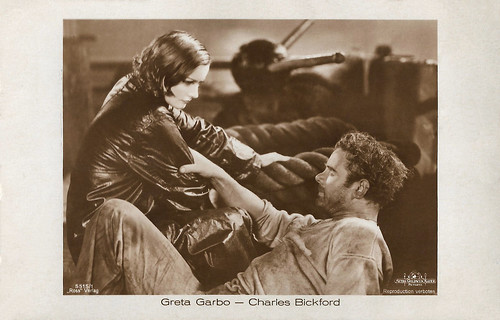
German postcard by Ross Verlag, no. 5515/1. Photo: MGM. Greta Garbo and Charles Bickford in Anna Christie (Clarence Brown, 1930).
Tried and acquitted of the attempted murder at age nine
Charles Ambrose Bickford was born in Cambridge, Massachusetts, during the first minute of 1891. His parents were Loretus and Mary Ellen Bickford. The fifth of seven children, he was an intelligent but very independent and unruly child. He had a particularly strong relationship with his maternal grandfather, a sea captain who was a powerful influence during his formative years.
At the age of nine, he was tried and acquitted of the attempted murder in the shooting of a trolley motorman who had callously driven over and killed his beloved dog. He attended Foster School and Everett High School. Always more interested in experiencing life than reading about it, Bickford was considered 'the wild rogue' of this family, causing his parents frequent consternation.
In his late teens, he drifted aimlessly around the United States for a time. Bickford had intended to attend the Massachusetts Institute of Technology to earn an engineering degree, but while wandering around the country, he became friends with the manager of a burlesque show, who convinced Bickford to take a role in the show. He debuted in Oakland, California, in 1911.
Before breaking into acting, he worked as a lumberjack and investment promoter and, for a short time, ran a pest extermination business. He also was a stoker and fireman in the United States Navy. His first entry into acting was on the stage, eventually including Broadway. This venue provided him with an occasional living and served as the principal training ground for developing his acting and vocal talents. Bickford enjoyed himself so much that he abandoned his plans to attend M.I.T.
He made his legitimate stage debut with the John Craig Stock Company at the Castle Square Theatre in Boston in 1912. During World War I, Bickford served as an engineer lieutenant in the United States Army. He eventually joined a road company and travelled throughout the United States for more than a decade, appearing in various productions.
In 1925, while working in a Broadway play called 'Outside Looking In', he and co-star James Cagney (in his first Broadway role) received rave reviews. The play was a smash hit, and Bickford was offered a role in the film Beau Geste (Herbert Brenon, 1926). Anxious not to give up his new found Broadway stardom, he turned it down, a decision he later regretted. Following his appearance in the critically praised but unsuccessful Maxwell Anderson-Harold Hickerson drama about the Sacco and Vanzetti case, 'Gods of the Lightning' (Bickford was the Sacco character), Bickford was contacted by filmmaker Cecil B. DeMille.
He was offered a contract with Metro-Goldwyn-Mayer to star in DeMille's first talking picture, Dynamite (Cecil B. DeMille, 1929), co-starring Conrad Nagel and Kay Johnson. Bickford played a coal miner Hagon Derk, who is sentenced to hang for murder. According to The New York Times reviewer Mordaunt Hall, Bickford gave "a splendid performance". Soon he began working with MGM studio head Louis B. Mayer on a number of projects.
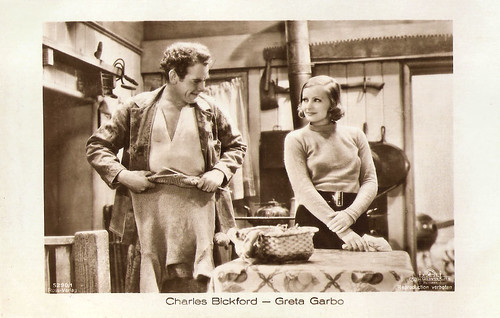
German postcard by Ross Verlag, no. 5290/1, 1930-1931. Photo: MGM. Greta Garbo and Charles Bickford in Anna Christie (Clarence Brown, 1930).
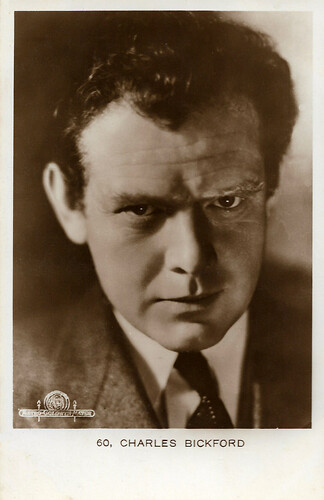
Belgian postcard by P.I.A. Belga Phot., Bruxelles, no. 60. Photo: Metro-Goldwyn-Mayer.
Mauled by a 400-pound lion
Charles Bickford soon became a star after playing Greta Garbo 's lover in Anna Christie (Clarence Brown, 1930) but he never developed into a leading man. Always of independent mind, exceptionally strong-willed and quick with his fists, Bickford would frequently argue and nearly come to blows with Mayer and any number of other MGM authority figures during the course of this contract with the studio.
During the production of DeMille's Dynamite, he punched out his director following a string of heated arguments primarily, but not exclusively, related to the interpretation of his character's role. Throughout his early career on both the stage and later films Bickford rejected numerous scripts and made no secret of his disdain for much of the material he was offered.
Not surprisingly, his association with MGM was short-lived, with Bickford asking for and quickly receiving a release from his contract. However, he soon found himself blacklisted at other studios, forcing him to take the highly unusual step (for that era) of becoming an independent actor for several years.
His career took another turn in 1935. While rehearsing a scene for Universal's East of Java (George Melford, 1935), he was mauled by a 400-pound lion on his neck and shoulders, very close to his jugular vein. it required nearly a year for him to recover from the injuries. While he recovered, he lost his contract with Fox as well as his leading-man status owing to extensive neck scarring suffered in the attack coupled with his advancing age.
It was not long, however, before he made a very successful transition to character roles, which he felt offered much greater diversity and allowed him to showcase his talent to better effect. Much preferring the character roles that now became his forte, Bickford appeared in many notable films, including The Farmer's Daughter (H.C. Potter, 1947) with Loretta Young, Johnny Belinda (Jean Negulesco, 1948) starring Jane Wyman, A Star is Born (George Cukor, 1954) starring Judy Garland and James Mason , and Not As a Stranger (Stanley Kramer, 1955), starring Olivia de Havilland , Robert Mitchum , and Frank Sinatra.
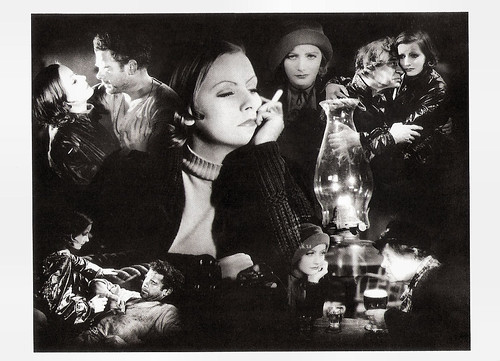
Swiss postcard by News Productions, Baulmes, no. 56490. Photo: Cinémathèque Suisse / Metro-Goldwyn-Mayer. Greta Garbo and Charles Bickford in Anna Christie (Clarence Brown, 1930). Design: Clarence Sinclair Bull, 1930.
Bulls Balls Bicycles & Actors
Finding great success playing an array of character roles in films and later in television, Charles Bickford quickly became highly sought after. His burly frame and craggy, intense features, coupled with a gruff, powerful voice lent themselves to a wide variety of roles. Most often he played lovable father figures, stern businessmen, heavies, ship captains or authority figures of some sort.
During the 1940s, he was nominated three times for the Academy Award for Best Supporting Actor, for The Song of Bernadette (Henry King, 1943) featuring Jennifer Jones, The Farmer's Daughter (H.C. Potter, 1947), and Johnny Belinda (Jean Negulesco, 1948).
In the 1950s, he served as host of the television series The Man Behind the Badge (1955). Bickford continued to act in generally prestigious projects right up to his death. He guest-starred on TV series like The Islanders (1960), The Barbara Stanwyck Show (1960), and The Eleventh Hour (1963).
In his final years, Bickford played rancher John Grainger, owner of the Shiloh Ranch, on the Western series The Virginian (1962-1968) with Doug McClure. Two of the actor's most memorable late-career big-screen roles were a wealthy and ruthless rancher in the Western The Big Country (William Wyler, 1958) starring Gregory Peck and Jean Simmons , and the forlorn father of an alcoholic (played by Lee Remick) in the drama Days of Wine and Roses (Blake Edwards, 1962).
In 1965, Bickford published his autobiography, 'Bulls Balls Bicycles & Actors'. In 1967, Charles Bickford died in Los Angeles of pneumonia and a blood infection at the age of 76. Jennifer Jones, who was a close friend of Bickford, attempted suicide on the day of his death, but it is not clear if Bickford's death had anything to do with the attempt. Since 1916, he had been married to Beatrice Loring. They had a son, Rex, and a daughter, Doris.
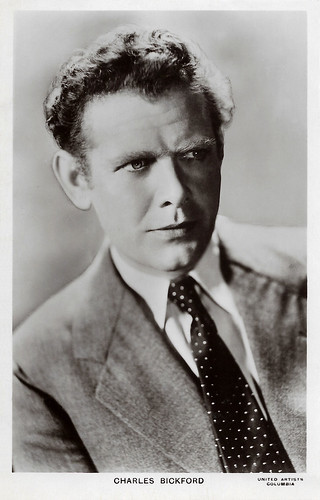
British postcard in the Picturegoer Series, London, no. 744. Photo: United Artists / Columbia.
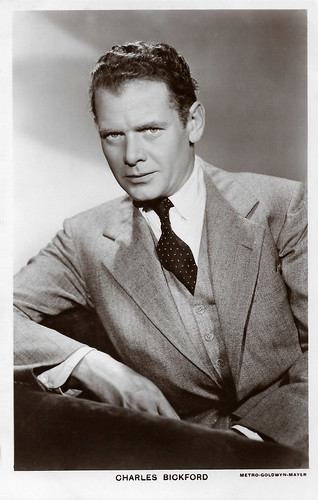
British postcard in the Picturegoer Series, London, no. 744a. Photo: Metro-Goldwyn-Mayer (MGM).
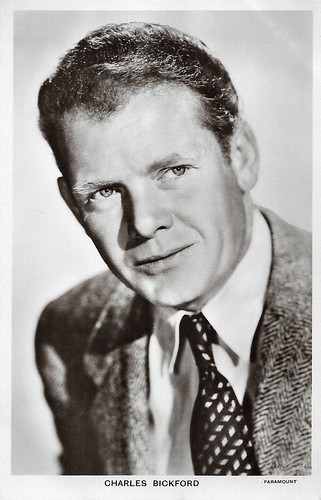
British postcard in the Picturegoer Series, London, no. 744b. Photo: Paramount.
Sources: (IMDb), Mordaunt Hall (New York Times), Wikipedia and .

German postcard by Ross Verlag, no. 5620/1, 1930-1931. Photo: Metro-Goldwyn-Mayer.

German postcard by Ross Verlag, no. 5515/1. Photo: MGM. Greta Garbo and Charles Bickford in Anna Christie (Clarence Brown, 1930).
Tried and acquitted of the attempted murder at age nine
Charles Ambrose Bickford was born in Cambridge, Massachusetts, during the first minute of 1891. His parents were Loretus and Mary Ellen Bickford. The fifth of seven children, he was an intelligent but very independent and unruly child. He had a particularly strong relationship with his maternal grandfather, a sea captain who was a powerful influence during his formative years.
At the age of nine, he was tried and acquitted of the attempted murder in the shooting of a trolley motorman who had callously driven over and killed his beloved dog. He attended Foster School and Everett High School. Always more interested in experiencing life than reading about it, Bickford was considered 'the wild rogue' of this family, causing his parents frequent consternation.
In his late teens, he drifted aimlessly around the United States for a time. Bickford had intended to attend the Massachusetts Institute of Technology to earn an engineering degree, but while wandering around the country, he became friends with the manager of a burlesque show, who convinced Bickford to take a role in the show. He debuted in Oakland, California, in 1911.
Before breaking into acting, he worked as a lumberjack and investment promoter and, for a short time, ran a pest extermination business. He also was a stoker and fireman in the United States Navy. His first entry into acting was on the stage, eventually including Broadway. This venue provided him with an occasional living and served as the principal training ground for developing his acting and vocal talents. Bickford enjoyed himself so much that he abandoned his plans to attend M.I.T.
He made his legitimate stage debut with the John Craig Stock Company at the Castle Square Theatre in Boston in 1912. During World War I, Bickford served as an engineer lieutenant in the United States Army. He eventually joined a road company and travelled throughout the United States for more than a decade, appearing in various productions.
In 1925, while working in a Broadway play called 'Outside Looking In', he and co-star James Cagney (in his first Broadway role) received rave reviews. The play was a smash hit, and Bickford was offered a role in the film Beau Geste (Herbert Brenon, 1926). Anxious not to give up his new found Broadway stardom, he turned it down, a decision he later regretted. Following his appearance in the critically praised but unsuccessful Maxwell Anderson-Harold Hickerson drama about the Sacco and Vanzetti case, 'Gods of the Lightning' (Bickford was the Sacco character), Bickford was contacted by filmmaker Cecil B. DeMille.
He was offered a contract with Metro-Goldwyn-Mayer to star in DeMille's first talking picture, Dynamite (Cecil B. DeMille, 1929), co-starring Conrad Nagel and Kay Johnson. Bickford played a coal miner Hagon Derk, who is sentenced to hang for murder. According to The New York Times reviewer Mordaunt Hall, Bickford gave "a splendid performance". Soon he began working with MGM studio head Louis B. Mayer on a number of projects.

German postcard by Ross Verlag, no. 5290/1, 1930-1931. Photo: MGM. Greta Garbo and Charles Bickford in Anna Christie (Clarence Brown, 1930).

Belgian postcard by P.I.A. Belga Phot., Bruxelles, no. 60. Photo: Metro-Goldwyn-Mayer.
Mauled by a 400-pound lion
Charles Bickford soon became a star after playing Greta Garbo 's lover in Anna Christie (Clarence Brown, 1930) but he never developed into a leading man. Always of independent mind, exceptionally strong-willed and quick with his fists, Bickford would frequently argue and nearly come to blows with Mayer and any number of other MGM authority figures during the course of this contract with the studio.
During the production of DeMille's Dynamite, he punched out his director following a string of heated arguments primarily, but not exclusively, related to the interpretation of his character's role. Throughout his early career on both the stage and later films Bickford rejected numerous scripts and made no secret of his disdain for much of the material he was offered.
Not surprisingly, his association with MGM was short-lived, with Bickford asking for and quickly receiving a release from his contract. However, he soon found himself blacklisted at other studios, forcing him to take the highly unusual step (for that era) of becoming an independent actor for several years.
His career took another turn in 1935. While rehearsing a scene for Universal's East of Java (George Melford, 1935), he was mauled by a 400-pound lion on his neck and shoulders, very close to his jugular vein. it required nearly a year for him to recover from the injuries. While he recovered, he lost his contract with Fox as well as his leading-man status owing to extensive neck scarring suffered in the attack coupled with his advancing age.
It was not long, however, before he made a very successful transition to character roles, which he felt offered much greater diversity and allowed him to showcase his talent to better effect. Much preferring the character roles that now became his forte, Bickford appeared in many notable films, including The Farmer's Daughter (H.C. Potter, 1947) with Loretta Young, Johnny Belinda (Jean Negulesco, 1948) starring Jane Wyman, A Star is Born (George Cukor, 1954) starring Judy Garland and James Mason , and Not As a Stranger (Stanley Kramer, 1955), starring Olivia de Havilland , Robert Mitchum , and Frank Sinatra.

Swiss postcard by News Productions, Baulmes, no. 56490. Photo: Cinémathèque Suisse / Metro-Goldwyn-Mayer. Greta Garbo and Charles Bickford in Anna Christie (Clarence Brown, 1930). Design: Clarence Sinclair Bull, 1930.
Bulls Balls Bicycles & Actors
Finding great success playing an array of character roles in films and later in television, Charles Bickford quickly became highly sought after. His burly frame and craggy, intense features, coupled with a gruff, powerful voice lent themselves to a wide variety of roles. Most often he played lovable father figures, stern businessmen, heavies, ship captains or authority figures of some sort.
During the 1940s, he was nominated three times for the Academy Award for Best Supporting Actor, for The Song of Bernadette (Henry King, 1943) featuring Jennifer Jones, The Farmer's Daughter (H.C. Potter, 1947), and Johnny Belinda (Jean Negulesco, 1948).
In the 1950s, he served as host of the television series The Man Behind the Badge (1955). Bickford continued to act in generally prestigious projects right up to his death. He guest-starred on TV series like The Islanders (1960), The Barbara Stanwyck Show (1960), and The Eleventh Hour (1963).
In his final years, Bickford played rancher John Grainger, owner of the Shiloh Ranch, on the Western series The Virginian (1962-1968) with Doug McClure. Two of the actor's most memorable late-career big-screen roles were a wealthy and ruthless rancher in the Western The Big Country (William Wyler, 1958) starring Gregory Peck and Jean Simmons , and the forlorn father of an alcoholic (played by Lee Remick) in the drama Days of Wine and Roses (Blake Edwards, 1962).
In 1965, Bickford published his autobiography, 'Bulls Balls Bicycles & Actors'. In 1967, Charles Bickford died in Los Angeles of pneumonia and a blood infection at the age of 76. Jennifer Jones, who was a close friend of Bickford, attempted suicide on the day of his death, but it is not clear if Bickford's death had anything to do with the attempt. Since 1916, he had been married to Beatrice Loring. They had a son, Rex, and a daughter, Doris.

British postcard in the Picturegoer Series, London, no. 744. Photo: United Artists / Columbia.

British postcard in the Picturegoer Series, London, no. 744a. Photo: Metro-Goldwyn-Mayer (MGM).

British postcard in the Picturegoer Series, London, no. 744b. Photo: Paramount.
Sources: (IMDb), Mordaunt Hall (New York Times), Wikipedia and .
Published on September 05, 2019 22:00
September 4, 2019
A passionate love doomed to fail
In the last post in our summer series on recent film books, EFSP has another Dutch curiosity. A novel about a legendary diva of the international opera houses who had vowed never to marry, who meets a heartbreaker with the angelic face that caused a furore on the stage. In 'De eerste vrouw' (The First Woman, 2016), Susan Smit depicts the tumultuous and love story between the American Geraldine Ferrar and the Dutchman Lou Tellegen, who starred together in three silent Hollywood films. Smit based her exciting novel on historical factual material.
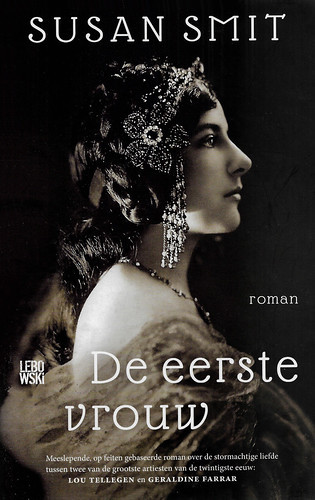
Book cover for Susan Smit, 'De eerste vrouw' (2016). Publisher: Lebowski, Amsterdam.
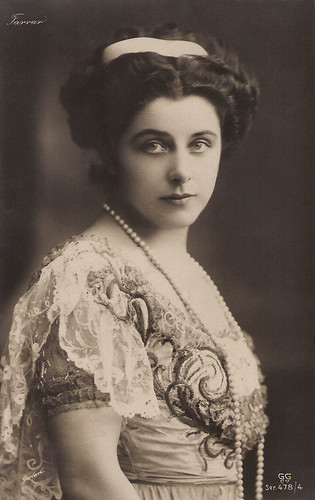
German postcard by G.G. & Co., no. 478/4. Photo: Gerlach.
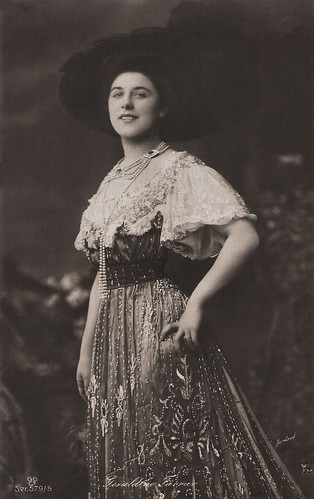
German postcard by G.G. & Co., no. 579/5. Photo: Gerlach.
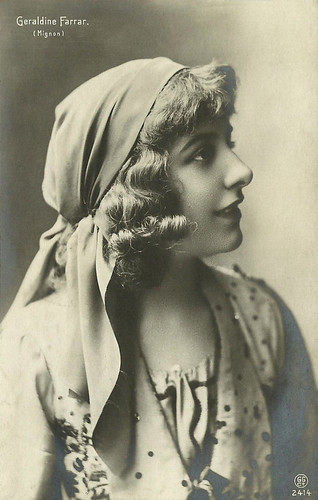
German postcard by G.G. & Co., no. 2414. Photo: Photo: Geraldine Farrar as Mignon in the opera 'Mignon'. Collection: Didier Hanson.
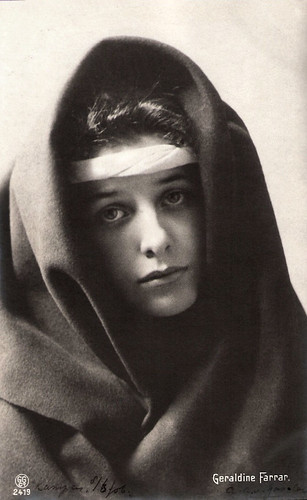
German postcard by G.G. & Co., no. 2419.
The toast of Berlin
Susan Smit unfolds in 'De eerste vrouw' the love story in two parts. First she tells about the years before Hollywood, in alternating chapters on the careers and lifes of 'Lou' and 'Geraldine'. At the end the two meet at an elegenat party in Holland House in New Tork. They immediately fall in love.
Alice Geraldine Farrar (1882-1967) had always been noted for her glamorous beauty, her acting talent, and the timbre of her voice. At 5 she already began studying music in Boston and by 14 was giving recitals. Barely 20, she was the toast of Berlin.
Farrar had created a sensation in 1901 at the Berlin Hofoper with her debut as Marguerite in Charles Gounod's 'Faust'. She remained with the company for three years, during which time she appeared in the title roles of Ambroise Thomas' 'Mignon' and Jules Massenet's 'Manon', as well as Juliette in Gounod's 'Roméo et Juliette'. Her admirers in Berlin included Crown Prince Wilhelm of Germany, with whom she is believed to have had a relationship beginning in 1903.
This Berlin period was interspersed with three seasons with the Monte Carlo Opera. Highlights were Pietro Mascagni's 'Amica' (1905), and Giuseppe Verdi's 'Rigoletto' (1906) in which she appeared with Enrico Caruso. In 1906, she also made her debut at the New York Metropolitan Opera in 'Roméo et Juliette'. The success placed her on a plateau with Caruso as a box-office magnet. The next year, she got raves for her performance as Cio-Cio-San in the Metropolitan premiere of Giacomo Puccini's 'Madama Butterfly' in 1907.
Geraldine Farrar had a seven-year love affair with the Italian conductor of the Met, Arturo Toscanini. It was rumored that she gave him an ultimatum that he must choose either her or his wife and children in Italy. It resulted in Toscanini's abrupt resignation as principal conductor of the Metropolitan Opera in 1915. Farrar was close friends with star tenor Enrico Caruso and there has been speculation that they too had a love affair, but no conclusive evidence of this has surfaced. At the Met, Farrar had a large following among young women, who were nicknamed ‘Gerry-flappers’. Farrar created the title roles in Puccini's 'Suor Angelica' (1918), Umberto Giordano's 'Madame Sans-Gêne' (1915), as well as the Goosegirl in Engelbert Humperdinck's 'Königskinder' (1910).
Her biographer Elizabeth Nash: “Unlike most of the famous bel canto singers of the past who sacrificed dramatic action to tonal perfection, she was more interested in the emotional than in the purely lyrical aspects of her roles.” Farrar remained a member of the company until her retirement in 1922, singing 29 roles there in 672 performances.
Geraldine Farrar also starred in more than a dozen silent films from 1915 to 1920, which were filmed between opera seasons. Farrar made her debut with the title role in Cecil B. De Mille's Carmen (1915), based on the novella 'Carmen' by Prosper Mérimée. For her role as the seductive gypsy girl she was extensively praised. DeMille directed her next in the silent romantic drama Temptation (Cecil B. DeMille, 1915), also with Theodore Roberts, and in the drama Maria Rosa (Cecil B. DeMille, 1916) with Wallace Reid.
Another notable screen role was as Joan of Arc in Joan the Woman (1917). This was Cecil B. DeMille's first historical drama. The screenplay is based on Friedrich Schiller's 1801 play 'Die Jungfrau von Orleans' (The Maid of Orleans).
She next played the daughter of an Aztec king in the silent romance The Woman God Forgot (Cecil B. DeMille, 1917). In the film she falls in love with a Spanish captain (Wallace Reid) whose army has come to convert the Aztecs to Christianity. Her last film for Paramount Pictures was the romance The Devil-Stone (Cecil B. DeMille, 1917), again with Wallace Reid. The film had sequences filmed in the Handschiegl Color Process, but only two of six reels are known to survive.
For Goldwyn Pictures, she appeared in such films as The Turn of the Wheel (Reginald Barker, 1918) with Herbert Rawlinson and Percy Marmont, the Western The Hell Cat (Reginald Barker, 1918), Shadows (Reginald Barker, 1918) and the melodrama The Stronger Vow (Reginald Barker, 1919), the latter three with Milton Sills. All four films are considered lost.
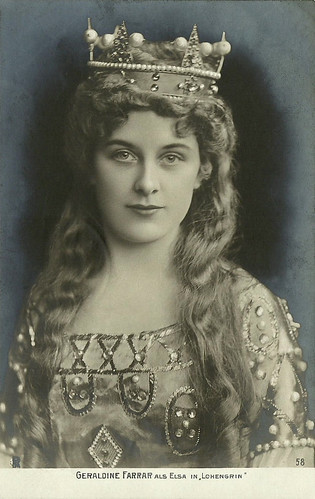
Vintage postcard, no. 58. Photo: Geraldine Farrar as Elsa in the opera 'Lohengrin'by Richard Wagner. Collection: Didier Hanson.
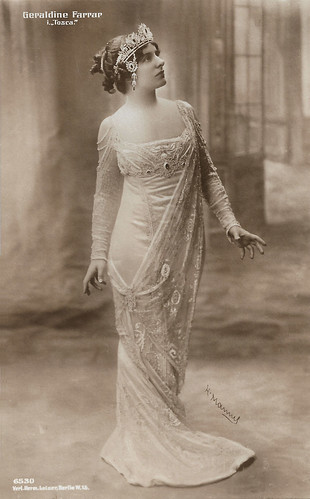
German postcard by Verlag Herm. Leiser, Berlin, no. 6530. Photo: H. Manuel. Geraldine Farrar as Tosca in the opera 'Tosca'.
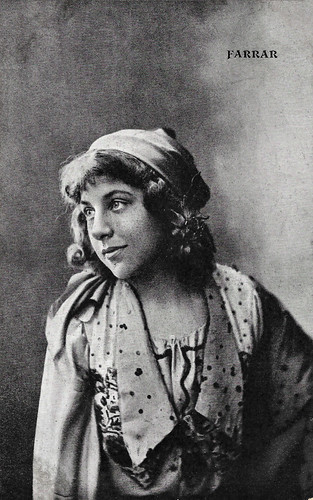
French postcard. Photo: Geraldine Farrar as Mignon in the opera 'Mignon'.
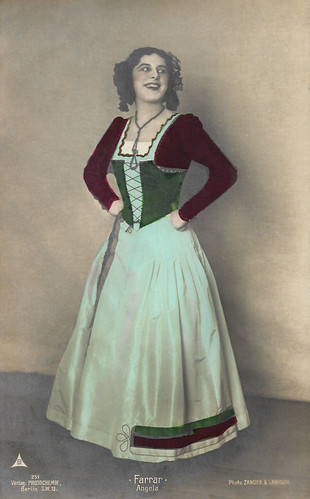
German postcard by Photochemie, Berlin, no. 251. Photo: Zander und Labisch. Geraldine Farrar as Angela in 'Le Domino Noir' (1905).
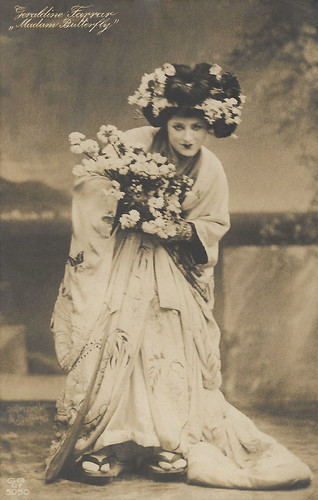
German postcard by GG Cie, no. 5050. Geraldine Farrar as Madam Butterfly in 'Madama Butterfly' (1907).
Romantically involved with the Divine Sarah
Lou Tellegen (1883-1934) was the illegitimate child of former army lieutenant Isidor Louis Bernard Edmon Tellegen and actress Anna Maria van Dommelen. In 1903, Lou made his stage debut in Rotterdam.
He moved to Brussels and later to Paris, where he worked as a model for such artists as Lacroix, Constantin Meunier and Auguste Rodin, and as a prize-boxer. He studied at the Conservatoire Nationale de Musique et de Déclamation, and worked for the Theatre de l'Odéon under André Antoine, the innovative founder of the Théâtre Libre.
Later he met dandy-actor Edouard de Max , who introduced him to Sarah Bernhardt . Eventually Lou co-starred in several roles with the Divine Sarah, and was also romantically involved with her. In 1910, he made his film debut as Armand Duval alongside Bernhardt in La dame aux camélias/Camille (Louis Mercanton, 1911), a French silent film based on the play by Alexandre Dumas, fils.
In 1910, Tellegen and Bernhardt travelled to the United States to appear on stage in 'Jeanne d’Arc' (Joan of Arc). Back in France, in 1912 they made their second film together, Les Amours de la reine Élisabeth/ Queen Elizabeth (Henri Desfontaines, Louis Mercanton, 1912). The film was an adaptation of a play by Émile Moreau about episodes of the life of Elizabeth I, Queen of England (1533-1603), and focused on her ill-fated love affair with Robert Devereux, Earl of Essex (Tellegen).
The film was an enormous success in the U.S., where it was distributed by Adolph Zukor. The following year, Bernhardt and Tellegen appeared again together in Adrienne Lecouvreur/An Actress's Romance (Henri Desfontaines, Louis Mercanton, 1913). The latter is considered a lost film. In the summer of 1913, Lou Tellegen went to London where he produced, directed and starred in the Oscar Wilde play 'The Picture of Dorian Gray'.
Invited back to the United States, Lou Tellegen worked in theatre and soon became a matinee idol. His leading role in the melodrama 'Maria Rosa' was a spectacular success. Samuel Goldwyn, Financial director of the Jesse L. Lasky Feature Play Company at the time, saw, Tellegen in 1915 in this play and offered him a contract for six films.
His American film début was The Explorer (George Melford, 1915), followed by The Unknown (George Melford, 1915), both with Dorothy Davenport as his co-star. The handsome Tellegen starred in numerous silent films opposite such stars as Sessue Hayakawa , in The Victoria Cross (Edward LeSaint, 1916), and Nell Shipman, in The Black Wolf (Frank Reicher, 1917).
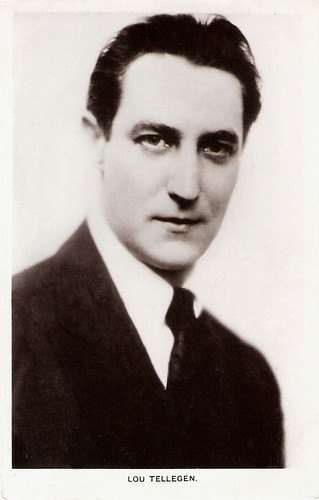
British postcard by Real Photograph in the Picturegoer series, London, no. 212.
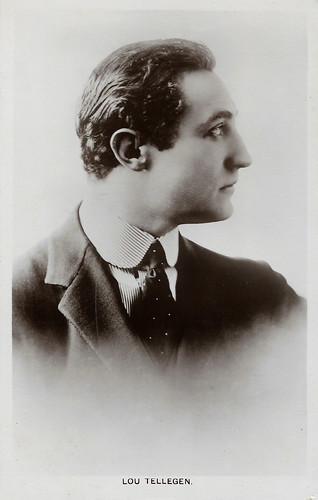
British postcard in the Picturegoer Series, no. 212a.
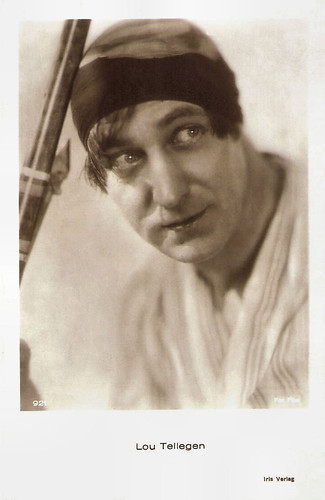
Austrian postcard by Iris Verlag, no. 921. Photo: Fox Film.
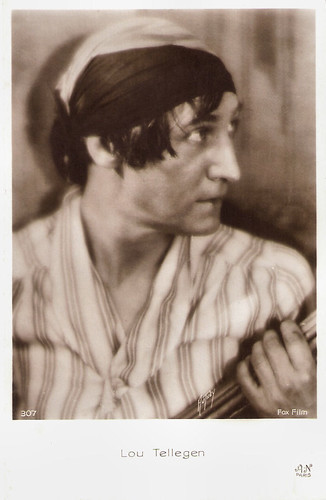
French postcard by A.N., Paris, no. 307. Photo: Max Munn Autrey / Fox Film.
A messy and very public divorce
In 1916, the opera diva turned film actress and the matinee idol married. They appeared in three films together: The World and Its Woman (Frank Lloyd, 1919), Flame of the Desert (Reginald Barker, 1919) and The Woman and the Puppet (Reginald Barker, 1920). Farrar's final film was the silent drama The Riddle: Woman (Edward José, 1920), in which her co-star was Montagu Love.
Lou Tellegen became an American citizen in 1918. He combined his work in the cinema with a successful stage career. Tellegen also worked as a producer and co-wrote two successful plays - 'Blind youth' (1917) with Willard Mack and 'The lust of gold' (1919) with Andor Garvay – which earned him a lot of money.
Tellegen was considered one of the best-looking actors of the silent screen, although our postcards don't confirm this. He was jealous about Farrar's successes and could not stand to be in her shadow. He started to drink and gamble, and numerous affairs followed. His marriage with Farrar became the source of considerable scandal. It ended in a messy and very public divorce in 1923.
Geraldine Farrar retired from opera in 1922 at the age of 40. Her final performance was as Leoncavallo's 'Zazà'. By this stage, her voice was in premature decline due to overwork. She quickly transitioned into concert recitals, and was signed (within several weeks of announcing her opera retirement) to an appearance at Hershey Park on Memorial Day 1922. She continued to make recordings and give recitals throughout the 1920s.
Lou Tellegen appeared in numerous silent films for Vitagraph and Fox Film, including The Redeeming Sin (J. Stuart Blackton, 1925) with Alla Nazimova , and Parisian Love (Louis J. Gasnier, 1925) with Clara Bow.
One of his memorable roles was as the corrupt Sheriff in John Ford's classic Western Three Bad Men (1926), wearing a white hat instead of the stereotypical bad guy black hat. He also directed a film starring Dolores del Rio , No Other Woman (Lou Tellegen, 1928), but it was not a success.
After his face was damaged in a hotel fire in 1929 and sound film had areived, Lou Tellegen ’s fame faded. Among his rare sound film appearances were a supporting part in the crime film Enemies of the Law (Lawrence C. Windom, 1931) with Mary Nolan , and a bit part in Caravane (Erik Charell, 1934) starring Charles Boyer .
Employment was not forthcoming and debt-ridden, he went bankrupt. He was diagnosed with cancer, though this information was kept from him, and he became despondent. In 1934, Tellegen locked himself in the bathroom of a mansion of a female admirer in Los Angeles. He shaved and powdered his face, and while standing in front of a full-length mirror, he committed harakiri by stabbing himself seven times with a pair of golden scissors (which had his name engraved on them).
When asked to comment on Tellegen's death, Geraldine Farrar replied candidly: "Why should that interest me?" The Tellegen interlude, the prima donna claimed long ago, left only "a surface scar." Smit imagines that Farrar must have been devastated. The handsome Dutchman had been the love of her life. She never remarried and had no children. In 1967, Farrar died in Ridgefield, Connecticut of heart disease, aged 85.
Susan Smit beautifully imagines Tellegen's and Farrar's boundless ambition, their doubts, fears and their passionate love that was doomed to fail. But at the same time the novel is the story of an exciting time in which Europe loses its innocence in a horrible war; the women's movement is slowly gaining ground, and a mass medium sees the light of day that changed the world forever: the cinema.
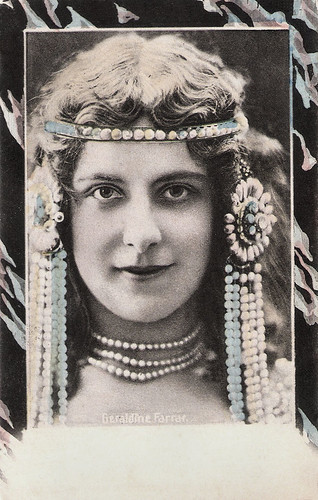
German postcard by K.V.i.B., Dess, no. 1016.
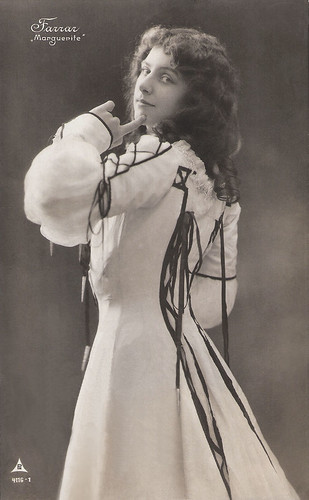
German postcard by PH, no. 4116/1. Geraldine Farrar as Marguerite in Charles Gounod's opera 'Faust'.
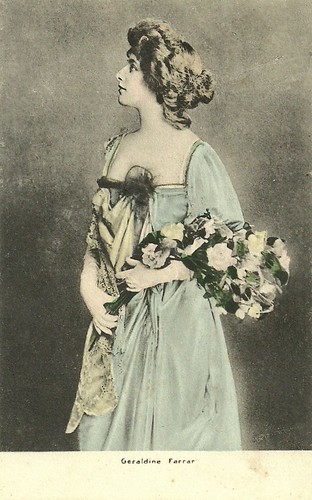
German postcard by K.V.i.B. 12. Dess., no. 4017.
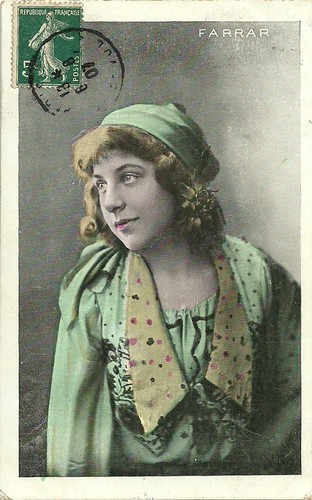
French postcard, sent by mail in 1907. Geraldine Farrar in the opera 'Mignon'.
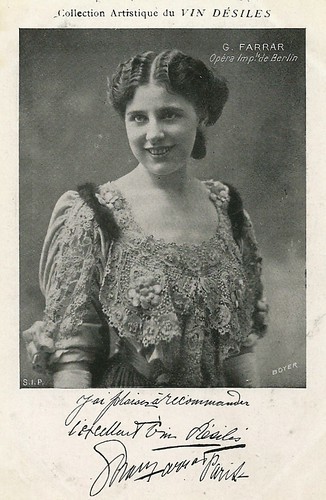
French postcard. Publicity for Vins Désiles. Photo SIP, Boyer. G. Farrar de l'Opéra Impéraile de Berlin. Caption: J'ai plaisir à recommander l'excellent Vin Désiles (I enjoy recommending the excellent V.D.).
Sources: Book, Bob Bertina (Lou Tellegen. Een Hollander in Hollywood, VN Bijlage 1985 - Dutch), A.J.C.M. Gabriëls (Institute of Netherlands History), Andrea Suhm-Binder (Cantabile subito), Bob Hufford (Find A Grave), Wikipedia and .

Book cover for Susan Smit, 'De eerste vrouw' (2016). Publisher: Lebowski, Amsterdam.

German postcard by G.G. & Co., no. 478/4. Photo: Gerlach.

German postcard by G.G. & Co., no. 579/5. Photo: Gerlach.

German postcard by G.G. & Co., no. 2414. Photo: Photo: Geraldine Farrar as Mignon in the opera 'Mignon'. Collection: Didier Hanson.

German postcard by G.G. & Co., no. 2419.
The toast of Berlin
Susan Smit unfolds in 'De eerste vrouw' the love story in two parts. First she tells about the years before Hollywood, in alternating chapters on the careers and lifes of 'Lou' and 'Geraldine'. At the end the two meet at an elegenat party in Holland House in New Tork. They immediately fall in love.
Alice Geraldine Farrar (1882-1967) had always been noted for her glamorous beauty, her acting talent, and the timbre of her voice. At 5 she already began studying music in Boston and by 14 was giving recitals. Barely 20, she was the toast of Berlin.
Farrar had created a sensation in 1901 at the Berlin Hofoper with her debut as Marguerite in Charles Gounod's 'Faust'. She remained with the company for three years, during which time she appeared in the title roles of Ambroise Thomas' 'Mignon' and Jules Massenet's 'Manon', as well as Juliette in Gounod's 'Roméo et Juliette'. Her admirers in Berlin included Crown Prince Wilhelm of Germany, with whom she is believed to have had a relationship beginning in 1903.
This Berlin period was interspersed with three seasons with the Monte Carlo Opera. Highlights were Pietro Mascagni's 'Amica' (1905), and Giuseppe Verdi's 'Rigoletto' (1906) in which she appeared with Enrico Caruso. In 1906, she also made her debut at the New York Metropolitan Opera in 'Roméo et Juliette'. The success placed her on a plateau with Caruso as a box-office magnet. The next year, she got raves for her performance as Cio-Cio-San in the Metropolitan premiere of Giacomo Puccini's 'Madama Butterfly' in 1907.
Geraldine Farrar had a seven-year love affair with the Italian conductor of the Met, Arturo Toscanini. It was rumored that she gave him an ultimatum that he must choose either her or his wife and children in Italy. It resulted in Toscanini's abrupt resignation as principal conductor of the Metropolitan Opera in 1915. Farrar was close friends with star tenor Enrico Caruso and there has been speculation that they too had a love affair, but no conclusive evidence of this has surfaced. At the Met, Farrar had a large following among young women, who were nicknamed ‘Gerry-flappers’. Farrar created the title roles in Puccini's 'Suor Angelica' (1918), Umberto Giordano's 'Madame Sans-Gêne' (1915), as well as the Goosegirl in Engelbert Humperdinck's 'Königskinder' (1910).
Her biographer Elizabeth Nash: “Unlike most of the famous bel canto singers of the past who sacrificed dramatic action to tonal perfection, she was more interested in the emotional than in the purely lyrical aspects of her roles.” Farrar remained a member of the company until her retirement in 1922, singing 29 roles there in 672 performances.
Geraldine Farrar also starred in more than a dozen silent films from 1915 to 1920, which were filmed between opera seasons. Farrar made her debut with the title role in Cecil B. De Mille's Carmen (1915), based on the novella 'Carmen' by Prosper Mérimée. For her role as the seductive gypsy girl she was extensively praised. DeMille directed her next in the silent romantic drama Temptation (Cecil B. DeMille, 1915), also with Theodore Roberts, and in the drama Maria Rosa (Cecil B. DeMille, 1916) with Wallace Reid.
Another notable screen role was as Joan of Arc in Joan the Woman (1917). This was Cecil B. DeMille's first historical drama. The screenplay is based on Friedrich Schiller's 1801 play 'Die Jungfrau von Orleans' (The Maid of Orleans).
She next played the daughter of an Aztec king in the silent romance The Woman God Forgot (Cecil B. DeMille, 1917). In the film she falls in love with a Spanish captain (Wallace Reid) whose army has come to convert the Aztecs to Christianity. Her last film for Paramount Pictures was the romance The Devil-Stone (Cecil B. DeMille, 1917), again with Wallace Reid. The film had sequences filmed in the Handschiegl Color Process, but only two of six reels are known to survive.
For Goldwyn Pictures, she appeared in such films as The Turn of the Wheel (Reginald Barker, 1918) with Herbert Rawlinson and Percy Marmont, the Western The Hell Cat (Reginald Barker, 1918), Shadows (Reginald Barker, 1918) and the melodrama The Stronger Vow (Reginald Barker, 1919), the latter three with Milton Sills. All four films are considered lost.

Vintage postcard, no. 58. Photo: Geraldine Farrar as Elsa in the opera 'Lohengrin'by Richard Wagner. Collection: Didier Hanson.

German postcard by Verlag Herm. Leiser, Berlin, no. 6530. Photo: H. Manuel. Geraldine Farrar as Tosca in the opera 'Tosca'.

French postcard. Photo: Geraldine Farrar as Mignon in the opera 'Mignon'.

German postcard by Photochemie, Berlin, no. 251. Photo: Zander und Labisch. Geraldine Farrar as Angela in 'Le Domino Noir' (1905).

German postcard by GG Cie, no. 5050. Geraldine Farrar as Madam Butterfly in 'Madama Butterfly' (1907).
Romantically involved with the Divine Sarah
Lou Tellegen (1883-1934) was the illegitimate child of former army lieutenant Isidor Louis Bernard Edmon Tellegen and actress Anna Maria van Dommelen. In 1903, Lou made his stage debut in Rotterdam.
He moved to Brussels and later to Paris, where he worked as a model for such artists as Lacroix, Constantin Meunier and Auguste Rodin, and as a prize-boxer. He studied at the Conservatoire Nationale de Musique et de Déclamation, and worked for the Theatre de l'Odéon under André Antoine, the innovative founder of the Théâtre Libre.
Later he met dandy-actor Edouard de Max , who introduced him to Sarah Bernhardt . Eventually Lou co-starred in several roles with the Divine Sarah, and was also romantically involved with her. In 1910, he made his film debut as Armand Duval alongside Bernhardt in La dame aux camélias/Camille (Louis Mercanton, 1911), a French silent film based on the play by Alexandre Dumas, fils.
In 1910, Tellegen and Bernhardt travelled to the United States to appear on stage in 'Jeanne d’Arc' (Joan of Arc). Back in France, in 1912 they made their second film together, Les Amours de la reine Élisabeth/ Queen Elizabeth (Henri Desfontaines, Louis Mercanton, 1912). The film was an adaptation of a play by Émile Moreau about episodes of the life of Elizabeth I, Queen of England (1533-1603), and focused on her ill-fated love affair with Robert Devereux, Earl of Essex (Tellegen).
The film was an enormous success in the U.S., where it was distributed by Adolph Zukor. The following year, Bernhardt and Tellegen appeared again together in Adrienne Lecouvreur/An Actress's Romance (Henri Desfontaines, Louis Mercanton, 1913). The latter is considered a lost film. In the summer of 1913, Lou Tellegen went to London where he produced, directed and starred in the Oscar Wilde play 'The Picture of Dorian Gray'.
Invited back to the United States, Lou Tellegen worked in theatre and soon became a matinee idol. His leading role in the melodrama 'Maria Rosa' was a spectacular success. Samuel Goldwyn, Financial director of the Jesse L. Lasky Feature Play Company at the time, saw, Tellegen in 1915 in this play and offered him a contract for six films.
His American film début was The Explorer (George Melford, 1915), followed by The Unknown (George Melford, 1915), both with Dorothy Davenport as his co-star. The handsome Tellegen starred in numerous silent films opposite such stars as Sessue Hayakawa , in The Victoria Cross (Edward LeSaint, 1916), and Nell Shipman, in The Black Wolf (Frank Reicher, 1917).

British postcard by Real Photograph in the Picturegoer series, London, no. 212.

British postcard in the Picturegoer Series, no. 212a.

Austrian postcard by Iris Verlag, no. 921. Photo: Fox Film.

French postcard by A.N., Paris, no. 307. Photo: Max Munn Autrey / Fox Film.
A messy and very public divorce
In 1916, the opera diva turned film actress and the matinee idol married. They appeared in three films together: The World and Its Woman (Frank Lloyd, 1919), Flame of the Desert (Reginald Barker, 1919) and The Woman and the Puppet (Reginald Barker, 1920). Farrar's final film was the silent drama The Riddle: Woman (Edward José, 1920), in which her co-star was Montagu Love.
Lou Tellegen became an American citizen in 1918. He combined his work in the cinema with a successful stage career. Tellegen also worked as a producer and co-wrote two successful plays - 'Blind youth' (1917) with Willard Mack and 'The lust of gold' (1919) with Andor Garvay – which earned him a lot of money.
Tellegen was considered one of the best-looking actors of the silent screen, although our postcards don't confirm this. He was jealous about Farrar's successes and could not stand to be in her shadow. He started to drink and gamble, and numerous affairs followed. His marriage with Farrar became the source of considerable scandal. It ended in a messy and very public divorce in 1923.
Geraldine Farrar retired from opera in 1922 at the age of 40. Her final performance was as Leoncavallo's 'Zazà'. By this stage, her voice was in premature decline due to overwork. She quickly transitioned into concert recitals, and was signed (within several weeks of announcing her opera retirement) to an appearance at Hershey Park on Memorial Day 1922. She continued to make recordings and give recitals throughout the 1920s.
Lou Tellegen appeared in numerous silent films for Vitagraph and Fox Film, including The Redeeming Sin (J. Stuart Blackton, 1925) with Alla Nazimova , and Parisian Love (Louis J. Gasnier, 1925) with Clara Bow.
One of his memorable roles was as the corrupt Sheriff in John Ford's classic Western Three Bad Men (1926), wearing a white hat instead of the stereotypical bad guy black hat. He also directed a film starring Dolores del Rio , No Other Woman (Lou Tellegen, 1928), but it was not a success.
After his face was damaged in a hotel fire in 1929 and sound film had areived, Lou Tellegen ’s fame faded. Among his rare sound film appearances were a supporting part in the crime film Enemies of the Law (Lawrence C. Windom, 1931) with Mary Nolan , and a bit part in Caravane (Erik Charell, 1934) starring Charles Boyer .
Employment was not forthcoming and debt-ridden, he went bankrupt. He was diagnosed with cancer, though this information was kept from him, and he became despondent. In 1934, Tellegen locked himself in the bathroom of a mansion of a female admirer in Los Angeles. He shaved and powdered his face, and while standing in front of a full-length mirror, he committed harakiri by stabbing himself seven times with a pair of golden scissors (which had his name engraved on them).
When asked to comment on Tellegen's death, Geraldine Farrar replied candidly: "Why should that interest me?" The Tellegen interlude, the prima donna claimed long ago, left only "a surface scar." Smit imagines that Farrar must have been devastated. The handsome Dutchman had been the love of her life. She never remarried and had no children. In 1967, Farrar died in Ridgefield, Connecticut of heart disease, aged 85.
Susan Smit beautifully imagines Tellegen's and Farrar's boundless ambition, their doubts, fears and their passionate love that was doomed to fail. But at the same time the novel is the story of an exciting time in which Europe loses its innocence in a horrible war; the women's movement is slowly gaining ground, and a mass medium sees the light of day that changed the world forever: the cinema.

German postcard by K.V.i.B., Dess, no. 1016.

German postcard by PH, no. 4116/1. Geraldine Farrar as Marguerite in Charles Gounod's opera 'Faust'.

German postcard by K.V.i.B. 12. Dess., no. 4017.

French postcard, sent by mail in 1907. Geraldine Farrar in the opera 'Mignon'.

French postcard. Publicity for Vins Désiles. Photo SIP, Boyer. G. Farrar de l'Opéra Impéraile de Berlin. Caption: J'ai plaisir à recommander l'excellent Vin Désiles (I enjoy recommending the excellent V.D.).
Sources: Book, Bob Bertina (Lou Tellegen. Een Hollander in Hollywood, VN Bijlage 1985 - Dutch), A.J.C.M. Gabriëls (Institute of Netherlands History), Andrea Suhm-Binder (Cantabile subito), Bob Hufford (Find A Grave), Wikipedia and .
Published on September 04, 2019 22:00
September 3, 2019
Queenie Thomas
British actress Queenie Thomas (1898–1977) appeared in dozens of silent British films. She often worked with writer-producer-director Bertram Phillips.
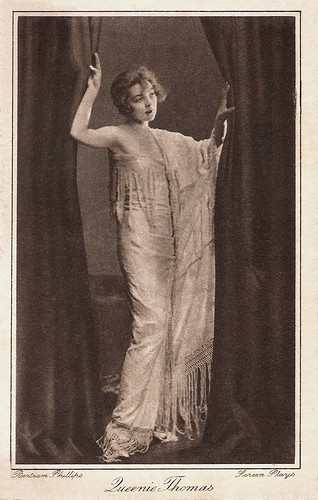
British postcard in the series Screen Plays. Photo: Bertram Phillips.
Aerial Honeymoon
Marjorie Violet Queenie Thomas was born in Cardiff, Wales, Great Britain in 1898.
In 1914 she made her film debut, probably in Jessie (1914) for the Bamforth Company. In the next year she played the lead role in several films, such as The White Star (Bertram Phillips, 1915), John Halifax, Gentleman (George Pearson, 1915) with Fred Paul, and Infelice (L.C. MacBean, Fred Paul, 1915).
During the First World War she also appeared in leading roles in several more silent films, such as Frills (Bertram Phillips, 1916), and What Would a Gentleman Do? (Wilfred Noy, 1918).
In the post-war years she continued to star in comedies and romantic dramas, often written, produced and directed by Bertram Philips. These films include A Little Child Shall Lead Them (Bertram Phillips, 1919) with South African actor Bruce Gordon, and Trousers (Bertram Phillips, 1920).
In 1919 Queenie Thomas was married to George Newman. After their wedding ceremony at St. Margaret's Church in Westminster they had an ‘aerial honeymoon’, while they flew from London to Paris. Warch this Pathé Gazette clip about their flight.
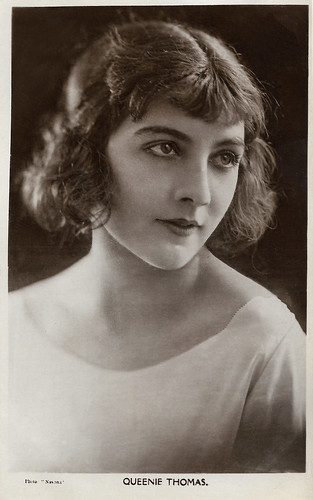
British postcard in the Picturegoer Series, London, no. 73. Photo: Navana.
Hiatus
During the early 1920s, the film appearances of Queenie Thomas were less frequently. She returned to the screen in the comedy Tut-Tut and His Terrible Tomb (Bertram Phillips, 1923). It was one of six episodes in the Syncopated Picture Plays 2-reel series.
Another series in which she appeared was the Rainbow comedy series, produced by the company of Bertram Phillips and directed by Bernard Dudley.
Other comedies in which she starred were The School for Scandal (Bertram Phillips, 1923) with Basil Rathbone, and The Alley of Golden Hearts (Bertram Phillips, 1924).
She also played in crime dramas, such as Her Redemption (Bertram Phillips, 1924) with John Stuart, and The Last Witness (Fred Paul, 1925) starring Isobel Elsom . In the comedy Safety First (Fred Paul, 1926) she starred with Brian Aherne .
At the end of the 1920s there was a new hiatus in her film career and then she played in her last film, the late silent production Warned Off (Walter West, 1930).
Queenie Thomas died in 1977 in Great Britain. She was 79.
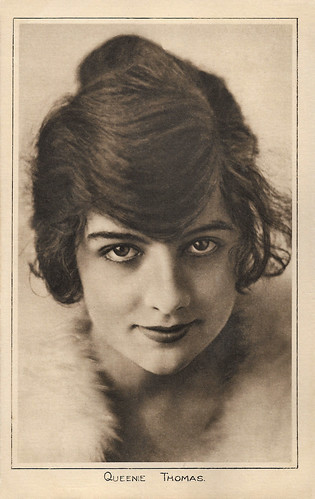
British postcard in the 'Pictures' Portait Gallery' by Pictures Ltd., London, no. 57.
Sources: BFI, Wikipedia and .

British postcard in the series Screen Plays. Photo: Bertram Phillips.
Aerial Honeymoon
Marjorie Violet Queenie Thomas was born in Cardiff, Wales, Great Britain in 1898.
In 1914 she made her film debut, probably in Jessie (1914) for the Bamforth Company. In the next year she played the lead role in several films, such as The White Star (Bertram Phillips, 1915), John Halifax, Gentleman (George Pearson, 1915) with Fred Paul, and Infelice (L.C. MacBean, Fred Paul, 1915).
During the First World War she also appeared in leading roles in several more silent films, such as Frills (Bertram Phillips, 1916), and What Would a Gentleman Do? (Wilfred Noy, 1918).
In the post-war years she continued to star in comedies and romantic dramas, often written, produced and directed by Bertram Philips. These films include A Little Child Shall Lead Them (Bertram Phillips, 1919) with South African actor Bruce Gordon, and Trousers (Bertram Phillips, 1920).
In 1919 Queenie Thomas was married to George Newman. After their wedding ceremony at St. Margaret's Church in Westminster they had an ‘aerial honeymoon’, while they flew from London to Paris. Warch this Pathé Gazette clip about their flight.

British postcard in the Picturegoer Series, London, no. 73. Photo: Navana.
Hiatus
During the early 1920s, the film appearances of Queenie Thomas were less frequently. She returned to the screen in the comedy Tut-Tut and His Terrible Tomb (Bertram Phillips, 1923). It was one of six episodes in the Syncopated Picture Plays 2-reel series.
Another series in which she appeared was the Rainbow comedy series, produced by the company of Bertram Phillips and directed by Bernard Dudley.
Other comedies in which she starred were The School for Scandal (Bertram Phillips, 1923) with Basil Rathbone, and The Alley of Golden Hearts (Bertram Phillips, 1924).
She also played in crime dramas, such as Her Redemption (Bertram Phillips, 1924) with John Stuart, and The Last Witness (Fred Paul, 1925) starring Isobel Elsom . In the comedy Safety First (Fred Paul, 1926) she starred with Brian Aherne .
At the end of the 1920s there was a new hiatus in her film career and then she played in her last film, the late silent production Warned Off (Walter West, 1930).
Queenie Thomas died in 1977 in Great Britain. She was 79.

British postcard in the 'Pictures' Portait Gallery' by Pictures Ltd., London, no. 57.
Sources: BFI, Wikipedia and .
Published on September 03, 2019 22:00
September 2, 2019
Mare Nostrum (1926)
Alice Terry and 'Latin Lover' Antonio Moreno were the stars of Rex Ingram's Mata Hari-like drama Mare Nostrum/Our Sea (1926) based on a novel by Vicente Blasco Ibáñez. It is the story of a female Austrian spy who willingly sacrifices her life for her country. Long thought lost, the film has recently been re-discovered and restored.
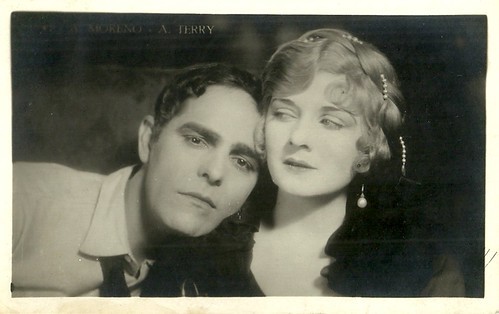
Italian postcard, sent by mail in 1927. Photo: Ebany. Antonio Moreno and Alice Terry in Mare Nostrum (Rex Ingram, 1926).
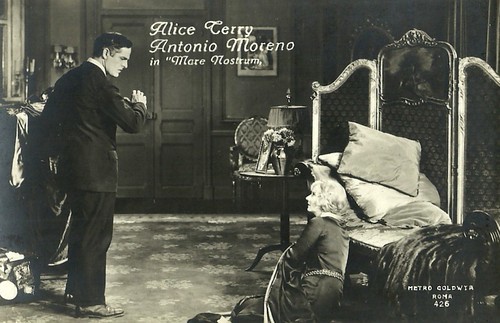
Italian postcard by Ballerini & Fratini, Florence, no. 426. Photo: Metro-Goldwyn-Mayer, Roma. Antonio Moreno and Alice Terry in Mare Nostrum (Rex Ingram, 1926).
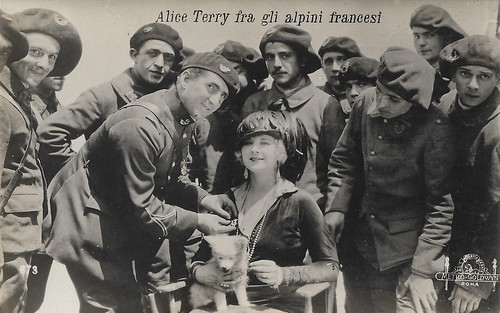
Italian postcard by Ballerini & Fratini, Florence, no. 673. Photo: Metro-Goldwyn-Mayer, Roma. American silent film actress Alice Terry amidst the French Alpine Hunters, during a break in the shooting of Mare Nostrum (Rex Ingram, 1926). The 'Alpins' execute her character in the film, freely inspired by the Mata Hari affair. Ingram hired the soldiers to shoot the execution of Terry's Mata Hari-like female spy Freya, on exact the same location at Vincennes where the real Mata Hari had been shot.
Head over heels in love with an Austrian Spy
In Mare Nostrum, the young Spaniard Ulysses Ferragut (Kada-Abd-el-Kader) is fascinated by his retired uncle’s stories about the sea, particularly his claim to have once seen the sea goddess Amphitrite. Against his father’s wishes, Ulysses becomes a sailor. Kada-Abd-el-Kader was the adopted son of star Alice Terry and director Rex Ingram.
The grown up Ulysses (Antonio Moreno) buys the Mare Nostrum, a fast, modern freighter. He prospers when because of the outbreak of World War One the demand for shipping ends catapults. While visiting the ruins of Pompeii, Ulysses meets the attractive Freya Talberg (Alice Terry), the spitting image of his uncle’s sea goddess, and her female companion, the stern Dr. Fedelmann (Pâquerette).
Ulysses is head over heels in love with Freya and not even the message that the two women are Austrian spies (according to IMDB , German spies) discourages him. Spain is neutral after all. He even helps transporting Count Kaledine (Fernand Mailly) to a secret rendezvous in the Mediterranean, where an U-boat surfaces, takes on fuel from Ulysses' ship, and departs with Kaledine.
Then fate hits hard, as Esteban (Mickey Brantford), Ulysses’ young son, is killed by the same U-boat when returning to Barcelona on a British ship, after trying to find his father in vain. When Ulysses hears this, he vows to avenge his boy. The ice-cold Fedelmann prevents Freya from pacifying and considers her unreliable because of her love for Ulysses. So she lures her to France and betrays her to the French.
Freya suspects the conspiracy and asks Ulysses for help, but he is hurt and refuses, so she is captured, convicted, and shot by a firing squad at dawn. Ulysses then chases and catches the culprit Count Kaledine, helped by the mob, and starts to use his ship in the service of the Allies, arming her with a deck gun, replacing his crew with French military sailors, and transporting munitions to Salonica.
Only long-time family friend and sea cook Caragol (Hughie Mack) refuses to leave him. On the voyage, they are intercepted by the same U-boat again. With the Mare Nostrum torpedoed and doomed, Ulysses mans the abandoned deck gun and sinks the U-boat. As he descends into the ocean depths, Amphitrite rises to embrace and kiss him.
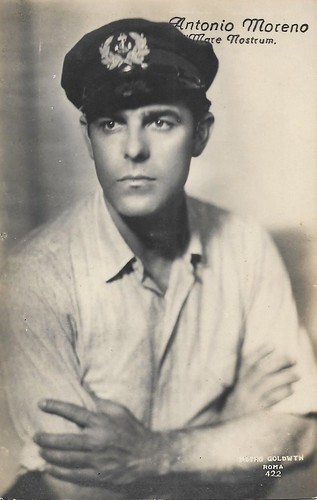
Italian postcard, no. 422. Photo: Metro Goldwyn, Roma. Antonio Moreno in Mare Nostrum (Rex Ingram, 1926).
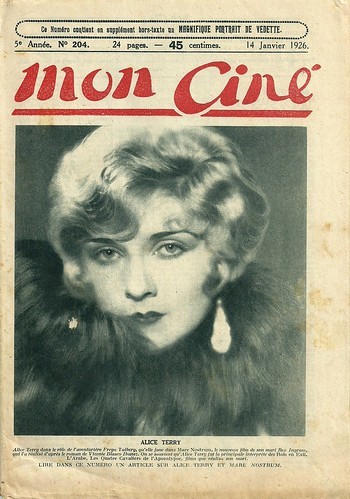
French film journal Mon Ciné, 5, 204, 14 January, 1926, p. 1.
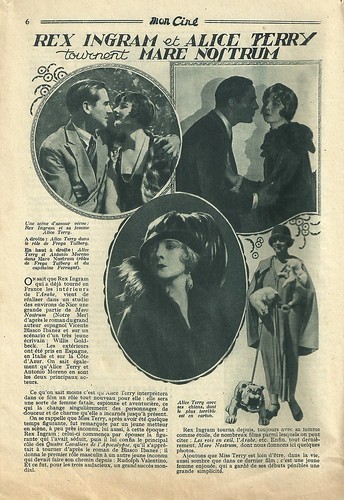
French film journal Mon Ciné, 5, 204, 14 January 1926, p. 6.
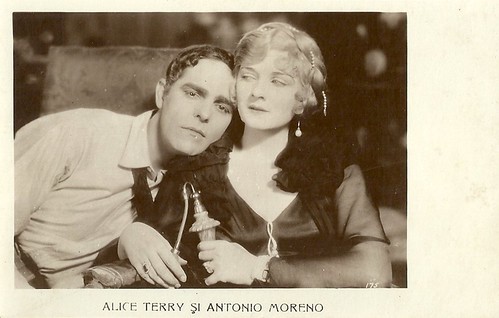
Romanian postcard. Antonio Moreno and Alice Terry in Mare Nostrum (Rex Ingram, 1926).
Sources: Wikipedia and IMDb.

Italian postcard, sent by mail in 1927. Photo: Ebany. Antonio Moreno and Alice Terry in Mare Nostrum (Rex Ingram, 1926).

Italian postcard by Ballerini & Fratini, Florence, no. 426. Photo: Metro-Goldwyn-Mayer, Roma. Antonio Moreno and Alice Terry in Mare Nostrum (Rex Ingram, 1926).

Italian postcard by Ballerini & Fratini, Florence, no. 673. Photo: Metro-Goldwyn-Mayer, Roma. American silent film actress Alice Terry amidst the French Alpine Hunters, during a break in the shooting of Mare Nostrum (Rex Ingram, 1926). The 'Alpins' execute her character in the film, freely inspired by the Mata Hari affair. Ingram hired the soldiers to shoot the execution of Terry's Mata Hari-like female spy Freya, on exact the same location at Vincennes where the real Mata Hari had been shot.
Head over heels in love with an Austrian Spy
In Mare Nostrum, the young Spaniard Ulysses Ferragut (Kada-Abd-el-Kader) is fascinated by his retired uncle’s stories about the sea, particularly his claim to have once seen the sea goddess Amphitrite. Against his father’s wishes, Ulysses becomes a sailor. Kada-Abd-el-Kader was the adopted son of star Alice Terry and director Rex Ingram.
The grown up Ulysses (Antonio Moreno) buys the Mare Nostrum, a fast, modern freighter. He prospers when because of the outbreak of World War One the demand for shipping ends catapults. While visiting the ruins of Pompeii, Ulysses meets the attractive Freya Talberg (Alice Terry), the spitting image of his uncle’s sea goddess, and her female companion, the stern Dr. Fedelmann (Pâquerette).
Ulysses is head over heels in love with Freya and not even the message that the two women are Austrian spies (according to IMDB , German spies) discourages him. Spain is neutral after all. He even helps transporting Count Kaledine (Fernand Mailly) to a secret rendezvous in the Mediterranean, where an U-boat surfaces, takes on fuel from Ulysses' ship, and departs with Kaledine.
Then fate hits hard, as Esteban (Mickey Brantford), Ulysses’ young son, is killed by the same U-boat when returning to Barcelona on a British ship, after trying to find his father in vain. When Ulysses hears this, he vows to avenge his boy. The ice-cold Fedelmann prevents Freya from pacifying and considers her unreliable because of her love for Ulysses. So she lures her to France and betrays her to the French.
Freya suspects the conspiracy and asks Ulysses for help, but he is hurt and refuses, so she is captured, convicted, and shot by a firing squad at dawn. Ulysses then chases and catches the culprit Count Kaledine, helped by the mob, and starts to use his ship in the service of the Allies, arming her with a deck gun, replacing his crew with French military sailors, and transporting munitions to Salonica.
Only long-time family friend and sea cook Caragol (Hughie Mack) refuses to leave him. On the voyage, they are intercepted by the same U-boat again. With the Mare Nostrum torpedoed and doomed, Ulysses mans the abandoned deck gun and sinks the U-boat. As he descends into the ocean depths, Amphitrite rises to embrace and kiss him.

Italian postcard, no. 422. Photo: Metro Goldwyn, Roma. Antonio Moreno in Mare Nostrum (Rex Ingram, 1926).

French film journal Mon Ciné, 5, 204, 14 January, 1926, p. 1.

French film journal Mon Ciné, 5, 204, 14 January 1926, p. 6.

Romanian postcard. Antonio Moreno and Alice Terry in Mare Nostrum (Rex Ingram, 1926).
Sources: Wikipedia and IMDb.
Published on September 02, 2019 22:00
September 1, 2019
William Russell
Willam Russell (1884-1929) was an American popular actor of the silent screen who died already at age 44 in 1929.
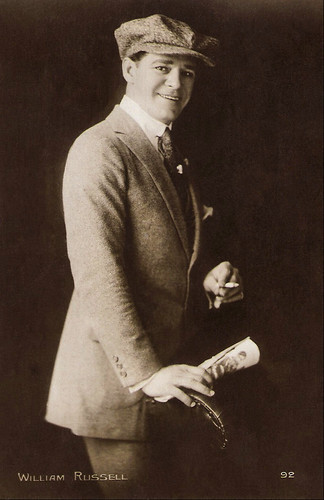
French postcard by Editions Cinémagazine, no. 92.
Biograph, Thanhouser, Mutual
William Russell was born William Francis Lerche, in the Bronx, New York, in 1884.
As his mother was a highly regarded stage actress, Russell already at the age of eight starting acting on stage. He performed with such classic actors as Ethel Barrymore, but this career stopped when he was 16 and became an invalid. Thanks to rigorous physical therapy, he became well after six years and became an amateur boxing champion.
In 1910 he started to act in New York at the Biograph company. After nine months, he switched over to the Thanhouser company, where his brother Alfred directed him in several films. His star status grew, and he performed in David Copperfield (1911) and The Star of Betlehem (1912), the latter with Florence LaBadie and James Cruze.
With LaBadie and Cruze, Russell switched to Mutual in 1913, where he acted in several films till 1916. In 1917 he moved to the American Film company, which films were distributed by Pathé Exchange.
Under the aegis of American, Russell started his own company William Russell Productions, for which he made films such as Hobbs in a Hurry (1918), Hearts or Diamonds (1918), Up Romance Road (1918), Brass Buttons (1919), When a Man Rides Alone (1919), and Where the West Begins (1919); all directed by Henry King. Often these were Western comedies, with e.g. Eileen Percy, Winifred Westover, and Charlotte Burton. He married the latter in 1917 but they divorced four years later.
In 1919 Russell moved to California, to start working for Fox Film, where he debuted in The Lincoln Highwayman (Emmett J. Flynn, 1919). By then Russell was a star, and his films were draped around his star persona. The posters for his films confirm this. His former co-star Eileen Percy had moved with him to Fox, and they acted together in Leave It to Me (Emmett J. Flynn, 1920).
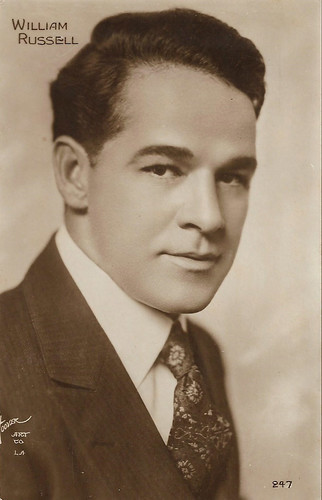
French postcard by Editions Cinémagazine, no. 247. Photo: Hoover Art Co, Los Angeles.
Vitagraph, Universal, Fox
William Russell co-acted with actress Helen Ferguson in e.g. Show with Fire (Emmett J. Flynn, 1920). The two married in 1921. At Fox, Russell made seven to eight films a year between 1919 and 1923, with directors such as Flynn and Scott Dunlap. and expanding his western hero reputation with other genres such as modern dramas and comedies.
In 1923, Russell had the male lead as Matt Burke, the rough sailor, in the First National production Anna Christie, directed by John Griffith Wray and Thomas Ince, and with Blanche Sweet in the title role. The film, faithful to Eugene O'Neill's play, was a fine film with a great part for Sweet. Unjustly, the film has come to stay in the shadow of its later 1930 sound version with Greta Garbo. Presumed lost, the film was found in Russia and it is now available with English Intertitles. Eugenie Besserer plays the old alcoholic, played by Marie Dressler in the sound version.
From then on, Russell freelanced with various Californian companies such as Vitagraph, Universal, Fox, and others. It also meant he was often an antagonist of the female or male lead, e.g. in The Blue Eagle (John Ford, 1926).
He was still the male lead in e.g. the dramas Before Midnight (John G. Adolfi, Henry Ginsberg, 1925), and Big Pal (John G. Adolfi, 1925), produced by his own company.
In 1927 Russell started to act in series of films at Warner Brothers, first in The Desired Woman (Michael Curtiz, 1927), in which he was the costar of Irene Rich. By now, he was often cast as tough gangster opposite the leads, as in Brass Knuckles (Lloyd Bacon, 1927), though he also was a sergeant in the frozen North woods in Danger Patrol (Duke Worne, 1928).
While Russell was in a part-talkie, The Midnight Taxi (John G. Adolfi, 1928), his first and practically only full dialogue film was Girls Gone Wild (Lewis Seiler, 1929).
William Russell died in Beverly Hills, California, 1929, from pneumonia. A few days after, his brother Albert died.
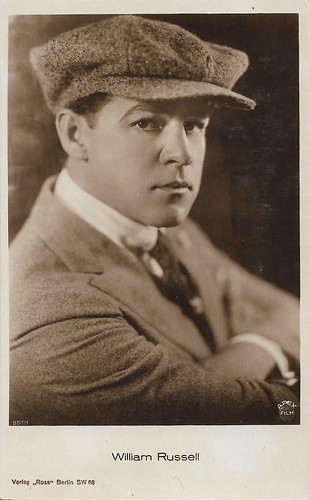
German postcard by Ross Verlag, Berlin, no. 857/1, 1925-1926. Apex Film.
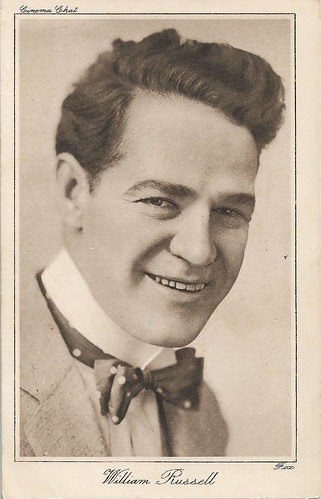
British postcard by Cinema Chat. Photo: Fox.
Sources: Wikipedia (English) and .

French postcard by Editions Cinémagazine, no. 92.
Biograph, Thanhouser, Mutual
William Russell was born William Francis Lerche, in the Bronx, New York, in 1884.
As his mother was a highly regarded stage actress, Russell already at the age of eight starting acting on stage. He performed with such classic actors as Ethel Barrymore, but this career stopped when he was 16 and became an invalid. Thanks to rigorous physical therapy, he became well after six years and became an amateur boxing champion.
In 1910 he started to act in New York at the Biograph company. After nine months, he switched over to the Thanhouser company, where his brother Alfred directed him in several films. His star status grew, and he performed in David Copperfield (1911) and The Star of Betlehem (1912), the latter with Florence LaBadie and James Cruze.
With LaBadie and Cruze, Russell switched to Mutual in 1913, where he acted in several films till 1916. In 1917 he moved to the American Film company, which films were distributed by Pathé Exchange.
Under the aegis of American, Russell started his own company William Russell Productions, for which he made films such as Hobbs in a Hurry (1918), Hearts or Diamonds (1918), Up Romance Road (1918), Brass Buttons (1919), When a Man Rides Alone (1919), and Where the West Begins (1919); all directed by Henry King. Often these were Western comedies, with e.g. Eileen Percy, Winifred Westover, and Charlotte Burton. He married the latter in 1917 but they divorced four years later.
In 1919 Russell moved to California, to start working for Fox Film, where he debuted in The Lincoln Highwayman (Emmett J. Flynn, 1919). By then Russell was a star, and his films were draped around his star persona. The posters for his films confirm this. His former co-star Eileen Percy had moved with him to Fox, and they acted together in Leave It to Me (Emmett J. Flynn, 1920).

French postcard by Editions Cinémagazine, no. 247. Photo: Hoover Art Co, Los Angeles.
Vitagraph, Universal, Fox
William Russell co-acted with actress Helen Ferguson in e.g. Show with Fire (Emmett J. Flynn, 1920). The two married in 1921. At Fox, Russell made seven to eight films a year between 1919 and 1923, with directors such as Flynn and Scott Dunlap. and expanding his western hero reputation with other genres such as modern dramas and comedies.
In 1923, Russell had the male lead as Matt Burke, the rough sailor, in the First National production Anna Christie, directed by John Griffith Wray and Thomas Ince, and with Blanche Sweet in the title role. The film, faithful to Eugene O'Neill's play, was a fine film with a great part for Sweet. Unjustly, the film has come to stay in the shadow of its later 1930 sound version with Greta Garbo. Presumed lost, the film was found in Russia and it is now available with English Intertitles. Eugenie Besserer plays the old alcoholic, played by Marie Dressler in the sound version.
From then on, Russell freelanced with various Californian companies such as Vitagraph, Universal, Fox, and others. It also meant he was often an antagonist of the female or male lead, e.g. in The Blue Eagle (John Ford, 1926).
He was still the male lead in e.g. the dramas Before Midnight (John G. Adolfi, Henry Ginsberg, 1925), and Big Pal (John G. Adolfi, 1925), produced by his own company.
In 1927 Russell started to act in series of films at Warner Brothers, first in The Desired Woman (Michael Curtiz, 1927), in which he was the costar of Irene Rich. By now, he was often cast as tough gangster opposite the leads, as in Brass Knuckles (Lloyd Bacon, 1927), though he also was a sergeant in the frozen North woods in Danger Patrol (Duke Worne, 1928).
While Russell was in a part-talkie, The Midnight Taxi (John G. Adolfi, 1928), his first and practically only full dialogue film was Girls Gone Wild (Lewis Seiler, 1929).
William Russell died in Beverly Hills, California, 1929, from pneumonia. A few days after, his brother Albert died.

German postcard by Ross Verlag, Berlin, no. 857/1, 1925-1926. Apex Film.

British postcard by Cinema Chat. Photo: Fox.
Sources: Wikipedia (English) and .
Published on September 01, 2019 22:00
August 31, 2019
Joan Blondell
American actress Joan Blondell (1906–1979) performed in more than 100 films and on television for five decades. With her blonde hair, big blue eyes and her big smile, Joan was usually cast as the wisecracking working girl who was the lead's best friend. During the 1930s, she co-starred with Glenda Farrell in nine films, in which the duo portrayed two golddiggers.
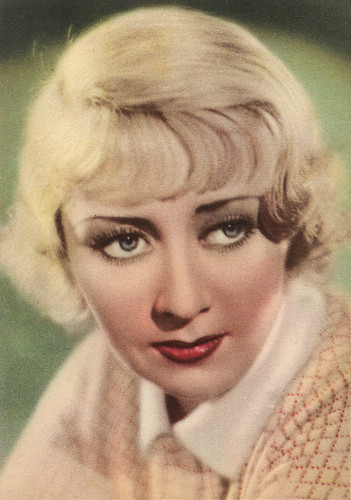
Italian postcard by NMM, Milano, 1941. Caption: Joan Blondel (sic), actress endowed with all the refinements, with a serene face, but full of sweet femininity.
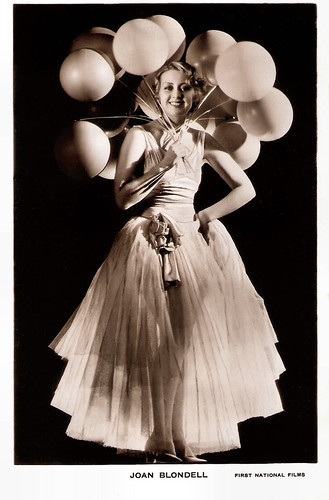
British postcard. Photo: First National Films.
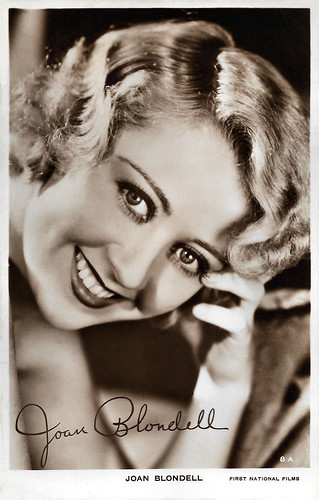
British Real Photograph postcard, no. 8 A. Photo: First National Films.
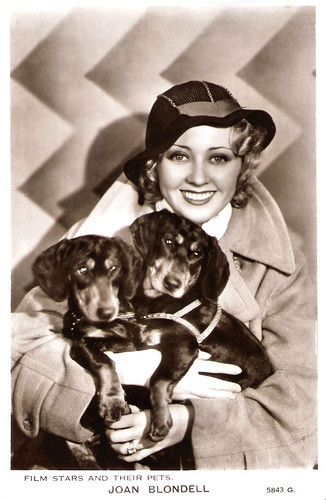
British postcard by Valentine's in the Film Stars and their Pets series, no. 5843 G.
The Bouncing Blondells
Rose Joan Blondell was born to a Vaudeville family in 1906 in Manhattan, New York City. Her father, Levi Bluestein was a vaudeville comedian, known as Ed Blondell. Her mother was Kathryn ('Katie') Cain, and her younger sister, Gloria Blondell, also an actress, was briefly married to film producer Albert R. Broccoli. Blondell also had a brother, Ed Blondell, Jr.
Her parents moved from place to place and Joan made her first appearance on stage at the age of four months when she was carried on in a cradle as the daughter of Peggy Astaire in 'The Greatest Love'. Her family comprised a vaudeville troupe, the 'Bouncing Blondells'. Joan had spent a year in Honolulu (1914–1915) and six years in Australia and had seen much of the world by the time her family settled in Dallas, Texas, when she was a teenager.
Under the name Rosebud Blondell, she won the 1926 Miss Dallas pageant, was a finalist in an early version of the Miss Universe pageant in May 1926, and placed fourth for Miss America 1926. She attended Santa Monica High School. She attended what is now the University of North Texas, then a teacher's college, in Denton, where her mother was a local stage actress.
Around 1927, she returned to New York, worked as a fashion model and a circus hand. She joined a stock company to become an actress. She made her New York debut with the Ziegfeld Follies and appeared in several Broadway productions. In 1930, she starred with James Cagney in 'Penny Arcade' on Broadway. The show lasted only three weeks, but Al Jolson saw it and bought the rights and sold them to Warner Bros. with the proviso that Blondell and Cagney be cast in the film version.
Placed under contract by Warner Bros., she moved to Hollywood. Blondell was paired with James Cagney in Sinners' Holiday (John G. Adolfi, 1930), the film version of 'Penny Arcade' , and it was a success. In The Office Wife (Lloyd Bacon, Michael Curtiz, 1930), she stole the scene when she was dressing for work. She would be teamed with Cagney again in The Public Enemy (William A. Wellman, 1931) and Blonde Crazy (Roy Del Ruth, 1931). That year, Blondell was named as one of the WAMPAS Baby Stars of 1931
During the Great Depression, Blondell was one of the highest-paid individuals in the United States. She co-starred with Dick Powell and Ruby Keeler in the Busby Berkeley hit musical Golddiggers of 1933 (Mervyn LeRoy, 1933). Her stirring rendition of 'Remember My Forgotten Man' became an anthem for the frustrations of the unemployed and the government's failed economic policies.
Establishing herself as a sexy wisecracking blonde, Joan Blondell had become a staple of Warner Brothers. She would be paired with Dick Powell in ten musicals during these years, six films with James Cagney and was one-half of a gold-digging duo with Glenda Farrell in nine films. In 1937, she starred opposite Errol Flynn in The Perfect Specimen (Michael Curtiz, 1937). By the end of the decade, she had made nearly 50 films. She left Warner Bros. in 1939.
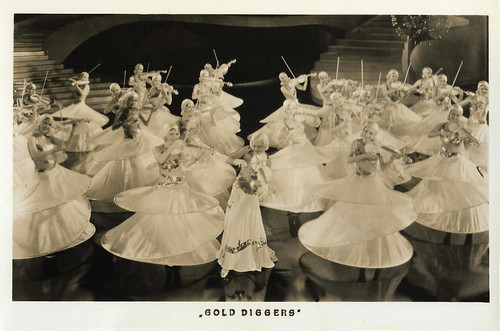
Dutch postcard by City Theater. Sent by mail in 1934. Photo: Warner Bros. Publicity still for Golddiggers of 1933 (Mervyn LeRoy, 1933).
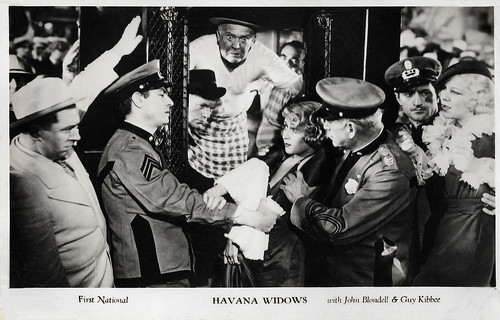
British postcard in the Filmshots series by Film Weekly. Photo: First National. Joan Blondell, Guy Kibbee and Glenda Farrell in Havana Widows (Ray Enright, 1933).
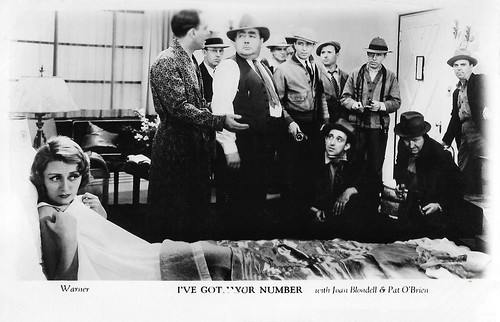
British postcard in the Filmshots series by Film Weekly. Photo: Warner. Joan Blondell and Pat O'Brien in I've got Your Number (Ray Enright, 1934).
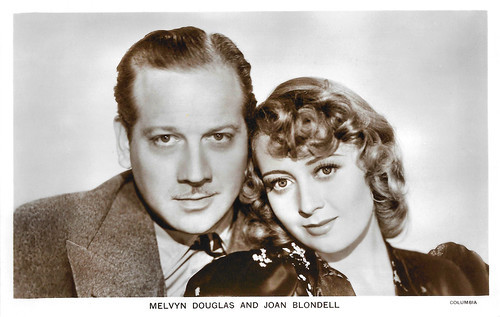
British Real Photograph postcard in the Film Partners Series, London, no. P 245. Photo: Columbia. Melvyn Douglas and Joan Blondell in There's Always a Woman (Alexander Hall, 1938).
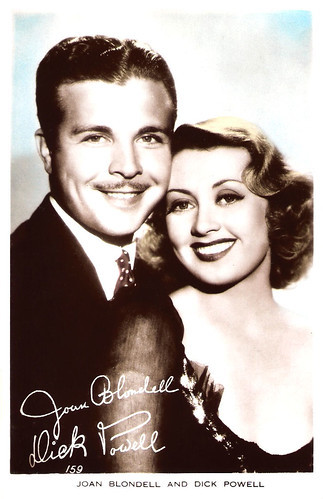
British Art Photo postcard, no. 159. Joan Blondell and Dick Powell
Something for the Boys
In 1943, Joan Blondell returned to Broadway as the star of Mike Todd's short-lived production of 'The Naked Genius', a comedy written by Gypsy Rose Lee.
She was well received in her later films, despite being relegated to character and supporting roles after 1945, when she was billed below the title for the first time in 14 years in Adventure (Victor Fleming, 1945), which starred Clark Gable and Greer Garson . She was also featured prominently in A Tree Grows in Brooklyn (Elia Kazan, 1945) and Nightmare Alley (Edmund Goulding, 1947) starring Tyrone Power .
In 1948, she left the screen for three years and concentrated on theatre, performing in summer stock and touring with Cole Porter's musical, 'Something for the Boys'. She later reprised her role of Aunt Sissy in the musical version of 'A Tree Grows in Brooklyn' for the national tour, starred opposite Tallulah Bankhead in the play 'Crazy October' (which closed on the road) and played the nagging mother, Mae Peterson, in the national tour of 'Bye Bye Birdie'.
Blondell returned to Hollywood in 1950. Her performance in her next film, The Blue Veil (Curtis Bernhardt, Busby Berkeley, 1951) starring Jane Wyman and Charles Laughton , earned her an Academy Award nomination for Best Actress in a Supporting Role. She played supporting roles in The Opposite Sex (1956), Desk Set (1957), and Will Success Spoil Rock Hunter? (Frank Tashlin, 1957) as a mature companion to Jayne Mansfield .
Was nominated for Broadway's 1958 Tony Award as best supporting or featured actress (dramatic) for 'The Rope Dancers'. She received again considerable acclaim for her performance as Lady Fingers in Norman Jewison's The Cincinnati Kid (1965), garnering a Golden Globe nomination and National Board of Review win for Best Supporting Actress.
John Cassavetes cast her as a cynical, ageing playwright in his film Opening Night (1977). Blondell was widely seen in two films released not long before her death, Grease (Randal Kleiser, 1978) starring John Travolta, and the remake of The Champ (Franco Zeffirelli, 1979) with Jon Voight and Rick Schroder. She also appeared in two films released after her death, The Glove (Ross Hagen, 1979) and The Woman Inside (1981).
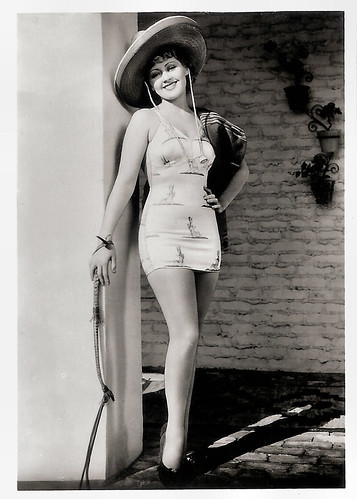
British cigarette card by State Express and Ardath Cigarettes, Series two, number 9. Photo: First National.
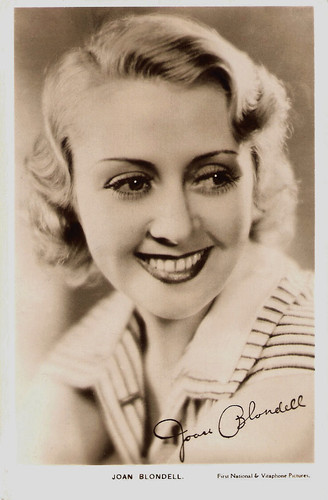
British Real Photograph postcard. Photo: First National & Vitaphone Pictures.
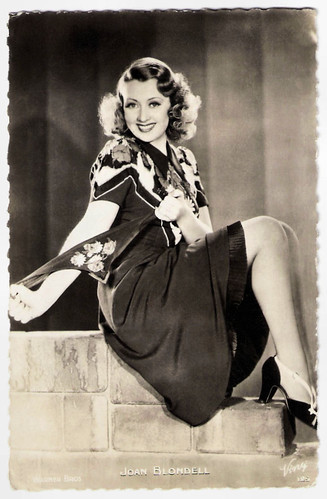
French postcard by Viny, no. 125. Photo: Warner Bros.
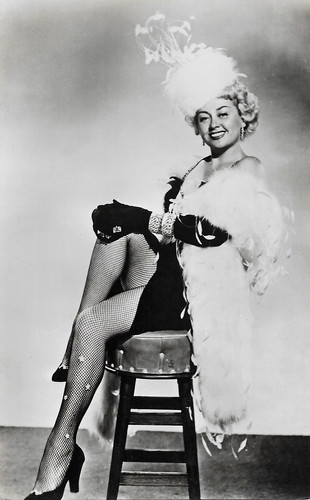
British Best Wishes card. Photo: R.K.O. Radio.
If you don't like it, you can get the hell out
Joan Blondell guest-starred in various television programs, including three 1963 episodes as the character Aunt Win in the CBS sitcom The Real McCoys, starring Walter Brennan and Richard Crenna. In 1964, she appeared in the episode What's in the Box? of The Twilight Zone. She guest-starred with Joe E. Brown and Buster Keaton in the episode You're All Right, Ivy on Jack Palance's circus drama TV series, The Greatest Show on Earth (1963–1964).
In 1965, she was in the running to replace Vivian Vance as Lucille Ball's sidekick on the hit comedy series The Lucy Show. Unfortunately, after filming her second guest appearance as Joan Brenner (Lucy's new friend from California), Blondell walked off the set right after the episode had completed filming when Ball humiliated her by harshly criticising her performance in front of the studio audience and technicians.
Blondell continued working on television. In 1968, she guest-starred on the sitcom Family Affair, starring Brian Keith. She replaced Bea Benaderet, who was ill, for one episode on the CBS series Petticoat Junction. That same year, Blondell co-starred in all 52 episodes of the Western series Here Come the Brides, co-starring singer Bobby Sherman and actor-singer David Soul. Blondell received two consecutive Emmy nominations for outstanding continued performance by an actress in a dramatic series for her role as Lottie Hatfield.
In 1971, she followed Sada Thompson in the off-Broadway hit 'The Effect of Gamma Rays on Man-in-the-Moon Marigolds', with a young Swoosie Kurtz playing one of her daughters. In 1972, she had an ongoing supporting role in the TV series Banyon, starring Robert Forster. Blondell played the wife of Tom D'Andrea's character in the television film, Bobby Parker and Company (1974), featuring Ted Bessell as the son of Blondell and D'Andrea.
Blondell was married three times, first to cinematographer George Barnes in 1933. They had one child — Norman Scott Barnes, who became a producer, director, and television executive — and divorced in 1936. In 1936, she married actor, director, and singer Dick Powell. They had a daughter, Ellen Powell, who became a studio hair stylist, and Powell adopted her son by her previous marriage under the name Norman Scott Powell.
Blondell and Powell were divorced in 1944, and Blondell was less than friendly with Powell's next wife, June Allyson. According to Time magazine (24 July 1944), Blondell divorced Dick Powell on the grounds of cruelty alleging that "when she objected to the incessant coming and going of guests, Powell crooned: 'If you don't like it, you can get the hell out.'"
In 1947, Blondell married her third husband, producer Mike Todd, whom she divorced in 1950. Her marriage to Todd was an emotional and financial disaster. She once accused him of holding her outside a hotel window by her ankles. He was also a heavy spender who lost hundreds of thousands of dollars gambling and went through a controversial bankruptcy during their marriage. While continuing to live the high-life on a huge estate in New York's Westchester County, Todd ran through Blondell's savings.
Joan Blondell wrote a novel, 'Center Door Fancy' (1972), which was a thinly disguised autobiography with veiled references to June Allyson and Dick Powell. Blondell died of leukaemia in Santa Monica, California, on Christmas Day, 1979, with her children and her sister at her bedside. She is interred in the Forest Lawn Memorial Park Cemetery in Glendale, California.
Source: (IMDb), Wikipedia and .

Italian postcard by NMM, Milano, 1941. Caption: Joan Blondel (sic), actress endowed with all the refinements, with a serene face, but full of sweet femininity.

British postcard. Photo: First National Films.

British Real Photograph postcard, no. 8 A. Photo: First National Films.

British postcard by Valentine's in the Film Stars and their Pets series, no. 5843 G.
The Bouncing Blondells
Rose Joan Blondell was born to a Vaudeville family in 1906 in Manhattan, New York City. Her father, Levi Bluestein was a vaudeville comedian, known as Ed Blondell. Her mother was Kathryn ('Katie') Cain, and her younger sister, Gloria Blondell, also an actress, was briefly married to film producer Albert R. Broccoli. Blondell also had a brother, Ed Blondell, Jr.
Her parents moved from place to place and Joan made her first appearance on stage at the age of four months when she was carried on in a cradle as the daughter of Peggy Astaire in 'The Greatest Love'. Her family comprised a vaudeville troupe, the 'Bouncing Blondells'. Joan had spent a year in Honolulu (1914–1915) and six years in Australia and had seen much of the world by the time her family settled in Dallas, Texas, when she was a teenager.
Under the name Rosebud Blondell, she won the 1926 Miss Dallas pageant, was a finalist in an early version of the Miss Universe pageant in May 1926, and placed fourth for Miss America 1926. She attended Santa Monica High School. She attended what is now the University of North Texas, then a teacher's college, in Denton, where her mother was a local stage actress.
Around 1927, she returned to New York, worked as a fashion model and a circus hand. She joined a stock company to become an actress. She made her New York debut with the Ziegfeld Follies and appeared in several Broadway productions. In 1930, she starred with James Cagney in 'Penny Arcade' on Broadway. The show lasted only three weeks, but Al Jolson saw it and bought the rights and sold them to Warner Bros. with the proviso that Blondell and Cagney be cast in the film version.
Placed under contract by Warner Bros., she moved to Hollywood. Blondell was paired with James Cagney in Sinners' Holiday (John G. Adolfi, 1930), the film version of 'Penny Arcade' , and it was a success. In The Office Wife (Lloyd Bacon, Michael Curtiz, 1930), she stole the scene when she was dressing for work. She would be teamed with Cagney again in The Public Enemy (William A. Wellman, 1931) and Blonde Crazy (Roy Del Ruth, 1931). That year, Blondell was named as one of the WAMPAS Baby Stars of 1931
During the Great Depression, Blondell was one of the highest-paid individuals in the United States. She co-starred with Dick Powell and Ruby Keeler in the Busby Berkeley hit musical Golddiggers of 1933 (Mervyn LeRoy, 1933). Her stirring rendition of 'Remember My Forgotten Man' became an anthem for the frustrations of the unemployed and the government's failed economic policies.
Establishing herself as a sexy wisecracking blonde, Joan Blondell had become a staple of Warner Brothers. She would be paired with Dick Powell in ten musicals during these years, six films with James Cagney and was one-half of a gold-digging duo with Glenda Farrell in nine films. In 1937, she starred opposite Errol Flynn in The Perfect Specimen (Michael Curtiz, 1937). By the end of the decade, she had made nearly 50 films. She left Warner Bros. in 1939.

Dutch postcard by City Theater. Sent by mail in 1934. Photo: Warner Bros. Publicity still for Golddiggers of 1933 (Mervyn LeRoy, 1933).

British postcard in the Filmshots series by Film Weekly. Photo: First National. Joan Blondell, Guy Kibbee and Glenda Farrell in Havana Widows (Ray Enright, 1933).

British postcard in the Filmshots series by Film Weekly. Photo: Warner. Joan Blondell and Pat O'Brien in I've got Your Number (Ray Enright, 1934).

British Real Photograph postcard in the Film Partners Series, London, no. P 245. Photo: Columbia. Melvyn Douglas and Joan Blondell in There's Always a Woman (Alexander Hall, 1938).

British Art Photo postcard, no. 159. Joan Blondell and Dick Powell
Something for the Boys
In 1943, Joan Blondell returned to Broadway as the star of Mike Todd's short-lived production of 'The Naked Genius', a comedy written by Gypsy Rose Lee.
She was well received in her later films, despite being relegated to character and supporting roles after 1945, when she was billed below the title for the first time in 14 years in Adventure (Victor Fleming, 1945), which starred Clark Gable and Greer Garson . She was also featured prominently in A Tree Grows in Brooklyn (Elia Kazan, 1945) and Nightmare Alley (Edmund Goulding, 1947) starring Tyrone Power .
In 1948, she left the screen for three years and concentrated on theatre, performing in summer stock and touring with Cole Porter's musical, 'Something for the Boys'. She later reprised her role of Aunt Sissy in the musical version of 'A Tree Grows in Brooklyn' for the national tour, starred opposite Tallulah Bankhead in the play 'Crazy October' (which closed on the road) and played the nagging mother, Mae Peterson, in the national tour of 'Bye Bye Birdie'.
Blondell returned to Hollywood in 1950. Her performance in her next film, The Blue Veil (Curtis Bernhardt, Busby Berkeley, 1951) starring Jane Wyman and Charles Laughton , earned her an Academy Award nomination for Best Actress in a Supporting Role. She played supporting roles in The Opposite Sex (1956), Desk Set (1957), and Will Success Spoil Rock Hunter? (Frank Tashlin, 1957) as a mature companion to Jayne Mansfield .
Was nominated for Broadway's 1958 Tony Award as best supporting or featured actress (dramatic) for 'The Rope Dancers'. She received again considerable acclaim for her performance as Lady Fingers in Norman Jewison's The Cincinnati Kid (1965), garnering a Golden Globe nomination and National Board of Review win for Best Supporting Actress.
John Cassavetes cast her as a cynical, ageing playwright in his film Opening Night (1977). Blondell was widely seen in two films released not long before her death, Grease (Randal Kleiser, 1978) starring John Travolta, and the remake of The Champ (Franco Zeffirelli, 1979) with Jon Voight and Rick Schroder. She also appeared in two films released after her death, The Glove (Ross Hagen, 1979) and The Woman Inside (1981).

British cigarette card by State Express and Ardath Cigarettes, Series two, number 9. Photo: First National.

British Real Photograph postcard. Photo: First National & Vitaphone Pictures.

French postcard by Viny, no. 125. Photo: Warner Bros.

British Best Wishes card. Photo: R.K.O. Radio.
If you don't like it, you can get the hell out
Joan Blondell guest-starred in various television programs, including three 1963 episodes as the character Aunt Win in the CBS sitcom The Real McCoys, starring Walter Brennan and Richard Crenna. In 1964, she appeared in the episode What's in the Box? of The Twilight Zone. She guest-starred with Joe E. Brown and Buster Keaton in the episode You're All Right, Ivy on Jack Palance's circus drama TV series, The Greatest Show on Earth (1963–1964).
In 1965, she was in the running to replace Vivian Vance as Lucille Ball's sidekick on the hit comedy series The Lucy Show. Unfortunately, after filming her second guest appearance as Joan Brenner (Lucy's new friend from California), Blondell walked off the set right after the episode had completed filming when Ball humiliated her by harshly criticising her performance in front of the studio audience and technicians.
Blondell continued working on television. In 1968, she guest-starred on the sitcom Family Affair, starring Brian Keith. She replaced Bea Benaderet, who was ill, for one episode on the CBS series Petticoat Junction. That same year, Blondell co-starred in all 52 episodes of the Western series Here Come the Brides, co-starring singer Bobby Sherman and actor-singer David Soul. Blondell received two consecutive Emmy nominations for outstanding continued performance by an actress in a dramatic series for her role as Lottie Hatfield.
In 1971, she followed Sada Thompson in the off-Broadway hit 'The Effect of Gamma Rays on Man-in-the-Moon Marigolds', with a young Swoosie Kurtz playing one of her daughters. In 1972, she had an ongoing supporting role in the TV series Banyon, starring Robert Forster. Blondell played the wife of Tom D'Andrea's character in the television film, Bobby Parker and Company (1974), featuring Ted Bessell as the son of Blondell and D'Andrea.
Blondell was married three times, first to cinematographer George Barnes in 1933. They had one child — Norman Scott Barnes, who became a producer, director, and television executive — and divorced in 1936. In 1936, she married actor, director, and singer Dick Powell. They had a daughter, Ellen Powell, who became a studio hair stylist, and Powell adopted her son by her previous marriage under the name Norman Scott Powell.
Blondell and Powell were divorced in 1944, and Blondell was less than friendly with Powell's next wife, June Allyson. According to Time magazine (24 July 1944), Blondell divorced Dick Powell on the grounds of cruelty alleging that "when she objected to the incessant coming and going of guests, Powell crooned: 'If you don't like it, you can get the hell out.'"
In 1947, Blondell married her third husband, producer Mike Todd, whom she divorced in 1950. Her marriage to Todd was an emotional and financial disaster. She once accused him of holding her outside a hotel window by her ankles. He was also a heavy spender who lost hundreds of thousands of dollars gambling and went through a controversial bankruptcy during their marriage. While continuing to live the high-life on a huge estate in New York's Westchester County, Todd ran through Blondell's savings.
Joan Blondell wrote a novel, 'Center Door Fancy' (1972), which was a thinly disguised autobiography with veiled references to June Allyson and Dick Powell. Blondell died of leukaemia in Santa Monica, California, on Christmas Day, 1979, with her children and her sister at her bedside. She is interred in the Forest Lawn Memorial Park Cemetery in Glendale, California.
Source: (IMDb), Wikipedia and .
Published on August 31, 2019 22:00
August 30, 2019
Nancy Holloway (1932-2019)
On Wednesday 28 August, American singer and actress Nancy Holloway (1932-2019) passed away. She sang jazz, pop and soul and was popular during the 1960s in France, where she continued to perform and live. She also appeared in a dozen French films. Though born and raised in America, she's virtually unknown in the United States. Holloway was 86.
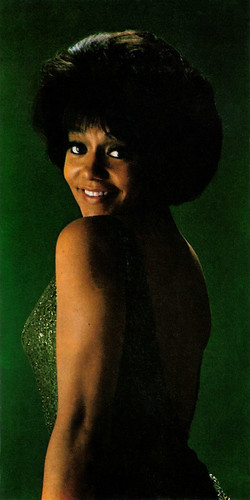
French postcard by Ministar, no. 838. Photo: Patrick de Mervellec.
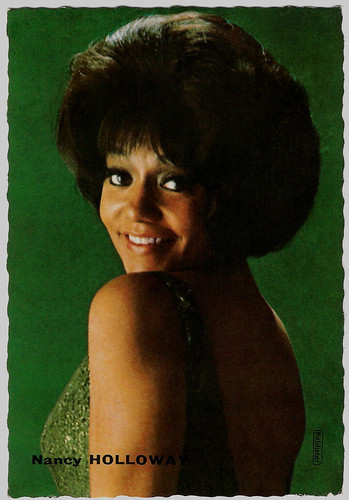
French collectors card by Publistar.
Beige Beauties Troupe
Nancy Holloway was born as Nancy Brown in Cleveland, Ohio, in 1932. She was one of ten children of African American heritage. Holloway's half sister, Mary Holt, was Cleveland's first African-American female radio personality, popular in the 1950s and 1960s.
Nancy attended East Technical High School and at the age of 16, she married. Her husband was controlling and abusive. The marriage would last just three months, but she retained her husband's surname of Holloway for the rest of her life.
Holloway moved to New York City where she waited tables and washed cars. Then she got a job as as a dancer as part of the Beige Beauties troupe. She remained with the dancers for a year and a half.
In 1954, she travelled to France. In Paris, she was persuaded to sing on stage at the jazz nightspot, the Mars Club. Her performance was well received, and she became a regular performer, touring around France, Germany, the UK and Libya before returning to Paris and the Mars Club in 1957.
In 1959, Holloway began singing at the then prestigious Moulin Rouge nightclub, but her real breakthrough followed two years later.
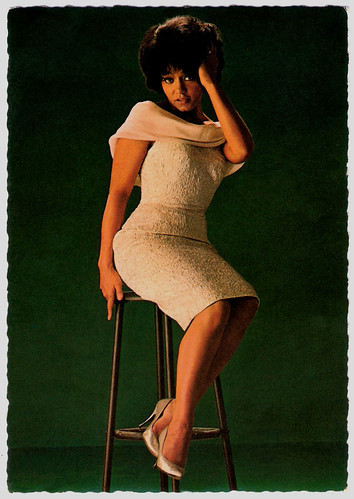
French postcard by Editions Starama, no. S-854. Photo: Patrick de Mervellec.
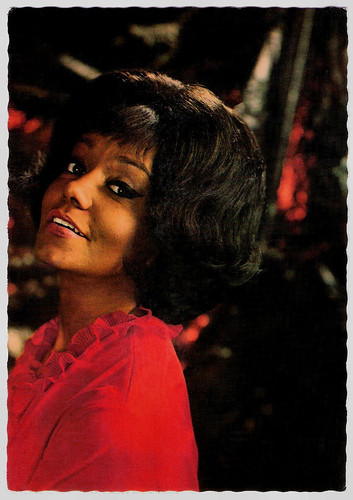
French postcard by E.D.U.G., no. 424. Photo: Nisak / Decca.
Le Boogie du bébé
Encouraged by actor André Pousse, Nancy Holloway made her debut appearance on French television in 1961 and released her first single, 'Le Boogie du bébé' (other sources say 'Hey pony' on the PBM label).
Others hits included 'Fich’ le camp Jack' (a version of Ray Charles’s 'Hit the road Jack'), Dum dum (Brenda Lee’s song of the same name) and 'Viens danser le twist' (Chubby Checker’s 'Let’s twist again'). Many of these early recordings were compiled on an LP issued two years later on the Ricordi label.
In 1961 she opened her own nightclub, Chez Nancy Holloway. Her first film was Ballade pour un voyou (Claude-Jean Bonnardot, 1963), a thriller starring Laurent Terzieff and Hildegard Knef . She also appeared in the Fernandel comedy Blague dans le coin/Joke in the corner (Maurice Labro, 1963).
She was successful as a yé-yé style pop singer with songs like 'Quand un garçon me plaît' (based on 'Big Noise from Winnetka'), 'Dernier baiser' (Nancy’s take on Brian Hyland’s 'Sealed with a Kiss'), and 'T'en vas pas comme ça' (an adaptation of Dionne Warwick’s 'Don't Make Me Over').
As an American singing American songs in a highly American accent, she was uniquely attractive in France. Her American accent only added to her charm. Further successful singles followed through the early and mid-1960s, including 'Bye Bye' (a version of Mary Wells’s US chart topper 'My Guy'), 'Elle t’aime' (a cover of the Beatles 's 'She Loves You'), 'Est-ce que tu m’aimes' (her version of Motown group The Contours’ 'Do You Love Me'), and 'Dis-lui que je ne suis pas là', a duet with Nino Ferrer .
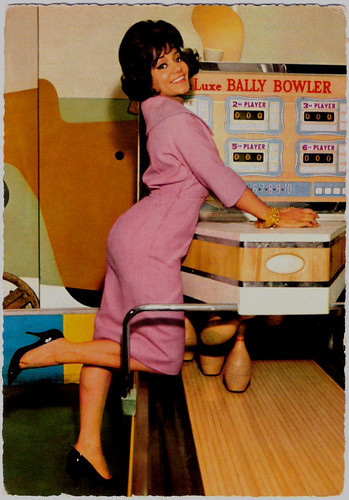
German postcard by Krüger, no. 902/266. Photo: Gérard Neuvecelle.
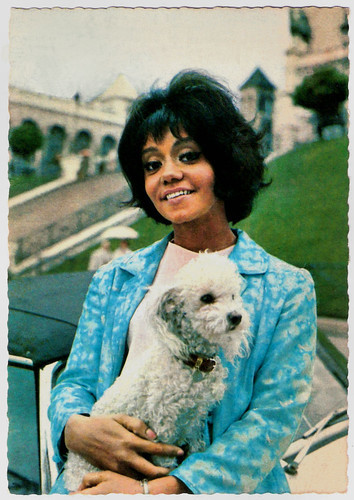
French postcard by E.D.U.G., no. 342. Photo: Gérard Neuvecelle / Decca.
A shift towards show tunes
Nancy Holloway appeared in several films in the early 1960s. Her films included the crime film Le bluffeur/The bluffer (Sergio Gobbi, 1964) with Dany Carrel , the music comedy Cherchez l'idole/The Chase (Michel Boisrond, 1964), and Le gentleman de Cocody/Man from Cocody (Christian-Jaque, 1965), starring Jean Marais .
For a time her acting work overshadowed her singing career though she continued to record. She played the leading role in the drama Les enfants de Caïn/The children of Cain(René Jolivet, 1970) opposite Roland Lesaffre. One of her last films was the the adventure comedy Boulevard du Rhum (Robert Enrico, 1971), starring Brigitte Bardot and Lino Ventura .
Holloway became a respected nightclub performer and appeared with such stars as Sammy Davis Jr., Quincy Jones, and Dizzy Gillespie. In 1969, her album 'Hello Dolly' marked a shift towards show tunes. The album also included 'Mame', 'As long as he needs me' and 'Big spender'.
The death of her baby daughter led to a period of retirement, but she returned as a concert performer in the 1980s. In later life she became an active supporter of AIDS charities.
Nancy Holloway retired from performing in 2008, and died in Paris in 2019, aged 86. She was an aunt of actress-comedienne-writer-vocalist Sandy Brown.
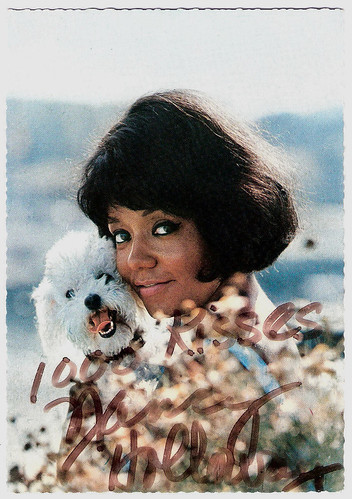
French postcard by Editions CBM, no. 1206 A. Photo: Roger Kasparian.
Nancy Holloway sings 'T'en va pas comme ça'. Source: Costantino (YouTube).
A Scopitone clip with Nancy Holloway performing 'Dum Dum'. Source: ncsboss (YouTube).
Sources: Andrew Hamilton (AllMusic), Ready Steady Girls!, Wikipedia and .

French postcard by Ministar, no. 838. Photo: Patrick de Mervellec.

French collectors card by Publistar.
Beige Beauties Troupe
Nancy Holloway was born as Nancy Brown in Cleveland, Ohio, in 1932. She was one of ten children of African American heritage. Holloway's half sister, Mary Holt, was Cleveland's first African-American female radio personality, popular in the 1950s and 1960s.
Nancy attended East Technical High School and at the age of 16, she married. Her husband was controlling and abusive. The marriage would last just three months, but she retained her husband's surname of Holloway for the rest of her life.
Holloway moved to New York City where she waited tables and washed cars. Then she got a job as as a dancer as part of the Beige Beauties troupe. She remained with the dancers for a year and a half.
In 1954, she travelled to France. In Paris, she was persuaded to sing on stage at the jazz nightspot, the Mars Club. Her performance was well received, and she became a regular performer, touring around France, Germany, the UK and Libya before returning to Paris and the Mars Club in 1957.
In 1959, Holloway began singing at the then prestigious Moulin Rouge nightclub, but her real breakthrough followed two years later.

French postcard by Editions Starama, no. S-854. Photo: Patrick de Mervellec.

French postcard by E.D.U.G., no. 424. Photo: Nisak / Decca.
Le Boogie du bébé
Encouraged by actor André Pousse, Nancy Holloway made her debut appearance on French television in 1961 and released her first single, 'Le Boogie du bébé' (other sources say 'Hey pony' on the PBM label).
Others hits included 'Fich’ le camp Jack' (a version of Ray Charles’s 'Hit the road Jack'), Dum dum (Brenda Lee’s song of the same name) and 'Viens danser le twist' (Chubby Checker’s 'Let’s twist again'). Many of these early recordings were compiled on an LP issued two years later on the Ricordi label.
In 1961 she opened her own nightclub, Chez Nancy Holloway. Her first film was Ballade pour un voyou (Claude-Jean Bonnardot, 1963), a thriller starring Laurent Terzieff and Hildegard Knef . She also appeared in the Fernandel comedy Blague dans le coin/Joke in the corner (Maurice Labro, 1963).
She was successful as a yé-yé style pop singer with songs like 'Quand un garçon me plaît' (based on 'Big Noise from Winnetka'), 'Dernier baiser' (Nancy’s take on Brian Hyland’s 'Sealed with a Kiss'), and 'T'en vas pas comme ça' (an adaptation of Dionne Warwick’s 'Don't Make Me Over').
As an American singing American songs in a highly American accent, she was uniquely attractive in France. Her American accent only added to her charm. Further successful singles followed through the early and mid-1960s, including 'Bye Bye' (a version of Mary Wells’s US chart topper 'My Guy'), 'Elle t’aime' (a cover of the Beatles 's 'She Loves You'), 'Est-ce que tu m’aimes' (her version of Motown group The Contours’ 'Do You Love Me'), and 'Dis-lui que je ne suis pas là', a duet with Nino Ferrer .

German postcard by Krüger, no. 902/266. Photo: Gérard Neuvecelle.

French postcard by E.D.U.G., no. 342. Photo: Gérard Neuvecelle / Decca.
A shift towards show tunes
Nancy Holloway appeared in several films in the early 1960s. Her films included the crime film Le bluffeur/The bluffer (Sergio Gobbi, 1964) with Dany Carrel , the music comedy Cherchez l'idole/The Chase (Michel Boisrond, 1964), and Le gentleman de Cocody/Man from Cocody (Christian-Jaque, 1965), starring Jean Marais .
For a time her acting work overshadowed her singing career though she continued to record. She played the leading role in the drama Les enfants de Caïn/The children of Cain(René Jolivet, 1970) opposite Roland Lesaffre. One of her last films was the the adventure comedy Boulevard du Rhum (Robert Enrico, 1971), starring Brigitte Bardot and Lino Ventura .
Holloway became a respected nightclub performer and appeared with such stars as Sammy Davis Jr., Quincy Jones, and Dizzy Gillespie. In 1969, her album 'Hello Dolly' marked a shift towards show tunes. The album also included 'Mame', 'As long as he needs me' and 'Big spender'.
The death of her baby daughter led to a period of retirement, but she returned as a concert performer in the 1980s. In later life she became an active supporter of AIDS charities.
Nancy Holloway retired from performing in 2008, and died in Paris in 2019, aged 86. She was an aunt of actress-comedienne-writer-vocalist Sandy Brown.

French postcard by Editions CBM, no. 1206 A. Photo: Roger Kasparian.
Nancy Holloway sings 'T'en va pas comme ça'. Source: Costantino (YouTube).
A Scopitone clip with Nancy Holloway performing 'Dum Dum'. Source: ncsboss (YouTube).
Sources: Andrew Hamilton (AllMusic), Ready Steady Girls!, Wikipedia and .
Published on August 30, 2019 22:00
August 29, 2019
Chocolates and postcards
Ivo Blom, who celebrates his birthday today, likes to collect the sepia postcards by Belgian cacao and chocolate firm Kivou, based in Vilvoorde. Belgium is the country of the chocolateries and many of these firms produced film star postcards as gifts for their customers. Kivou probably presented this postcard series with both European and Hollywood film stars, published circa 1930. For this post, I selected 15 postcards with known and some less known stars. Happy birthday, Ivo!

Belgian postcard by S.A. Cacao et Chocolat Kivou, Vilvoorde / N.V. Cacao en Chocolade Kivou, Vilvoorde. Photo: Ufa.
Pretty Austrian actress Jenny Jugo (1904-2001) starred between 1931 and 1942 in eleven smart and charming comedies directed by Erich Engel.
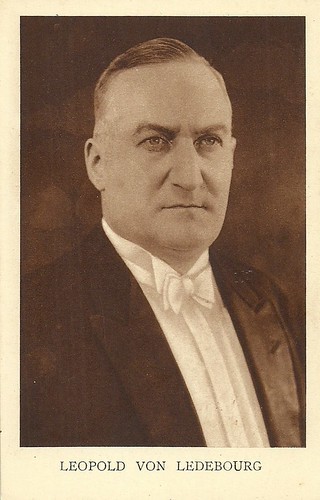
Belgian postcard by S.A. Cacao et Chocolat Kivou, Vilvoorde / N.V. Cacao en Chocolade Kivou, Vilvoorde. The actor's name is misspelled on the card.
Leopold von Ledebur (1876-1955) was a German stage and film actor. Ledebur started on stage from 1906 and on the film set from 1916. His first major part he had as the toreador Escamillo in Lubitsch's Carmen (1918), starring Pola Negri . During his long career, he hardly ever was the star of the film but always a supporting actor, mostly representing respectable persons such as ministers, directors, generals, commissioners, judges, doctors, and estate owners.
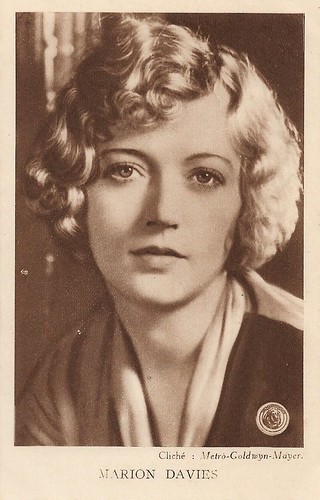
Belgian postcard by S.A. Cacao et Chocolat Kivou, Vilvoorde / N.V. Cacao en Chocolade Kivou, Vilvoorde. Photo: Metro-Goldwyn-Mayer.
Marion Davies (1897-1961) was one of the great comedic actresses of the silent era. She starred in nearly four dozen films between 1917 and 1937.
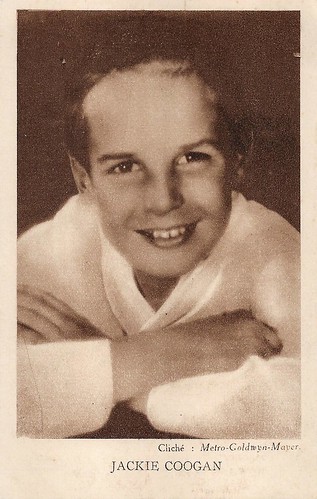
Belgian postcard by S.A. Cacao et Chocolat Kivou, Vilvoorde / N.V. Cacao en Chocolade Kivou, Vilvoorde. Photo: Metro-Goldwyn-Mayer (MGM).
American actor Jackie Coogan (1914-1984) began as a child star in silent films. He was Charlie Chaplin's irascible sidekick in The Kid (Charles Chaplin, 1921) and played the title role in Oliver Twist (Frank Lloyd, 1922). Many years later, he became known as Uncle Fester in the TV series The Addams Family (1964-1966).
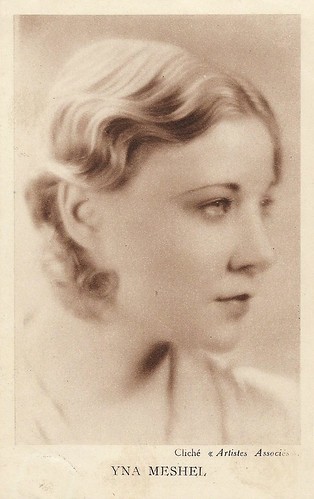
Belgian postcard by S.A. Cacao et Chocolat Kivou, Vilvo[o]rde, Belgium. Una Merkel's name is seriously misspelled on the card.
Una Merkel (1903–1986) was an American stage, film, radio, and television actress. In 1930 she starred in David Wark Griffith's biopic Abraham Lincoln. In the following years, Merkel played numerous, mostly comical supporting roles, often as the wisecracking best friend of the heroine. One of her most famous roles was in Destry Rides Again (George Marshall, 1939), in which she delivers a 'cat-fight' with Marlene Dietrich .
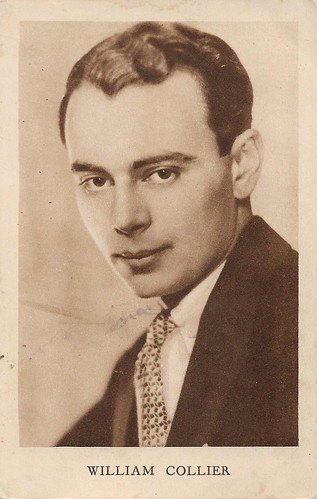
Belgian postcard by S.A. Cacao et Chocolat Kivou, Vilvo[o]rde, Belgium.
William Collier Jr. (1902–1987) was an American film actor, who starred in almost 90 films. From 1916 on, he appeared opposite female stars such as Olive Thomas, Shirley Mason, and Greta Nissen. Collier also starred in The Wanderer (Raoul Walsh, 1925), inspired by the Old Testament tale of the prodigal son.
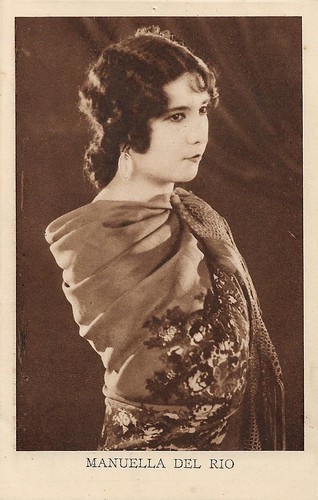
Belgian postcard by S.A. Cacao et Chocolat Kivou, Vilvo[o]rde, Belgium. The name Manuela Del Rio is misspelled on the card.
Manuela Del Rio is known only for one film: the British film Life (Adelqui Migliar/Millar, 1928), shot on location in Spain. In the film, a sacked bricklayer (Migliar) steals for a dancer (Del Rio) and breaks jail to kill her when she becomes his former employer's mistress.
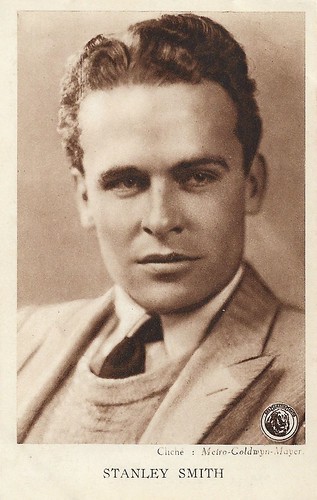
Belgian postcard by S.A. Cacao et Chocolat Kivou, Vilvo[o]rde, Belgium.
Stanley Smith (1903-1974) was an American screen actor, who played leading man to Nancy Carroll, Clara Bow, and Ginger Rogers in the days of the early talkies. Smith had his breakthrough in the early sound film The Sophomore (Leo McCarey, 1929) with Eddie Quillan and Sally O'Neill, while by the mid-1930s his career petered out. During the war years, he had a handful of bit parts and he quited acting in 1943.
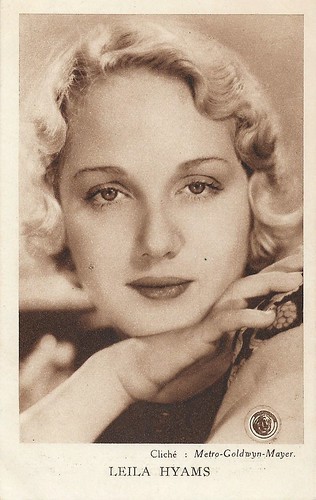
Belgian postcard by S.A. Cacao et Chocolat Kivou, Vilvo[o]rde, Belgium.
Charming American model, vaudeville and film actress Leila Hyams (1905-1977) was one of Hollywood's top leading ladies of the early talkie pre-code years. She had spark, personality and charisma, and a touch of down-to-earthiness and naturalness that won over many film fans; they could relate to her. She is best known for her roles in the classic horror features Freaks (Tod Browning, 1932) and Island of Lost Souls (Erle C. Kenton, 1932). Her career lasted little more than a decade.
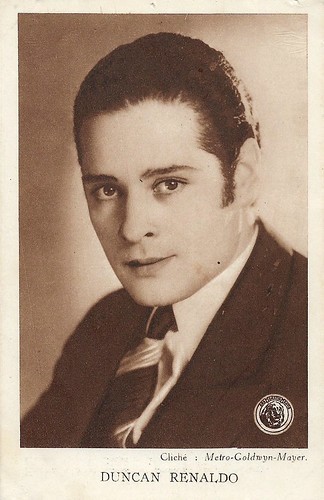
Belgian postcard by S.A. Cacao et Chocolat Kivou, Vilvo[o]rde, Belgium.
Renault Renaldo Duncan (1904–1980), better known as Duncan Renaldo, was a Romanian-born American actor. Renaldo began filming in three Hollywood films released in 1928. Sixty-eight films followed, including The Bridge of San Luis Rey (Charles Brabim, 1929), with Lily Damita and Ernest Torrence , and Trader Horn (W.S. Van Dyke, 1931) starring Harry Carey. Renaldo is best remembered as The Cisco Kid in many Westerns and the 1950-1956 American TV series.
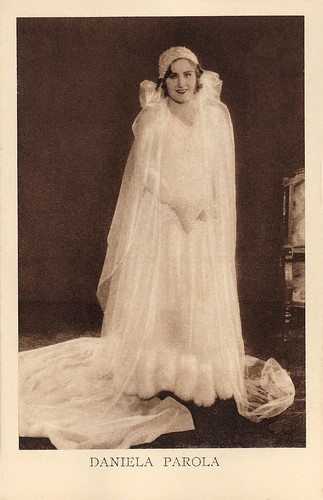
Belgian postcard by S.A. Cacao et Chocolat Kivou, Vilvoorde / N.V. Cacao en Chocolade Kivou, Vilvoorde.
Danièle Parola (1905-1998) was a French film actress, who starred in the crime film Stupéfiants/Narcotics (Kurt Gerron, Roger Le Bon, 1932). Between 1928 and 1937, she appeared in some 20 films.
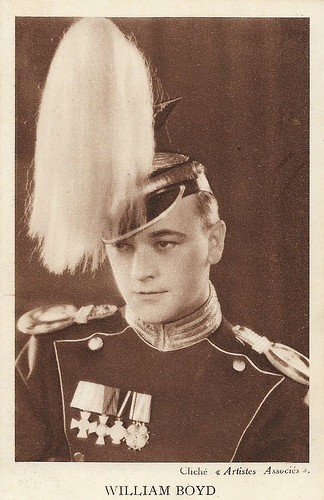
Belgian postcard by S.A. Cacao et Chocolat Kivou, Vilvoorde / N.V. Cacao en Chocolade Kivou, Vilvoorde. Photo: Artistes Associés (United Artists).
American film actor William Boyd (1895-1972) was during the 1920s a matinee idol beloved for his easy charm, charisma, and intense good-looks. Boyd had his breakthrough as Jack Moreland in The Road to Yesterday (Cecil B. DeMille, 1925), and the highly successful silent drama, The Volga Boatman (Cecil B. DeMille, 1926). Now he is best known as the cowboy Hopalong Cassidy in the eponymous Western film series.
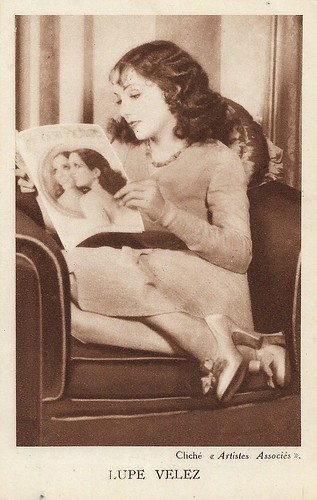
Belgian postcard by S.A. Cacao et Chocolat Kivou, Vilvoorde / N.V. Cacao en Chocolade Kivou, Vilvoorde. Photo: Artistes Associés (United Artists).
Lupe Velez (1908-1944) was one of the first Mexican actresses to succeed in Hollywood. Her nicknames were 'The Mexican Spitfire' and 'Hot Pepper'.
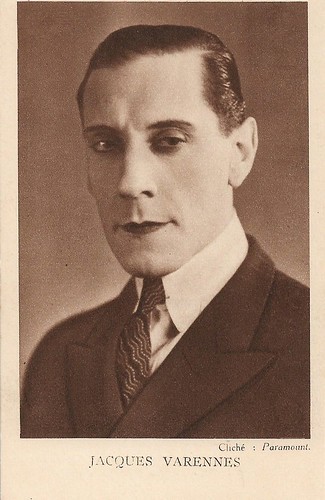
Belgian postcard by S.A. Cacao et Chocolat Kivou, Vilvoorde / N.V. Cacao en Chocolade Kivou, Vilvoorde. Photo: Paramount.
French film actor Jacques Varennes (1894–1958) appeared in around seventy films during his career. After a series of shorts for Pathé in 1909, he returned to the film set when sound film had set in. His first sound film was Les Vacances du diable (Alberto Cavalcanti, 1930), made at the Parisian Paramount studios. From the 1940s, he often acted with Sacha Guitry .
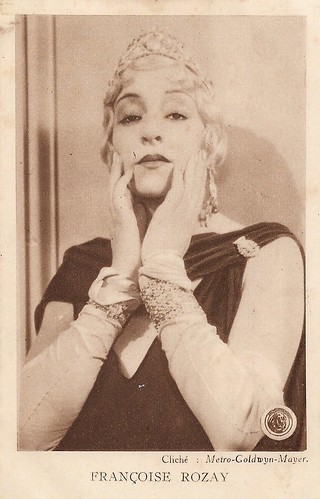
Belgian postcard by S.A. Cacao et Chocolat Kivou, Vilvoorde / N.V. Cacao en Chocolade Kivou, Vilvoorde. Photo: Metro-Goldwyn-Mayer.
Françoise Rosay (1891-1974) was the grand old lady of French cinema. Her most famous parts were in La kermesse heroïque (1935) and Pension Mimosas (1935), both directed by her husband Jacques Feyder.
Check out Ivo's Kivou postcards at Flickr.

Belgian postcard by S.A. Cacao et Chocolat Kivou, Vilvoorde / N.V. Cacao en Chocolade Kivou, Vilvoorde. Photo: Ufa.
Pretty Austrian actress Jenny Jugo (1904-2001) starred between 1931 and 1942 in eleven smart and charming comedies directed by Erich Engel.

Belgian postcard by S.A. Cacao et Chocolat Kivou, Vilvoorde / N.V. Cacao en Chocolade Kivou, Vilvoorde. The actor's name is misspelled on the card.
Leopold von Ledebur (1876-1955) was a German stage and film actor. Ledebur started on stage from 1906 and on the film set from 1916. His first major part he had as the toreador Escamillo in Lubitsch's Carmen (1918), starring Pola Negri . During his long career, he hardly ever was the star of the film but always a supporting actor, mostly representing respectable persons such as ministers, directors, generals, commissioners, judges, doctors, and estate owners.

Belgian postcard by S.A. Cacao et Chocolat Kivou, Vilvoorde / N.V. Cacao en Chocolade Kivou, Vilvoorde. Photo: Metro-Goldwyn-Mayer.
Marion Davies (1897-1961) was one of the great comedic actresses of the silent era. She starred in nearly four dozen films between 1917 and 1937.

Belgian postcard by S.A. Cacao et Chocolat Kivou, Vilvoorde / N.V. Cacao en Chocolade Kivou, Vilvoorde. Photo: Metro-Goldwyn-Mayer (MGM).
American actor Jackie Coogan (1914-1984) began as a child star in silent films. He was Charlie Chaplin's irascible sidekick in The Kid (Charles Chaplin, 1921) and played the title role in Oliver Twist (Frank Lloyd, 1922). Many years later, he became known as Uncle Fester in the TV series The Addams Family (1964-1966).

Belgian postcard by S.A. Cacao et Chocolat Kivou, Vilvo[o]rde, Belgium. Una Merkel's name is seriously misspelled on the card.
Una Merkel (1903–1986) was an American stage, film, radio, and television actress. In 1930 she starred in David Wark Griffith's biopic Abraham Lincoln. In the following years, Merkel played numerous, mostly comical supporting roles, often as the wisecracking best friend of the heroine. One of her most famous roles was in Destry Rides Again (George Marshall, 1939), in which she delivers a 'cat-fight' with Marlene Dietrich .

Belgian postcard by S.A. Cacao et Chocolat Kivou, Vilvo[o]rde, Belgium.
William Collier Jr. (1902–1987) was an American film actor, who starred in almost 90 films. From 1916 on, he appeared opposite female stars such as Olive Thomas, Shirley Mason, and Greta Nissen. Collier also starred in The Wanderer (Raoul Walsh, 1925), inspired by the Old Testament tale of the prodigal son.

Belgian postcard by S.A. Cacao et Chocolat Kivou, Vilvo[o]rde, Belgium. The name Manuela Del Rio is misspelled on the card.
Manuela Del Rio is known only for one film: the British film Life (Adelqui Migliar/Millar, 1928), shot on location in Spain. In the film, a sacked bricklayer (Migliar) steals for a dancer (Del Rio) and breaks jail to kill her when she becomes his former employer's mistress.

Belgian postcard by S.A. Cacao et Chocolat Kivou, Vilvo[o]rde, Belgium.
Stanley Smith (1903-1974) was an American screen actor, who played leading man to Nancy Carroll, Clara Bow, and Ginger Rogers in the days of the early talkies. Smith had his breakthrough in the early sound film The Sophomore (Leo McCarey, 1929) with Eddie Quillan and Sally O'Neill, while by the mid-1930s his career petered out. During the war years, he had a handful of bit parts and he quited acting in 1943.

Belgian postcard by S.A. Cacao et Chocolat Kivou, Vilvo[o]rde, Belgium.
Charming American model, vaudeville and film actress Leila Hyams (1905-1977) was one of Hollywood's top leading ladies of the early talkie pre-code years. She had spark, personality and charisma, and a touch of down-to-earthiness and naturalness that won over many film fans; they could relate to her. She is best known for her roles in the classic horror features Freaks (Tod Browning, 1932) and Island of Lost Souls (Erle C. Kenton, 1932). Her career lasted little more than a decade.

Belgian postcard by S.A. Cacao et Chocolat Kivou, Vilvo[o]rde, Belgium.
Renault Renaldo Duncan (1904–1980), better known as Duncan Renaldo, was a Romanian-born American actor. Renaldo began filming in three Hollywood films released in 1928. Sixty-eight films followed, including The Bridge of San Luis Rey (Charles Brabim, 1929), with Lily Damita and Ernest Torrence , and Trader Horn (W.S. Van Dyke, 1931) starring Harry Carey. Renaldo is best remembered as The Cisco Kid in many Westerns and the 1950-1956 American TV series.

Belgian postcard by S.A. Cacao et Chocolat Kivou, Vilvoorde / N.V. Cacao en Chocolade Kivou, Vilvoorde.
Danièle Parola (1905-1998) was a French film actress, who starred in the crime film Stupéfiants/Narcotics (Kurt Gerron, Roger Le Bon, 1932). Between 1928 and 1937, she appeared in some 20 films.

Belgian postcard by S.A. Cacao et Chocolat Kivou, Vilvoorde / N.V. Cacao en Chocolade Kivou, Vilvoorde. Photo: Artistes Associés (United Artists).
American film actor William Boyd (1895-1972) was during the 1920s a matinee idol beloved for his easy charm, charisma, and intense good-looks. Boyd had his breakthrough as Jack Moreland in The Road to Yesterday (Cecil B. DeMille, 1925), and the highly successful silent drama, The Volga Boatman (Cecil B. DeMille, 1926). Now he is best known as the cowboy Hopalong Cassidy in the eponymous Western film series.

Belgian postcard by S.A. Cacao et Chocolat Kivou, Vilvoorde / N.V. Cacao en Chocolade Kivou, Vilvoorde. Photo: Artistes Associés (United Artists).
Lupe Velez (1908-1944) was one of the first Mexican actresses to succeed in Hollywood. Her nicknames were 'The Mexican Spitfire' and 'Hot Pepper'.

Belgian postcard by S.A. Cacao et Chocolat Kivou, Vilvoorde / N.V. Cacao en Chocolade Kivou, Vilvoorde. Photo: Paramount.
French film actor Jacques Varennes (1894–1958) appeared in around seventy films during his career. After a series of shorts for Pathé in 1909, he returned to the film set when sound film had set in. His first sound film was Les Vacances du diable (Alberto Cavalcanti, 1930), made at the Parisian Paramount studios. From the 1940s, he often acted with Sacha Guitry .

Belgian postcard by S.A. Cacao et Chocolat Kivou, Vilvoorde / N.V. Cacao en Chocolade Kivou, Vilvoorde. Photo: Metro-Goldwyn-Mayer.
Françoise Rosay (1891-1974) was the grand old lady of French cinema. Her most famous parts were in La kermesse heroïque (1935) and Pension Mimosas (1935), both directed by her husband Jacques Feyder.
Check out Ivo's Kivou postcards at Flickr.
Published on August 29, 2019 22:00
August 28, 2019
Was Rex Ingram a visionary film maker or a dangerous maverick?
After a hickup last Thursday, we continue our Summer series on more or less recent film books. In 'Rex Ingram - Visionary director of the Silent Screen' (2014), Irish scholar Ruth Barton explores the life and legacy of the pioneering filmmaker Rex Ingram (1893-1950). Alongside D. W. Griffith, Cecil B. De Mille, and Erich von Stroheim, he was one of the greatest artists of silent Hollywood. Ingram directed such smash hits as The Four Horsemen of the Apocalypse (1921), The Prisoner of Zenda (1922), and Scaramouche (1923). His films made stars of Rudolph Valentino, Ramón Novarro, and Alice Terry ― who also became his second wife. After Scaramouche, Ingram went into a self-imposed exile on the French Riviera. Thanks to his box office successes, Ingram's career flourished throughout the 1920s, although Louis B. Mayer regarded him as a dangerous maverick.
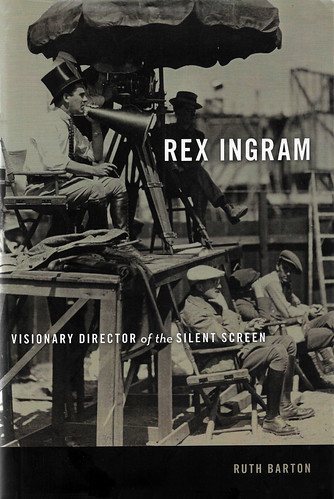
Book cover for Ruth Barton, 'Rex Ingram - Visionary director of the silent screen' (2014). Publisher: University Press of Kentucky.
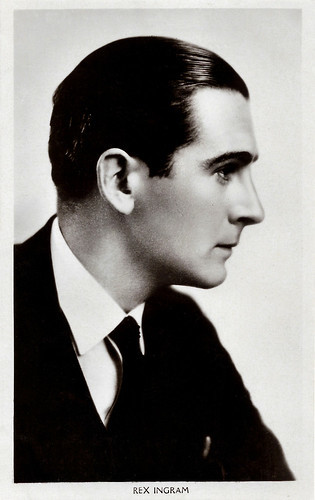
British postcard in the Picturegoer Series, London, no. 137.
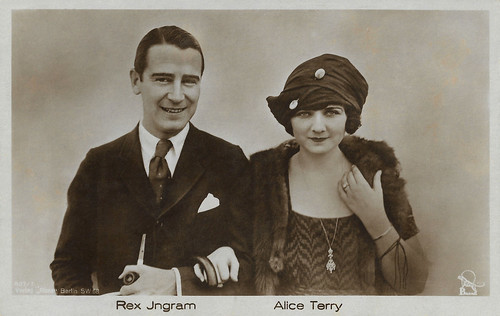
Rex Ingram and Alice Terry. German postcard by Ross Verlag, Berlin, no. 807/1, 1925-1926. Photo: Bafag.

Italian postcard by Ed. A. Traldi, no. 88. Photo: Le grandi films Virginio Rebua, Milano. The postcard claims this is Ramon Novarro, but it is Rex Ingram. Ingram directed Novarro in various early 1920s films, such as The Prisoner of Zenda (1922), Where the Pavement Ends (1923), Scaramouche (1923), and The Arab (1924).
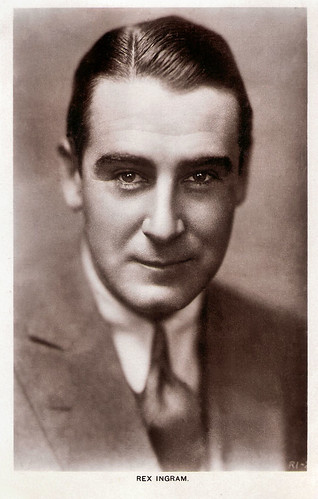
British postcard in the Picturegoer Series, London, no. 137a.
A fascination for the bizarre and the grotesque
Rex Ingram was born in 1893 as Reginald Ingram Montgomery Hitchcock in Rathmines, now part of Dublin, Ireland. He spent much of his adolescence living in the Old Rectory, Kinnitty, Birr, County Offaly where his father was the Church of Ireland rector. When the sensitive Rex was 15, his sickly mother died. Biographer Ruth Barton suggests that this lead to his later portraying women as either pure-hearted souls or tempting sirens. Barton had access to Ingram's memoirs which gave her insight into his life. Her book focuses on telling the compelling narrative of Ingram’s life and links it often with his work.
Ingram's father tried to push him into business, but Rex wanted to be an artist. After failing to get into Trinity College Dublin, much to his father’s shame, he emigrated in 1911 to the United States. He was 18 and studied briefly sculpture at the Yale University School of Art, where he also contributed to The Yale Record, a campus humour magazine. In New York, Rex met the son of inventor and film pioneer Thomas Edison, and he decided to move into the new movie business. From 1913, the handsome young Irishman acted in silent films for the Edison studios, and in 1915, he took his mother’s name, Ingram, as his surname. So interestingly he changed his name Hitchcock in order to break into the cinema. Barton however suggests that the name change was meant as a firm break with his father's ambitions for him.
After Edison, he worked with legendary director D.W. Griffith at the Biograph Studios for a while. Ingram later also worked for Vitagraph, Fox and Universal. Soon he took on writing, producing and directing jobs, directing mainly action or supernatural films. His first film as producer-director was the romantic drama The Great Problem (Rex Ingram, 1916) with Violet Mersereau. In his following films such as Black Orchids (Rex Ingram, 1917) with Cleo Madison, The Little Terror (Rex Ingram, 1917) and The Flower of Doom (Rex Ingram, 1917), he showed a fascination for the bizarre and the grotesque.
In 1920, Rex Ingram moved to Metro. There, he was under supervision of executive June Mathis. Together, they hired young Italian immigrant dancer Rudolph Valentino to star in The Four Horsemen of the Apocalypse (Rex Ingram, 1921) opposite Alice Terry. Valentino's film's sizzling tango sequence turned the film into a smash hit. Mathis and Ingram would make four films together, also Hearts are Trump (Rex Ingram, 1920) again with Alice Terry, The Conquering Power (Rex Ingram, 1921) with Valentino and Terry, and Turn to the Right (Rex Ingram, 1922).
After Valentino left Metro for Paramount, Rex Ingram needed a new leading man, and took a chance on a young, handsome Mexican, who would become Ramon Novarro . With his role as the villain Rupert von Hentzau in The Prisoner of Zenda (Rex Ingram, 1922) he became Ingram's new star. Ingram also gathered a steady technical crew around him. Very important for his films would be cameraman John Seitz, who invented the matte painting. Also very important for Ingram's films was his editor, Grant Whytock.
Ruth Barton describes how Ingram and his crew worked. The Prisoner of Zenda features careful lighting, well-placed props, and a novel 3-D effect. In one shot, two soldiers drink and play cards. Behind them, to the right, a military statue stands out, in focus. Still farther back in the room, and to the left, a young man plays piano. It is Ramon Novarro . Almost a painting, the effect is multi-dimensional.
On 5 November 1921, Ingram and Alice Terry were married in Adobe Flores in South Pasadena. It was on a Saturday and they sneaked off the set of The Prisoner of Zenda (Rex Ingram, 1922) without telling anyone. The next day they saw three films and went back to work on Monday. When the film was completed, they went to San Francisco for their honeymoon. Ruth Barton speaks of his rumoured bisexuality, but it remains unconfirmed. In his work you can see undertones of what was probably an actively bisexual life.
Ingram's films contain splendid flashes of macabre fantasy, such as the ride of the Four Horsemen in the Valentino epic, or the 'ghoul visions' that bring about the death of the miser in The Conquering Power (Rex Ingram, 1921). His more or less mystical bent was later apparent in Mare Nostrum (Rex Ingram, 1926) and The Garden of Allah (Rex Ingram, 1927), which he filmed in the Mediterranean and North Africa, respectively.

Spanish collectors card by Chocolate Amatller, Series EE, Artist 40, no. 82.

Spanish collectors card by Chocolate Amatller, Series EE, artist 41, no. 83. Lewis Stone In The Prisoner of Zenda (Rex Ingram, 1922).
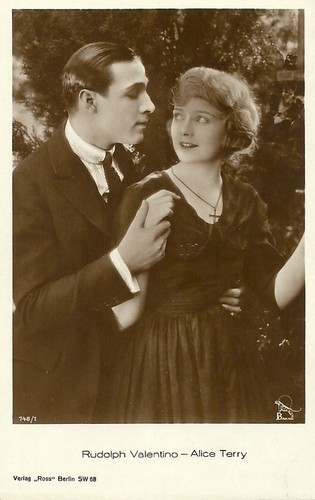
German postcard by Ross Verlag, no. 748/1. Photo: Bafag. Rudolph Valentino and Alice Terry in The Conquering Power (Rex Ingram, 1921).

German postcard by Ross Verlag, no. 679/4. Lewis Stone as Rudolph Rassendyll and Alice Terry as Princess Flavia in The Prisoner of Zenda (Rex Ingram, 1922). Stuart Holmes is the man in black on the right. The Bismarck-like guy behind Terry is the actor Robert Edeson, who plays Colonel Sapt. Behind him is actor Malcolm McGregor, who plays Captain Fritz von Tarlenheim. Both are the loyal aids of the King, defending him against his evil half-brother Michael (Stuart Holmes) and his plotting cronies: his mistress Antoinette (Barbara la Marr) and Rupert von Hentzau ( Ramon Novarro ). Trying to stop a coup by Michael, who has abducted and imprisoned the real king, Sapt and Tarlenheim arrange a lookalike cousin of the king to be crowned (which we see on this card). The substitute king falls in love with Princess Flavia but he cannot tell the truth... Stone played both the King and his lookalike.
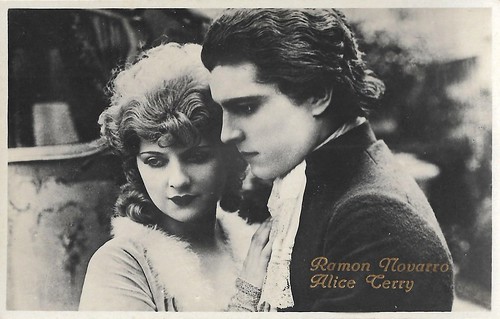
Italian postcard by G.B. Falci, Milano, no. 447. Ramon Novarro and Alice Terry in the Metro Pictures production Scaramouche (Rex Ingram, 1923).
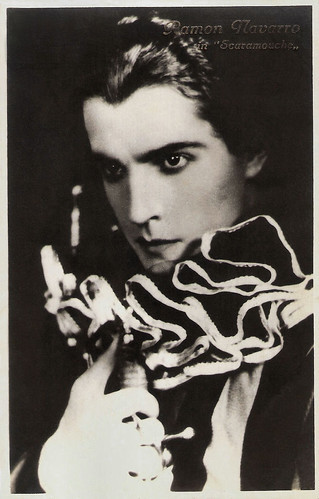
Italian postcard by G.B. Falci, Milano, no. 457. Ramon Novaro in Scaramouche (Rex Ingram, 1923).
Converting to the Islam
In 1923, the restless Rex Ingram and Alice Terry relocated to the French Riviera. They hired the Victorine Studio, a small studio in Nice and made several films on location in North Africa, Spain, and Italy for MGM and other studios. Outside the view of the movie moguls he created such films as Mare Nostrum (Rex Ingram, 1926), The Garden of Allah (Rex Ingram, 1927) and The Three Passions (Rex Ingram, 1929).
Amongst those who worked for Ingram at MGM on the Riviera during this period was the young Michael Powell, who later went on to direct (with Emeric Pressburger) The Red Shoes (1948) and other classics, and technician Leonti Planskoy. By Powell's own account, Ingram was a major influence on him, especially in its themes in illusion, dreaming, magic and the surreal. Also director David Lean said he was indebted to Ingram. And MGM studio chief Dore Schary listed the top creative people in Hollywood as D. W. Griffith, Ingram, Cecil B. DeMille and Erich von Stroheim (in declining order of importance). Von Stroheim however called Ingram the "world's greatest director..."
In 1926, Ingram made The Magician, starring Paul 'Der Golem' Wegener . Although Wegener's acting was already old-fashioned, Ingram slowly builds the film to a rousing climax. Flashing lightning surrounds an old castle, where the magician battles the young hero ( Ivan Petrovich ). Earlier, the young heroine (Alice Terry) is transported to an underworld dream-land, complete with Pan, the Devil, and a host of partially dressed dancers. The Magician was successful, but Louis B. Mayer ended Ingram's career at MGM.
Was Ingram the dangerous maverick which Mayer saw in him? Or was he the true visionary, as Ruth Barton claims. To be honest, I can't judge this while I did not see enough films by Ingram yet. During the 1920s, film critics praised the pictorial qualities of his work but also commented on the lack of dramatic pacing and the unrounded characterisation. Barton convinced me that Ingram was a complex figure who cannot be easily categorised. His temperament was volatile and his working periods at the various studios were short. Invariably, he fell out with superiors and co-workers. Barton describes him as a charming, talented but also difficult and demanding artist. The more earth-bound Alice Terry kept the tyrannical perfectionist on track. She even co-directed his films in difficult periods.
The coming of sound forced Ingram to relinquish his studios in Nice. Rather than equip them for talking pictures, he chose instead to travel and pursue a writing career. Rex Ingram made only one sound film, Baroud/Love in Morocco (Rex Ingram, Alice Terry, 1932-1933) with Pierre Batcheff , filmed for Gaumont British Pictures in Morocco. The film was not a commercial success and Ingram, only forty years old, left the film business. He returned to Los Angeles to work as a sculptor and writer.
Interested in Islam as early as 1927, Rex Ingram converted to the faith in 1933. He spent his later years travelling across the wind-swept North African desert, often alone. He also became an avid collector of ancient artifacts. In his last years he also planned a biography on the life of Haitian leader Toussaint, but it was never filmed. Ironically, Sergei M. Eisenstein, who was planning a biopic on Toussaint, also didn't make his film.
Suffering from high blood pressure, Rex Ingram died in 1950 of a cerebral hemorrhage in North Hollywood, at the age of 58. He was interred in the Forest Lawn Memorial Park Cemetery in Glendale, California. Ingram married twice, first to actress Doris Pawn in 1917; this ended in divorce in 1920. He then married Alice Terry in 1921, with whom he remained for the rest of his life. Both marriages were childless. Terry inherited his estate of $200,000, including rare art works, old swords, and ancient guns.
For his contribution to the motion picture industry, Rex Ingram has a star on the Hollywood Walk of Fame at 1651 Vine Street. And there is this insightful and entertaining biography by Ruth Barton, it's a joy to read.
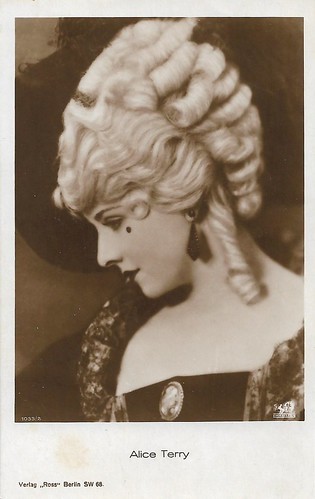
German postcard by Ross Verlag, no. 1033/2. Photo: Phoebus Film. Alice Terry in Scaramouche (Rex Ingram, 1923).
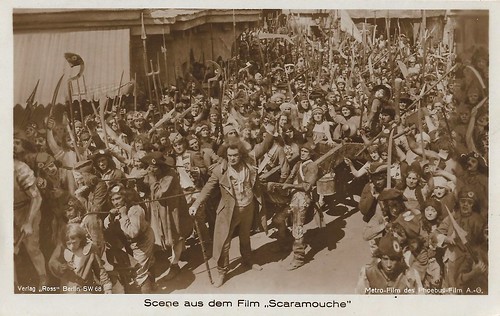
German postcard by Ross Verlag. Photo: Metro / Phoebus. A scene from Scaramouche (Rex Ingram, 1923), depicting the French Revolution: Danton (George Siegmann) leading the mob.

Italian postcard by Ballerini & Fratini, Florence, no. 426. Photo: Metro-Goldwyn, Roma. Antonio Moreno and Alice Terry in Mare Nostrum (Rex Ingram, 1926).

Romanian postcard. Antonio Moreno and Alice Terry in Mare Nostrum (Rex Ingram, 1926).
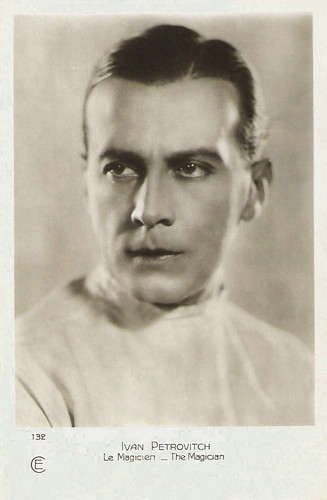
French postcard by Cinémagazine-Edition, no. 132. Photo: Ivan Petrovich in The Magician (Rex Ingram, 1926).
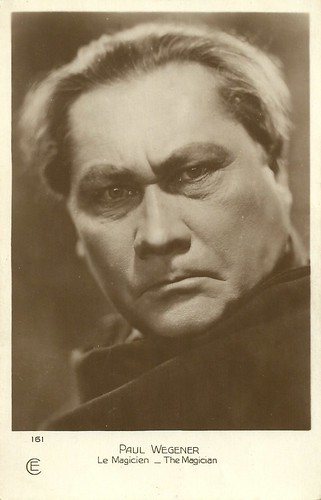
French postcard by Editions Cinémagazines, no. 161. Paul Wegener in The Magician (Rex Ingram, 1926).
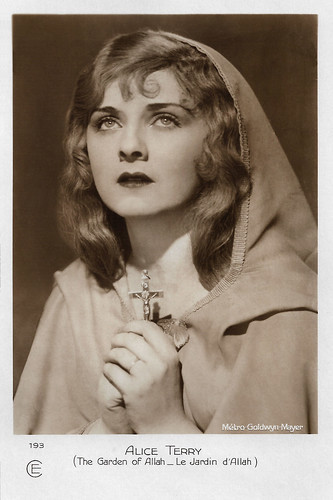
French postcard by Editions Cinémagazine, no. 193. Photo: Metro-Goldwyn-Mayer. Alice Terry in The Garden of Allah (Rex Ingram, 1927).
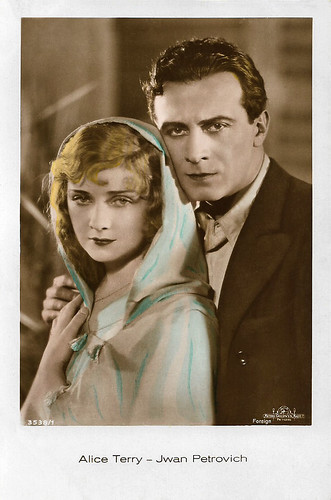
British postcard by Ross Verlag, no. 3538/1. Photo: Metro-Goldwyn-Mayer. Alice Terry and Ivan Petrovich in The Garden of Allah (Rex Ingram, 1927).
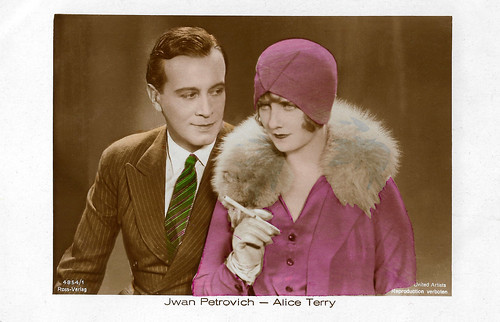
German postcard by Ross Verlag, no. 4854/1, 1929-1930. Photo: United Artists. Ivan Petrovich and Alice Terry in The Three Passions (Rex Ingram, 1928). Collection: Geoffrey Donaldson Institute.
Sources: Book, Brian McIlroy (Estudiosirlandeses), Stephen Totterdell (Film Ireland), Rex Ingram website, Wikipedia and .

Book cover for Ruth Barton, 'Rex Ingram - Visionary director of the silent screen' (2014). Publisher: University Press of Kentucky.

British postcard in the Picturegoer Series, London, no. 137.

Rex Ingram and Alice Terry. German postcard by Ross Verlag, Berlin, no. 807/1, 1925-1926. Photo: Bafag.

Italian postcard by Ed. A. Traldi, no. 88. Photo: Le grandi films Virginio Rebua, Milano. The postcard claims this is Ramon Novarro, but it is Rex Ingram. Ingram directed Novarro in various early 1920s films, such as The Prisoner of Zenda (1922), Where the Pavement Ends (1923), Scaramouche (1923), and The Arab (1924).

British postcard in the Picturegoer Series, London, no. 137a.
A fascination for the bizarre and the grotesque
Rex Ingram was born in 1893 as Reginald Ingram Montgomery Hitchcock in Rathmines, now part of Dublin, Ireland. He spent much of his adolescence living in the Old Rectory, Kinnitty, Birr, County Offaly where his father was the Church of Ireland rector. When the sensitive Rex was 15, his sickly mother died. Biographer Ruth Barton suggests that this lead to his later portraying women as either pure-hearted souls or tempting sirens. Barton had access to Ingram's memoirs which gave her insight into his life. Her book focuses on telling the compelling narrative of Ingram’s life and links it often with his work.
Ingram's father tried to push him into business, but Rex wanted to be an artist. After failing to get into Trinity College Dublin, much to his father’s shame, he emigrated in 1911 to the United States. He was 18 and studied briefly sculpture at the Yale University School of Art, where he also contributed to The Yale Record, a campus humour magazine. In New York, Rex met the son of inventor and film pioneer Thomas Edison, and he decided to move into the new movie business. From 1913, the handsome young Irishman acted in silent films for the Edison studios, and in 1915, he took his mother’s name, Ingram, as his surname. So interestingly he changed his name Hitchcock in order to break into the cinema. Barton however suggests that the name change was meant as a firm break with his father's ambitions for him.
After Edison, he worked with legendary director D.W. Griffith at the Biograph Studios for a while. Ingram later also worked for Vitagraph, Fox and Universal. Soon he took on writing, producing and directing jobs, directing mainly action or supernatural films. His first film as producer-director was the romantic drama The Great Problem (Rex Ingram, 1916) with Violet Mersereau. In his following films such as Black Orchids (Rex Ingram, 1917) with Cleo Madison, The Little Terror (Rex Ingram, 1917) and The Flower of Doom (Rex Ingram, 1917), he showed a fascination for the bizarre and the grotesque.
In 1920, Rex Ingram moved to Metro. There, he was under supervision of executive June Mathis. Together, they hired young Italian immigrant dancer Rudolph Valentino to star in The Four Horsemen of the Apocalypse (Rex Ingram, 1921) opposite Alice Terry. Valentino's film's sizzling tango sequence turned the film into a smash hit. Mathis and Ingram would make four films together, also Hearts are Trump (Rex Ingram, 1920) again with Alice Terry, The Conquering Power (Rex Ingram, 1921) with Valentino and Terry, and Turn to the Right (Rex Ingram, 1922).
After Valentino left Metro for Paramount, Rex Ingram needed a new leading man, and took a chance on a young, handsome Mexican, who would become Ramon Novarro . With his role as the villain Rupert von Hentzau in The Prisoner of Zenda (Rex Ingram, 1922) he became Ingram's new star. Ingram also gathered a steady technical crew around him. Very important for his films would be cameraman John Seitz, who invented the matte painting. Also very important for Ingram's films was his editor, Grant Whytock.
Ruth Barton describes how Ingram and his crew worked. The Prisoner of Zenda features careful lighting, well-placed props, and a novel 3-D effect. In one shot, two soldiers drink and play cards. Behind them, to the right, a military statue stands out, in focus. Still farther back in the room, and to the left, a young man plays piano. It is Ramon Novarro . Almost a painting, the effect is multi-dimensional.
On 5 November 1921, Ingram and Alice Terry were married in Adobe Flores in South Pasadena. It was on a Saturday and they sneaked off the set of The Prisoner of Zenda (Rex Ingram, 1922) without telling anyone. The next day they saw three films and went back to work on Monday. When the film was completed, they went to San Francisco for their honeymoon. Ruth Barton speaks of his rumoured bisexuality, but it remains unconfirmed. In his work you can see undertones of what was probably an actively bisexual life.
Ingram's films contain splendid flashes of macabre fantasy, such as the ride of the Four Horsemen in the Valentino epic, or the 'ghoul visions' that bring about the death of the miser in The Conquering Power (Rex Ingram, 1921). His more or less mystical bent was later apparent in Mare Nostrum (Rex Ingram, 1926) and The Garden of Allah (Rex Ingram, 1927), which he filmed in the Mediterranean and North Africa, respectively.

Spanish collectors card by Chocolate Amatller, Series EE, Artist 40, no. 82.

Spanish collectors card by Chocolate Amatller, Series EE, artist 41, no. 83. Lewis Stone In The Prisoner of Zenda (Rex Ingram, 1922).

German postcard by Ross Verlag, no. 748/1. Photo: Bafag. Rudolph Valentino and Alice Terry in The Conquering Power (Rex Ingram, 1921).

German postcard by Ross Verlag, no. 679/4. Lewis Stone as Rudolph Rassendyll and Alice Terry as Princess Flavia in The Prisoner of Zenda (Rex Ingram, 1922). Stuart Holmes is the man in black on the right. The Bismarck-like guy behind Terry is the actor Robert Edeson, who plays Colonel Sapt. Behind him is actor Malcolm McGregor, who plays Captain Fritz von Tarlenheim. Both are the loyal aids of the King, defending him against his evil half-brother Michael (Stuart Holmes) and his plotting cronies: his mistress Antoinette (Barbara la Marr) and Rupert von Hentzau ( Ramon Novarro ). Trying to stop a coup by Michael, who has abducted and imprisoned the real king, Sapt and Tarlenheim arrange a lookalike cousin of the king to be crowned (which we see on this card). The substitute king falls in love with Princess Flavia but he cannot tell the truth... Stone played both the King and his lookalike.

Italian postcard by G.B. Falci, Milano, no. 447. Ramon Novarro and Alice Terry in the Metro Pictures production Scaramouche (Rex Ingram, 1923).

Italian postcard by G.B. Falci, Milano, no. 457. Ramon Novaro in Scaramouche (Rex Ingram, 1923).
Converting to the Islam
In 1923, the restless Rex Ingram and Alice Terry relocated to the French Riviera. They hired the Victorine Studio, a small studio in Nice and made several films on location in North Africa, Spain, and Italy for MGM and other studios. Outside the view of the movie moguls he created such films as Mare Nostrum (Rex Ingram, 1926), The Garden of Allah (Rex Ingram, 1927) and The Three Passions (Rex Ingram, 1929).
Amongst those who worked for Ingram at MGM on the Riviera during this period was the young Michael Powell, who later went on to direct (with Emeric Pressburger) The Red Shoes (1948) and other classics, and technician Leonti Planskoy. By Powell's own account, Ingram was a major influence on him, especially in its themes in illusion, dreaming, magic and the surreal. Also director David Lean said he was indebted to Ingram. And MGM studio chief Dore Schary listed the top creative people in Hollywood as D. W. Griffith, Ingram, Cecil B. DeMille and Erich von Stroheim (in declining order of importance). Von Stroheim however called Ingram the "world's greatest director..."
In 1926, Ingram made The Magician, starring Paul 'Der Golem' Wegener . Although Wegener's acting was already old-fashioned, Ingram slowly builds the film to a rousing climax. Flashing lightning surrounds an old castle, where the magician battles the young hero ( Ivan Petrovich ). Earlier, the young heroine (Alice Terry) is transported to an underworld dream-land, complete with Pan, the Devil, and a host of partially dressed dancers. The Magician was successful, but Louis B. Mayer ended Ingram's career at MGM.
Was Ingram the dangerous maverick which Mayer saw in him? Or was he the true visionary, as Ruth Barton claims. To be honest, I can't judge this while I did not see enough films by Ingram yet. During the 1920s, film critics praised the pictorial qualities of his work but also commented on the lack of dramatic pacing and the unrounded characterisation. Barton convinced me that Ingram was a complex figure who cannot be easily categorised. His temperament was volatile and his working periods at the various studios were short. Invariably, he fell out with superiors and co-workers. Barton describes him as a charming, talented but also difficult and demanding artist. The more earth-bound Alice Terry kept the tyrannical perfectionist on track. She even co-directed his films in difficult periods.
The coming of sound forced Ingram to relinquish his studios in Nice. Rather than equip them for talking pictures, he chose instead to travel and pursue a writing career. Rex Ingram made only one sound film, Baroud/Love in Morocco (Rex Ingram, Alice Terry, 1932-1933) with Pierre Batcheff , filmed for Gaumont British Pictures in Morocco. The film was not a commercial success and Ingram, only forty years old, left the film business. He returned to Los Angeles to work as a sculptor and writer.
Interested in Islam as early as 1927, Rex Ingram converted to the faith in 1933. He spent his later years travelling across the wind-swept North African desert, often alone. He also became an avid collector of ancient artifacts. In his last years he also planned a biography on the life of Haitian leader Toussaint, but it was never filmed. Ironically, Sergei M. Eisenstein, who was planning a biopic on Toussaint, also didn't make his film.
Suffering from high blood pressure, Rex Ingram died in 1950 of a cerebral hemorrhage in North Hollywood, at the age of 58. He was interred in the Forest Lawn Memorial Park Cemetery in Glendale, California. Ingram married twice, first to actress Doris Pawn in 1917; this ended in divorce in 1920. He then married Alice Terry in 1921, with whom he remained for the rest of his life. Both marriages were childless. Terry inherited his estate of $200,000, including rare art works, old swords, and ancient guns.
For his contribution to the motion picture industry, Rex Ingram has a star on the Hollywood Walk of Fame at 1651 Vine Street. And there is this insightful and entertaining biography by Ruth Barton, it's a joy to read.

German postcard by Ross Verlag, no. 1033/2. Photo: Phoebus Film. Alice Terry in Scaramouche (Rex Ingram, 1923).

German postcard by Ross Verlag. Photo: Metro / Phoebus. A scene from Scaramouche (Rex Ingram, 1923), depicting the French Revolution: Danton (George Siegmann) leading the mob.

Italian postcard by Ballerini & Fratini, Florence, no. 426. Photo: Metro-Goldwyn, Roma. Antonio Moreno and Alice Terry in Mare Nostrum (Rex Ingram, 1926).

Romanian postcard. Antonio Moreno and Alice Terry in Mare Nostrum (Rex Ingram, 1926).

French postcard by Cinémagazine-Edition, no. 132. Photo: Ivan Petrovich in The Magician (Rex Ingram, 1926).

French postcard by Editions Cinémagazines, no. 161. Paul Wegener in The Magician (Rex Ingram, 1926).

French postcard by Editions Cinémagazine, no. 193. Photo: Metro-Goldwyn-Mayer. Alice Terry in The Garden of Allah (Rex Ingram, 1927).

British postcard by Ross Verlag, no. 3538/1. Photo: Metro-Goldwyn-Mayer. Alice Terry and Ivan Petrovich in The Garden of Allah (Rex Ingram, 1927).

German postcard by Ross Verlag, no. 4854/1, 1929-1930. Photo: United Artists. Ivan Petrovich and Alice Terry in The Three Passions (Rex Ingram, 1928). Collection: Geoffrey Donaldson Institute.
Sources: Book, Brian McIlroy (Estudiosirlandeses), Stephen Totterdell (Film Ireland), Rex Ingram website, Wikipedia and .
Published on August 28, 2019 22:00
Paul van Yperen's Blog
- Paul van Yperen's profile
- 13 followers
Paul van Yperen isn't a Goodreads Author
(yet),
but they
do have a blog,
so here are some recent posts imported from
their feed.



